 Vol. 42, No. 1 Winter 2020 $8.00
Macon Arsenal 10-Pounder Parrott Rifle: The Search for Its Battery • Rifled Artillery Against Fort Pulaski
French Swiss Guard Regiment 6-Pounder Gun • The Tom Dickey Collection
Russian Guns in La Belle France • Confederate Dahlgren Shells
Vol. 42, No. 1 Winter 2020 $8.00
Macon Arsenal 10-Pounder Parrott Rifle: The Search for Its Battery • Rifled Artillery Against Fort Pulaski
French Swiss Guard Regiment 6-Pounder Gun • The Tom Dickey Collection
Russian Guns in La Belle France • Confederate Dahlgren Shells
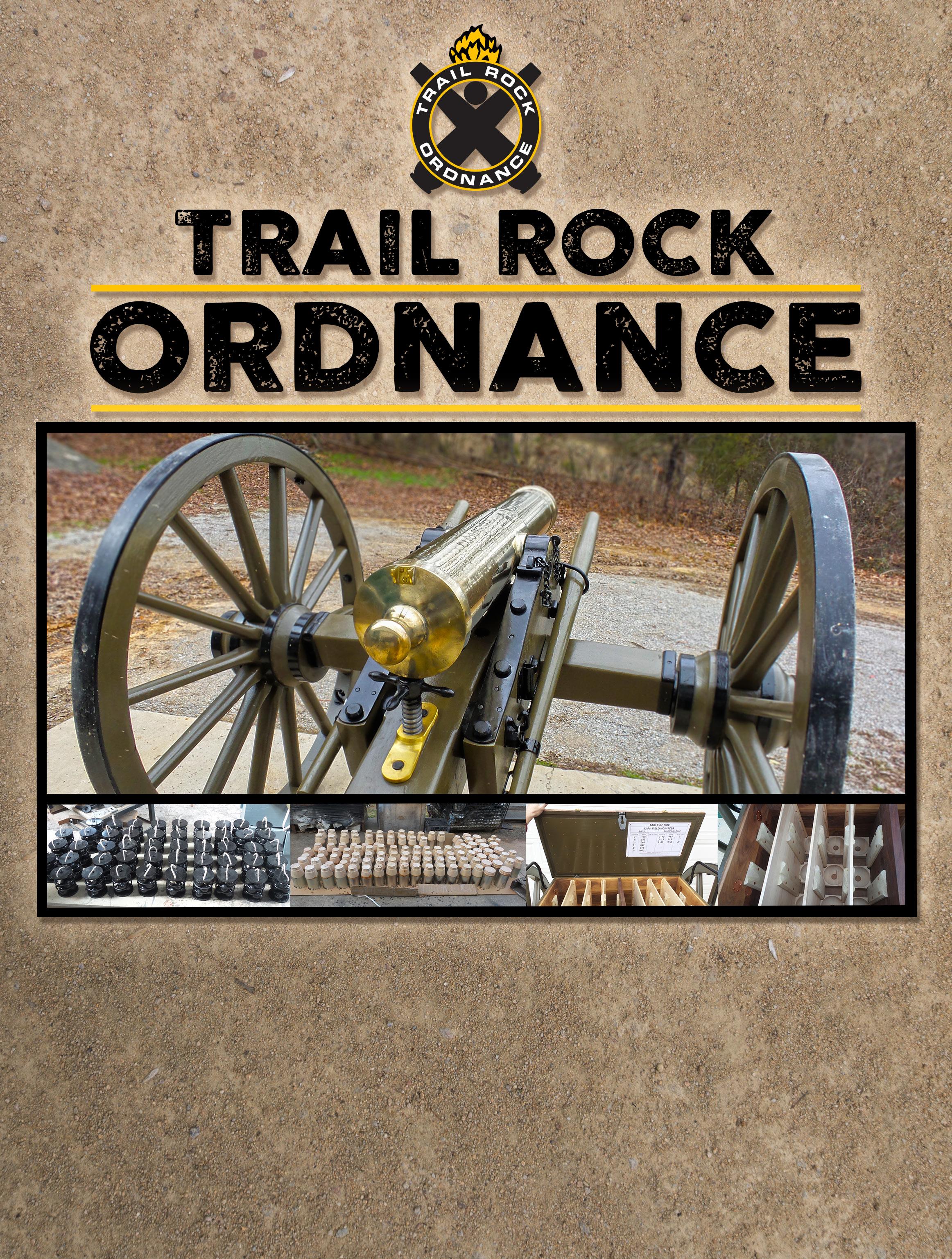


CARRIAGE HARDWARE FOR: #1 and #2 Field Carriage, Field Limber & 1st Model Prairie Carriage COMPLETE CARRIAGES - IN STOCK & READY TO SHIP Implements • Artillery Ammunition • Sabots & Shooting Accessories Ammunition Shipping Boxes • Artillery Harness • Other Artillery Goodies 1754 Little Valley Road Blaine, TN 37709 Ph: (865) 932-1200 • Fax: (865) 932-1200 • akm556@aol.com www.TrailRockOrdnance.com
Asheville Gun & Knife Show
WNC Ag Center 1301 Fanning Bridge Road
Fletcher, NC
Jan. 9 & 10, 2021
Myrtle Beach Gun & Knife Show

Myrtle Beach Convention Center 2101 North Oak Street
Myrtle Beach, SC
Feb. 6 & 7, 2021
Charleston Gun & Knife Show

Exchange Park Fairgrounds 9850 Highway 78
Ladson, SC 29456
Feb. 20 & 21, 2021
Asheville Gun & Knife Show
WNC Ag Center 1301 Fanning Bridge Road Fletcher, NC
March 6 & 7, 2021
Chickamauga (Dalton)

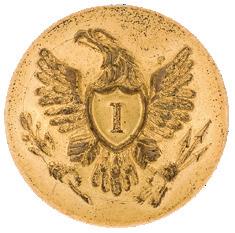


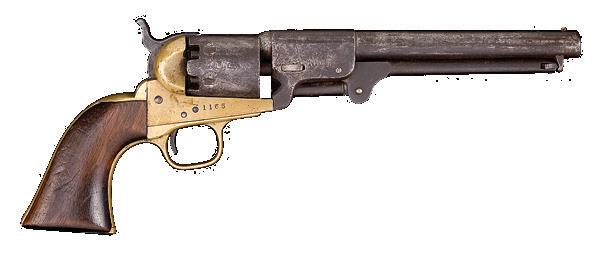
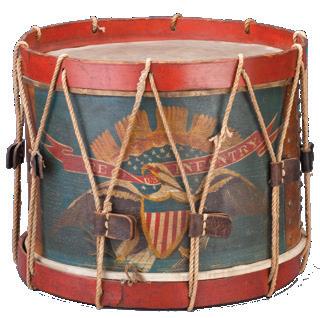
Civil War Show
Northwest Georgia Trade Center 2211 Dug Gap Battle Road
Dalton, GA 30720
Jan. 30 & 31, 2021
Capital of the Confederacy
Civil War Show
Richmond International Raceway 600 East Laburnum Avenue
Richmond, VA 23222
Nov. 13 & 14, 2021
Middle TN (Franklin)
Civil War Show

4215 Long Lane
Franklin, TN 37064
Promoters of Quality Shows for Shooters, Collectors, Civil War and Militaria Enthusiasts Military Collectible & Gun & Knife Shows Presents The Finest
War Civil War World War I & II Modern Gun & Knife Shows Mike Kent and Associates, LLC • PO Box 685 • Monroe, GA 30655 (770) 630-7296 • Mike@MKShows.com • www.MKShows.com
Rev
Expo Park
Williamson County Ag
Dec. 4 & 5, 2021
l l l l
Scan for current show schedules
6 CONFEDERATE DAHLGREN SHELLS
Extremely rare Confederate manufactured Dahlgren shells. By Jack Bell.
12 RIFLED ARTILLERY AGAINST FORT PULASKI
The effects of rifled artillery against masonry forts. By John C. Whatley.
22
24
NEWS FROM THE U.S. ARMY ARTILLERY MUSEUM

Recent events at the U.S. Army Artillery Museum in Fort Sill. By Gordon A. Blaker.
MACON ARSENAL 10-POUNDER PARROTT RIFLE – SERIAL NO. 8: THE SEARCH FOR ITS BATTERY
Searching the Official Records and National Archives for a rare Confederate cannon. By Ken Knoll and Kerry Gossett.
32 JOHN C. TIDBALL AND HIS PRESENTATION SWORD
A beautiful Tiffany & Co. presentation sword and history of its owner. By Gordon Blaker.
40 FRENCH SWISS GUARD REGIMENT 6-POUNDER GUN
A new acquisition by the U.S. Artillery Museum and its uniqueness. By Becky Coffield.
46 THE TOM DICKEY COLLECTION
Tom Dickey collection photographs of his relic room and his display today. By Dr. Gordon Jones.
60 RUSSIAN GUNS IN LA BELLE FRANCE
Russian cannon high atop Corneille Rock By Yuriy Kirpichoff.
On the cover: Fair Oaks, Virginia, vicinity. Photograph taken by James F. Gibson on June 1, 1862, of the officers of Battery A, 2nd U.S. Artillery posing in front of their U.S. 3-inch ordnance rifle, serial number 247, dated 1862. The wrought iron tube weighed 816 pounds and was inspected by ordnance officer Theodore T. S. Laidley (TTSL initials stamped into the muzzle).
From left to right: Lieutenant Robert Clarke, Captain John Caldwell Tidball, Lieutenant William Neil Dennison, and Captain Alexander Cummings McWhorter Pennington. This rifled cannon would have fired 3-inch caliber Archer, Broun, Dyer, Hotchkiss, Read, and Schenkl projectiles to name a few.
© 2015 colorized image courtesy CivilWarInColor.com. Original image courtesy Library of Congress.
NEW: Digital subscriptions for The Artilleryman magazine from Vol. 1, No. 1 to the current issue available soon. The first 20 years, and every issue from Summer 2015 to current are now online as a subscription. Go to www.ArtillerymanMagazine.com and click on Digital link to subscribe.
| Winter 2020 | Vol. 42, No. 1
The Artilleryman
CONTENTS
The Artilleryman 2
Consultants:
Lawrence Babits, Ph.D., Thomas Bailey, Craig D. Bell, Jack Bell, Jim Bender, Col. John Biemeck (Ret.), Leonard Draper, Glenn Dutton, Tom Gersbeck, David Gotter, Richard W. Hatcher III, Butch & Anita Holcombe, Les Jensen, Gordon L. Jones, Ph.D., Mike Kent, Lewis Leigh Jr., William E. Lockridge, Donald Lutz, John Morris, Hayes Otoupalik, Bernie Paulson, Bruce Paulson, Charlie Smithgall, Matthew Switlik, Bill Tracy, and Mike Ward.
Black Powder Explosive Ordnance Assistance
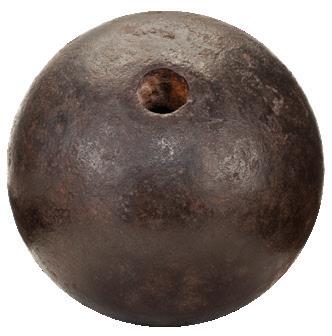
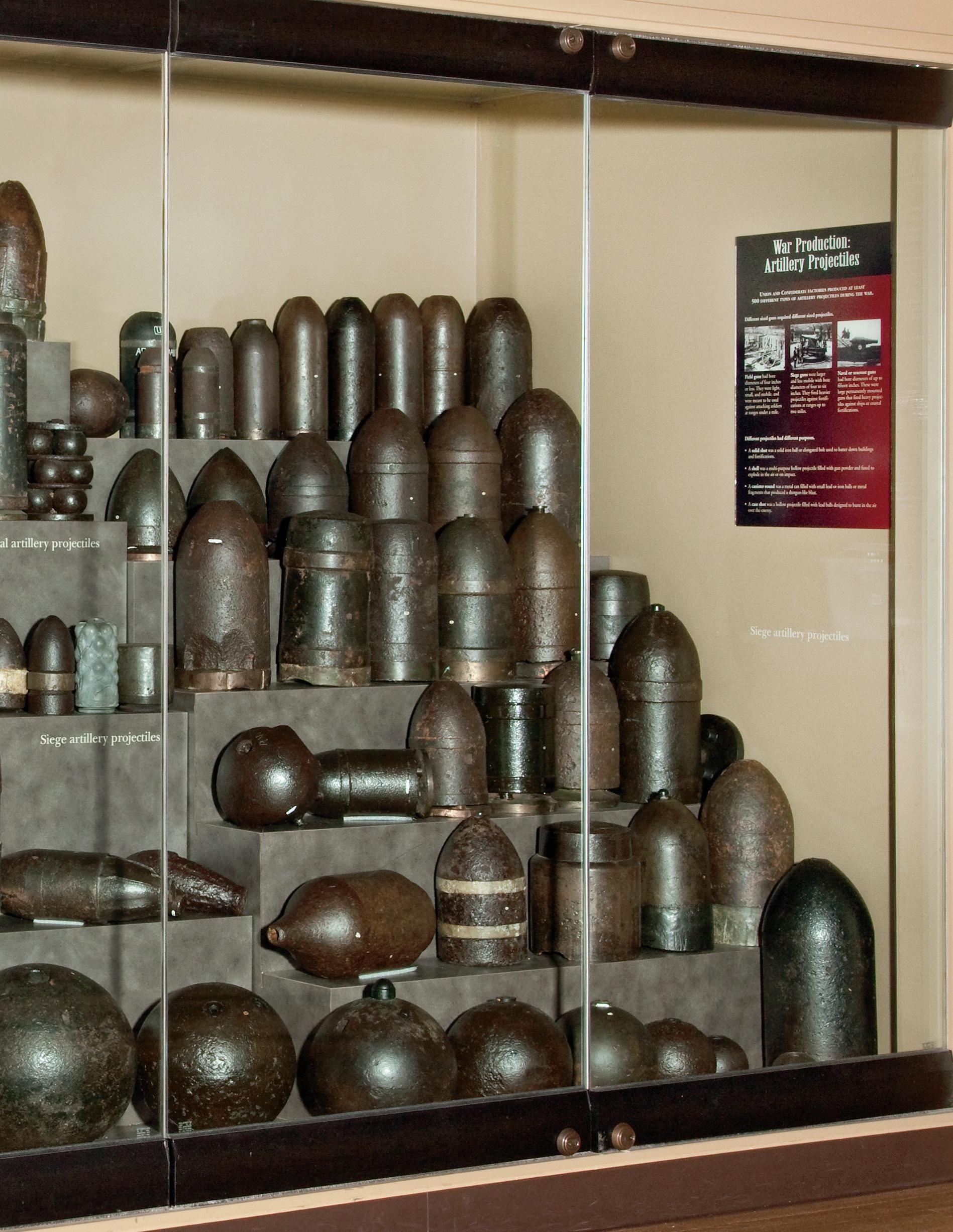
Contact Col. John Biemeck, Ordnance Corps, U.S. Army (Retired), cell 804-366-0562.
Black Powder Explosive Ordnance Assistance (Identification, threat assessment, handling, storage, technical and deactivation assistance) for Government, State and Municipal Agencies. This service is offered as a courtesy to government agencies by The Artilleryman in an effort to preserve antique explosive black powder projectiles for future generations.
Printed proudly and responsibly in the United States of America. All rights reserved under International and PanAmerican Copyright Conventions. No part of this magazine may be reproduced in any form or by any electronic, digital or mechanical means, screen shots, phone photos, including information storage and retrieval systems, without permission in writing from the publisher, except by a reviewer who may quote brief passages in a review.
The information contained herein is for the general history and background of our readers and The Artilleryman assumes no liability for loading or shooting data which may be published in this magazine. The circumstances surrounding the loading and discharge of firearms mentioned are beyond our control and are unique to the particular instance being described. We hereby disclaim any responsibility for persons attempting to duplicate loading data or shooting conditions referenced herein and specifically recommend against relying solely on this material. Readers are cautioned that black powder varies according to grain size, type, date of manufacture and supplier, and that firing of antique or replica ordnance should not be undertaken without adequate training and experience in procedures and loads.
Articles, Photographs and Image Submittals:
The Author(s), Photographer(s) will indemnify the Publisher against any loss, injury, or damage (including any legal costs or expenses and any compensation costs and disbursements paid by the Publisher) occasioned to the Publisher in connection with or in consequence or any breach of the Author’s warranties and which the Publisher is not able to recover. Author agrees to allow Publisher to re-print any work submitted.
Publisher: Jack W. Melton Jr.
Founding Publisher: C. Peter Jorgensen
Editor: Larry Babits
Book Reviews: Peter A. Frandsen
Advertising: mail@ArtillerymanMagazine.com
Webmaster: Carson Jenkins Jr.
Graphic Designer: Squeegie Studios
InDesign Guru: Neil Stewart
Contact Information:
Historical Publications LLC
The Artilleryman
2800 Scenic Dr, Suite 4 PMB 304 Blue Ridge, GA 30513
800-777-1862
Email: mail@artillerymanmagazine.com
Website: ArtillerymanMagazine.com
Hours 9-5 EST, Monday-Thursday
The Artilleryman Magazine (ISSN:088404747)Copyright © 2020, All Rights Reserved, by Historical Publications LLC is published quarterly by Historical Publications LLC, 2800 Scenic Dr, Suite 4 PMB 304, Blue Ridge, GA 30513. Quarterly. Business and Editorial Offices: 2800 Scenic Dr, Suite 4 PMB 304, Blue Ridge, GA 30513, Accounting and Circulation Offices: Historical Publications LLC, 2800 Scenic Dr, Suite 4 PMB 304, Blue Ridge, GA 30513. Call 800-777-1862 to subscribe. Application to mail at Periodicals postage prices at Charleston, SC, and additional mailing offices (if applicable).
Contributions of editorial material and photographs are welcomed at the above address.
Subscription rates: $37.95 for a one-year U.S.A. subscription and $75.90 for a two-year in U.S.A. International subscriptions no longer accepted. US. bankchecksorcreditcardsaccepted. Subscribe
by calling 800-777-1862 or online at
www.ArtillerymanMagazine.com
ArtillerymanMagazine.com | Vol. 42, No. 1 3
Jack W. Melton Jr. Publisher

DIGITAL MAGAZINES:
Digital subscriptions for back issues of The Artilleryman magazine from Vol. 1, No. 1 to the current issue, will be available soon. The first twenty years of the publication and every issue from Summer 2015 to present, are now available as an online, yearly digital subscription. Over 6,500 pages of artillery information available on your phone, tablet, or computer. By the end of Summer 2020, this project will be entirely up to date, with over 160 issues online.
If you are a student of artillery, a historian, researcher, author, or just interested in the hobby, you’ll find plenty of information within this massive archive.
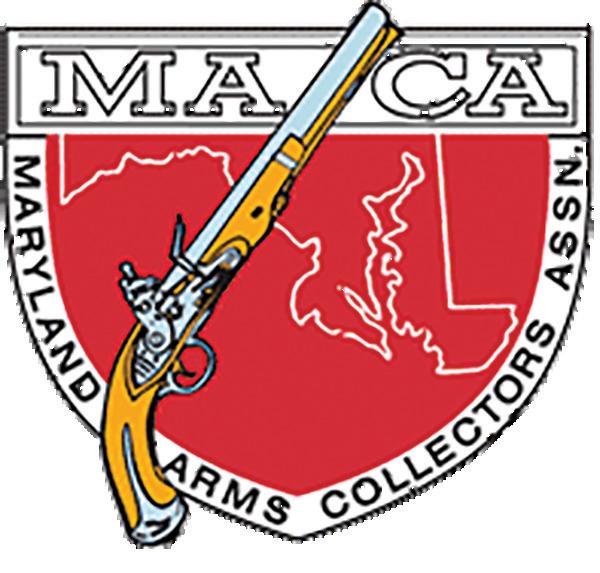
Visit ArtillerymanMagazine.com and click on Digital link to subscribe, or if you have an existing subscription the cost is only $14.95/year for digital access. Call us at 800-777-1862 to add that to your current subscription.
Back issues of The Artilleryman magazine are available online at www. historicalpublicationsllc.com. If you want more than one back issue please call us at 800-777-1862 or email us at mail@artillerymanmagazine.com for a shipping quote.
Letters to the Editor: Please email your responses to mail@ artillerymanmagazine.com or mail to:



Historical Publications LLC
2800 Scenic Dr, Suite 4-304
Blue Ridge, GA 30513
The Artilleryman
Note: The Spring 2021 issue will have a special article on the Thomas Swift Dickey Collection’s “Baby Shell” collection. Never before published in this detail.
Subscribe online at: ArtillerymanMagazine.com Historical Publications LLC, 2800 Scenic Dr Suite 4 PMB 304, Blue Ridge, GA 30513 Phone: 800-777-1862 • mail@artillerymanmagazine.com The Maryland Arms Collectors Assoc., Inc. presents The “Original Baltimore” Antique Arms Show Since 1955 Maryland State Fairgrounds Timonium, MD North of Baltimore, York Road, MD. - Rt. 45 1,000 8-Foot Tables March 20-21, 2021 Public Hours: Sat. 9 to 5, Sun. 9 to 3. Admission: $10.00 –Moder n Handguns are Prohibited –Complete information on web site: www.baltimoreshow.com Or Call 443-497-9253 Known as the “CROWN JEWEL” of Collector’s
Shows!
NEW
4
Civil War Artillery Projectiles –The Half Shell Book
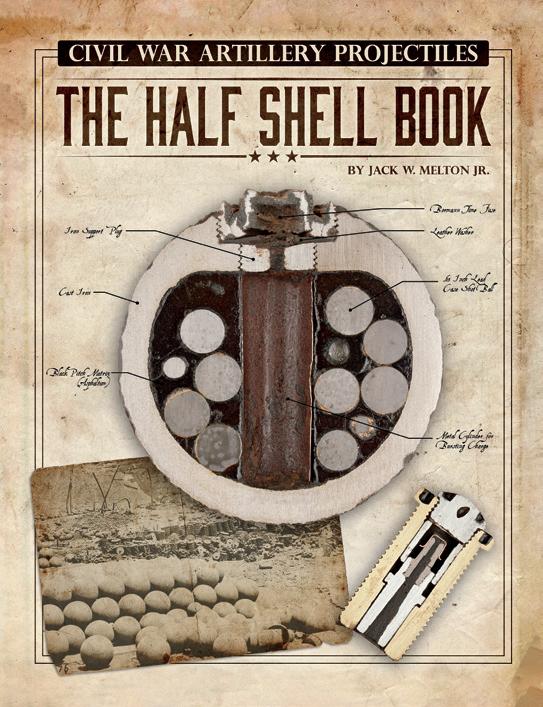
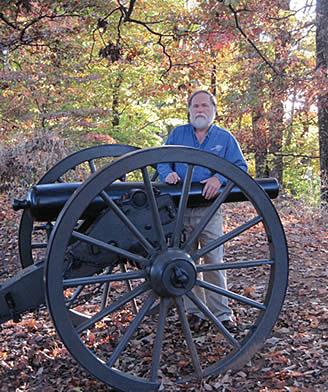 by Jack W. Melton Jr.
by Jack W. Melton Jr.
Where “Hard-to-Find” becomes easy. For generations, re-enactors, modern hunters and competitive shooters have looked to the DIXIE GUN WORKS’ catalog for the hardest to find blackpowder items. Our all new 2021 catalog continues the tradition with the world’s largest selection of blackpowder replica arms, accessories, antique parts, muzzleloader hunting and sport shooting



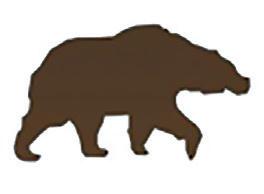
Artillery
1017 Russwood Drive • Knoxville, TN 37920 Email: ken.creswell@comcast.net No. 1 Field Carriage Irons, Field Limber Irons, Field Ammo Chest Irons, 1st Model Prairie, No. 2 Field Carriage Irons & Misc Parts Carriage Parts Ltd www.cannonpartsltd.com (865)573-8045
Powder
in 1F – 4F, cannon grade (mixed cases upon request) American made Visco cannon fuse New Distribution location added: John Van Paepeghem – Nampa, Idaho 208-484-5890 – flintsaver@gmail.com Craig Kirkland – GOEX Master Distributor 307-679-0886 – bearriverpowder@allwest.net Bear River Powder PO Box 2853 Evanston, WY 82931 DIXIE GUN WORKS, INC. 1412 W. Reelfoot Avenue PO Box 130 Dept.
Union City, TN 38281 INFO PHONE: (731)
FAX: (731) 885-0440 EMAIL: info@dixiegunworks.com
Works, Inc.
Irons – Cast Steel
Bear River Powder GOEX Black
Available
66
885-0700
Gun
PROFESSIONAL SERVICE AND EXPERTISE GUARANTEED STILL ONLY $5.00
ITEMS
ONLINE! www.dixiegunworks.com
credit cards accepted
ORDERS
equipment.
VIEW
AND ORDER
Major
FOR
ONLY (800) 238-6785
Online
ArtillerymanMagazine.com | Vol. 42, No. 1 5
Order
at ArtillerymanMagazine.com See advertisement in this magazine.
by Jack Bell

At the outset of the Civil War, both Union and Confederate forces struggled with the urgent need to develop the new rifled artillery technology and capability that was just arriving. Apparently, only the West Point Foundry under Robert Parrott produced and sold rifled cannon (in 2.9 & 3.3-inch calibers) and projectiles in 1860 and early 1861.1 Soon after the war began, a number of private local Confederate foundries began casting field-caliber rifled cannon, including John Clark and Co., Cameron and Co., Leeds and Co., Noble Bros and Co., Quinby and Robinson, Reading and Co., Skates and Co., and Tredegar Foundry.
Confederate artillery designers had no experience designing heavy rifled cannon or projectiles. For Lieutenant John Brooke, the Confederate Navy’s leading ordnance officer, the challenge was particularly urgent. He was attempting to design heavy rifled cannon and projectiles for the new ironclad CSS Virginia. It was being built up on the hulk of the USS Merrimack after it was burned and sunk by the Union Navy when it abandoned its base in Gosport, Va., (near Portsmouth) on April 20, 1861.
Early research speculat ed t hat Brooke may have obtained a copy of Dahlgren’s shell patent data for his projectile design effort. However, recent research confirms that Brooke was actually shown an unexploded Dahlgren shell in Richmond on June 28, 1861, almost six weeks before Dahlgren received his patent on August 6, 1861.2
Brooke was still struggling with projectile design issues as late as November 1861, when he ordered 200 shells in a modified Dahlgren pattern design from Tredegar Foundry.3 As fielded, Brooke’s Dahlgren-inspired design maint ained Dahg ren’s leadbased sabot on both his 6.4-inch and 7-inch shells.
Known surviving C.S. Dahlgren shells are rare and, with two exceptions, are recoveries from the Hampton
Roads area, and from the Charleston, S.C., theater of operations.
One 6.4-inc h C.S Dahlgren shell is in t he Naval Academy Museum c ollection. T he s hell i s engraved “S HELL FIRE D FROM A CONFE DERATE S TEAMER LODGED IN THE QUARTERS OF GEN MANSFIELD COMMANDING AT NE WPORT NE WS D URING THE ATTACK ON THE CONGRESS AND CU MBERLAND M ARCH 8, 1 862.” 4 T he o ther o ne (w ithout known provenance) is in the Military Academy’s museum. A few years ago, a 7-inch C.S. Dahlgren shell was positively identified as having been recovered on the shore in Hampton, Va., fired from the CSS Virginia during its attack on the USS Cumberland on March 8, 1862.5
Two other 6.4-inch shells may also be of Brooke’s C.S. Dahlgren design. Earlier, they were tentatively identified as a Tredegar early-war design.6 Both have lead sabot attachment configurations different from the other two 6.4-inch C.S. Dahlgren shells. However, one has an iron shell body design identical to the known C.S. Dahlgren s hells and is engraved , “REBEL SHELL FROM CRANEY ISLAND, MAY 1862.” The location and dating of the firing from Craney Island strongly suggests they are Brooke’s C.S. Dahlgren shells. Craney Island protected t he Hampton Roads entrance to the Elizabeth River and the Gosport Confederate Navy base that was abandoned later that month.
The only other known 6.4-inch C.S. Dahlgren shells were reportedly recovered unfired in the Vicksburg area.7 They may have been supplied early for the Confederate defenses there, although the major Vicksburg battles came a year later. These are the only known surviving 6.4-inch C.S. Dahlgren shells.
The original Union Dahlgren projectile design with lead sabots continued to be used until the end of the war. However, the shortage of lead in the Confederacy and other factors led
Brooke and other Confederate projectile designers to shift to using iron and copper sabots.8 Brooke tested his well-known ratchet disk sabot in October 1862, and the design was fielded in December 1862. It is significant that the first mention of the copper Tennessee sabot design9 occurred in late January 1862, when Lt. Catesby Jones sent a letter to Brooke stating “it was the best shell we tried.”10
Endnotes:

1. Ironically, the first Parrott rifled cannon sales were in 1860 to Thomas Jonathon Jackson (later “Stonewall”), then a professor at the Virginia Military I nstitute (VM I). A pparently Jackson bought 13 rifled guns of the 3.3-inch caliber with saw tooth rifling. Later, in May and June 1861, Parrott sold other 3.3-inch rifles to the Union Committee of New York. The first 2.9inch Parrott rifled cannon sales were credited in May 1861. Phoenix Iron Co. followed soon thereafter, receiving an order in July 1861 for 300 3-inch ordnance rifles.
2. Ironclads and Big Guns of the Confederacy, by George M. Brooke Jr., p. 25.
3. Ibid., p. 51.
4. Civil War Heavy Explosive Ordnance for a photograph, p. 216.
5. The Artilleryman Magazine, Spring 2016, pps. 14-20.
6. Civil War Heavy Explosive Ordnance , pps. 442-443.
7. Ibid., p. 215.
8. A few other shells of later Confederate shell designs continued to use lead sabots, including the “Eason-Britten“ shells used in Charleston, and a unique late-war 8-inch C.S. Parrott bolt.
9. Strong evidence indicates that the designer of the Tennessee sabot was Captain Lardner Gibbon, who also designed the Gibbon and Andrews 4.62inch rifled cannon.
10. Ironclads, Brooke, p. 62.
Jack Bell is the author of Civil War Heavy Explosive Ordnance, a reference guide for collectors and curators on large artillery
ArtillerymanMagazine.com | Vol. 42, No. 1 7
projectiles and mines. He is a long-time collector and researcher on Civil War artillery and history since his first relic hunting trip with Tom Dickey in 1952. In his “other” life, Jack has served as a Marine in Vietnam, a private industry
executive, and a senior executive in the Department of Defense and the State Department, with extensive work in Iraq and Afghanistan. Jack and his wife Gin live in Washington, D.C.
Confederate Dahlgren Shells
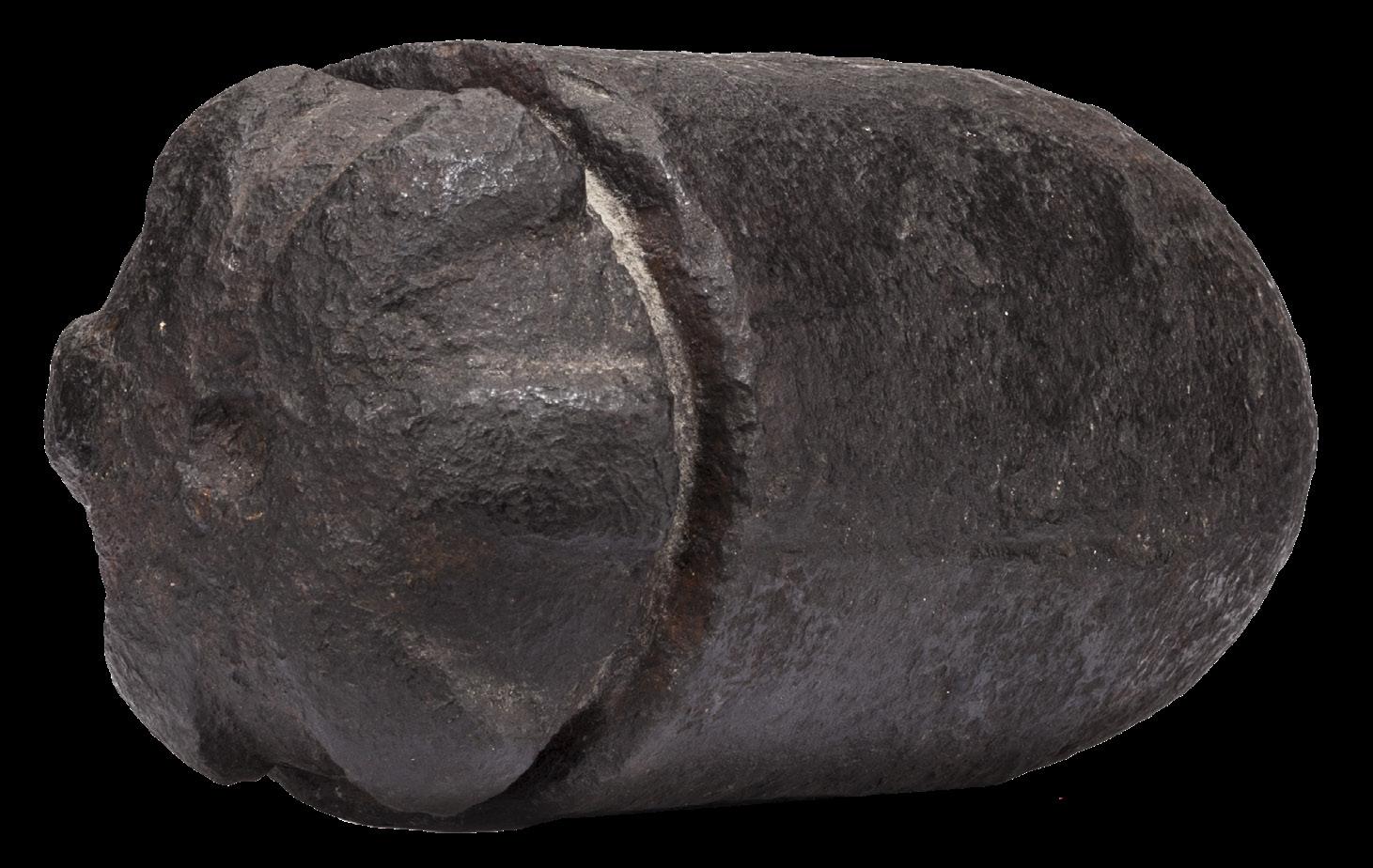
Diameter: 3.26 inches
Bore Diameter: 3.30 inches
Cannon: 3.3-inch Confederate rifle
Overall Length: 6.51 inches
Weight: 7.4 pounds
Construction: Shell

Fusing System: Time (missing)
Fuse Material: Wood

Sabot Material: Lead, cup (missing)
Collection: Barry Hocutt
Comments: The diameter of fuse hole is .94 inch and is 2.2 inches deep. Width of each of the four flanges on the base is 1.44 inches. Cone base has six raised notches with a lathe dimple in the base.
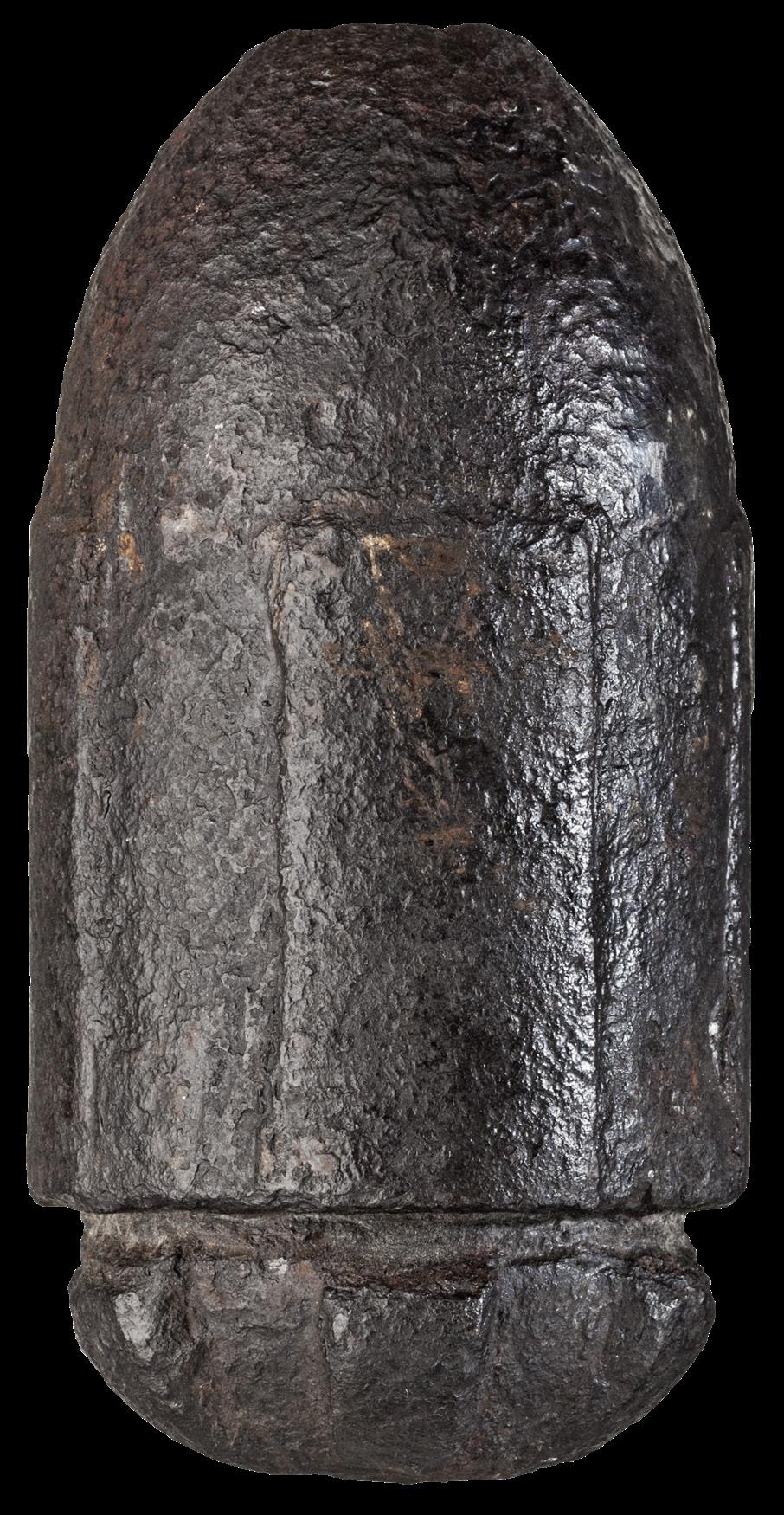
8
The Artilleryman
Diameter: 3.23 inches
Bore Diameter: 3.30 inches
Cannon: 3.3-inch Confederate rifle



Overall Length: 6.55 inches
Length Without Fuse: 6.55 inches
Weight: 9.40 pounds
Construction: Shell
Fusing System: Time
Fuse Material: Wood
Sabot Material: Lead, cup
Battlefield: Port Hudson, La.
Collection: Thomas Swift Dickey Sr. Collection, Atlanta History Center
Comments: There are four vertical flanges. Sabot has lathe dimple in the base. The sabot and flanges were turned on a lathe. Lead sabot measures 3.23 inches in diameter, and the iron body across the flanges measures 3.20 inches. Width of the four vertical flanges is 1.36 inches and they do not slant like the U.S. Dahlgrens.

ArtillerymanMagazine.com | Vol. 42, No. 1 9
Diameter: 6.35 inches
Bore Diameter: 6.40 inches
Cannon: Rifled 32-pounder smoothbore
Overall Length: 12.04 inches
Length Without Fuse: 12.04 inches
Weight: 60.0 pounds
Construction: Shell
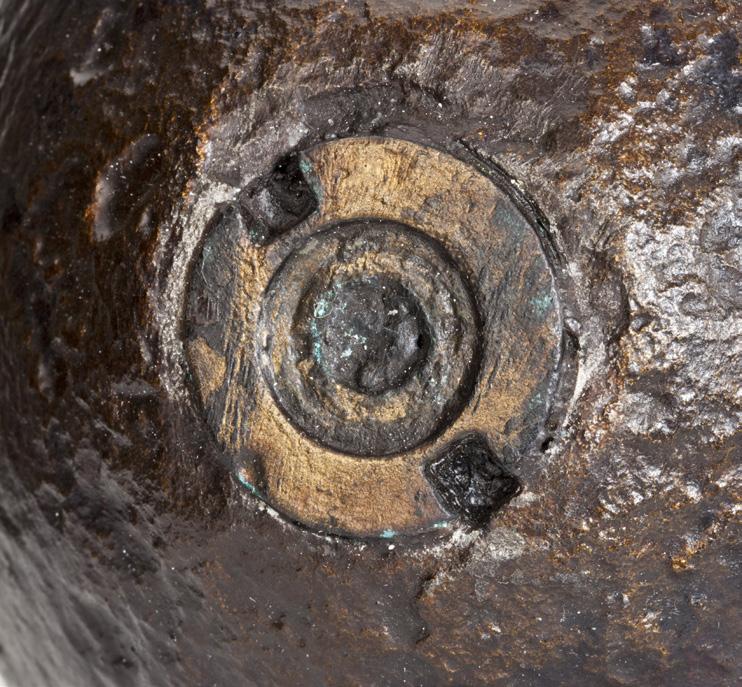

Fusing System: Time
Fuse Material: Brass
Sabot Material: Lead, cup
Sabot Height: 2.57 inches
Battlefield: Vicksburg, Miss.
Collection: Thomas Swift Dickey Sr. Collection, Atlanta History Center
Comments: Unfired. The lead sabot was turned on a lathe to the desired diameter. Flanges were also turned on lathe. The width of the four flanges on the body are 2.50 inches. Flanges are vertical and are not slanted like their U.S. counterpart. Unmarked brass C.S. water cap fuse with a head diameter of 1.27 inches. Fuse fits flush with the shell body. There is an expansion groove between the shell body and the sabot to allow the lead to be forced into the rifling grooves.
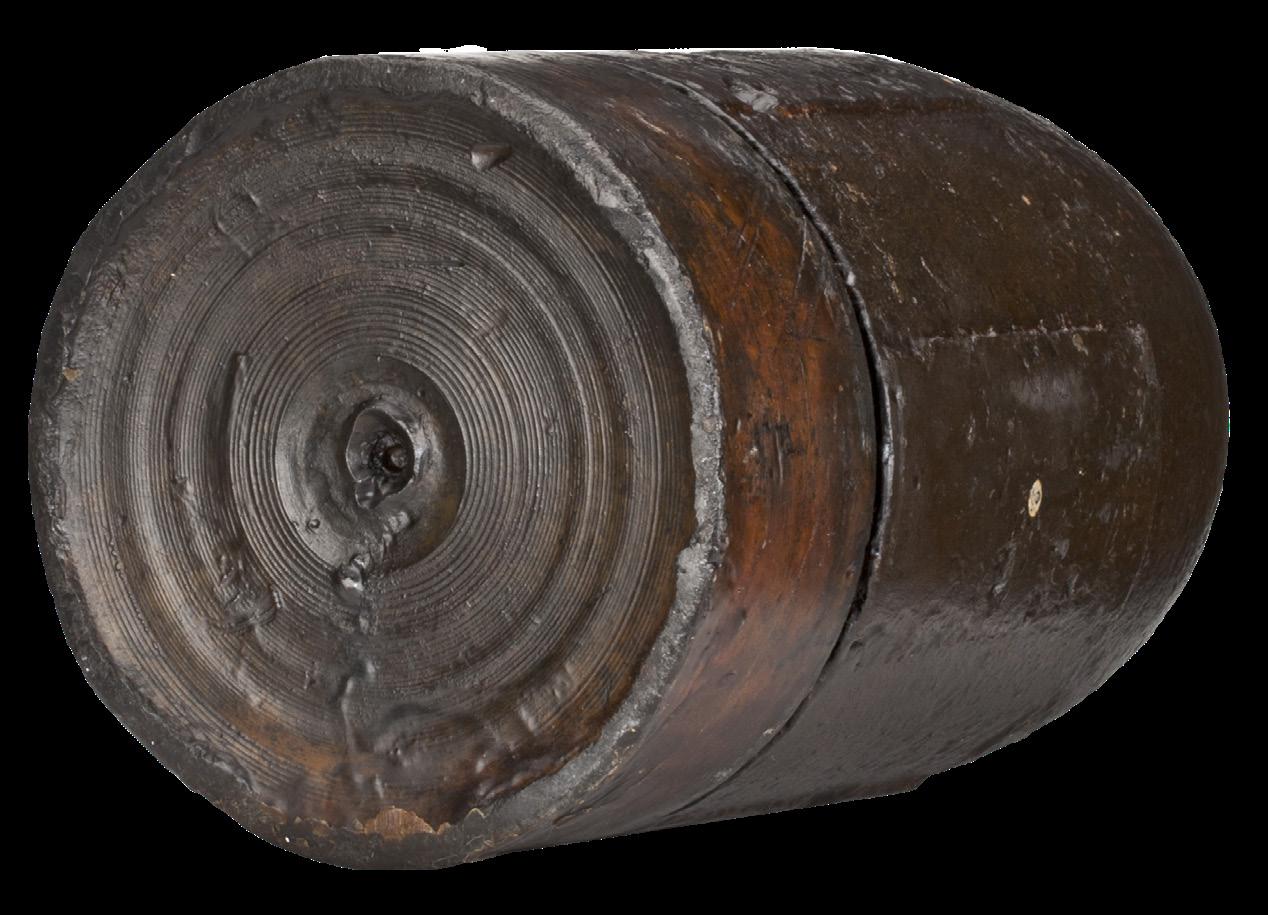


10
The Artilleryman
Diameter: 6.9 inches
Bore Diameter: 7.0 inches
Gun: 9-inch Dahlgren Smoothbore bored to 7-inches and rifled
Length: 15.2 inches
Construction: Shell
Fusing System: Percussion, Archer (missing)
Fusing Material: Brass

Sabot: Lead, cup
Weight: 90.8 pounds (without the fuse, bursting charge, and lead sabot)
Collection: Jack Bell
Comments: This 7-inch C.S. Dahlgren shell was positively identified as having been recovered on the shore in Hampton, Va., and was fired from the CSS Virginia during its attack on the USS Cumberland on March 8, 1862.
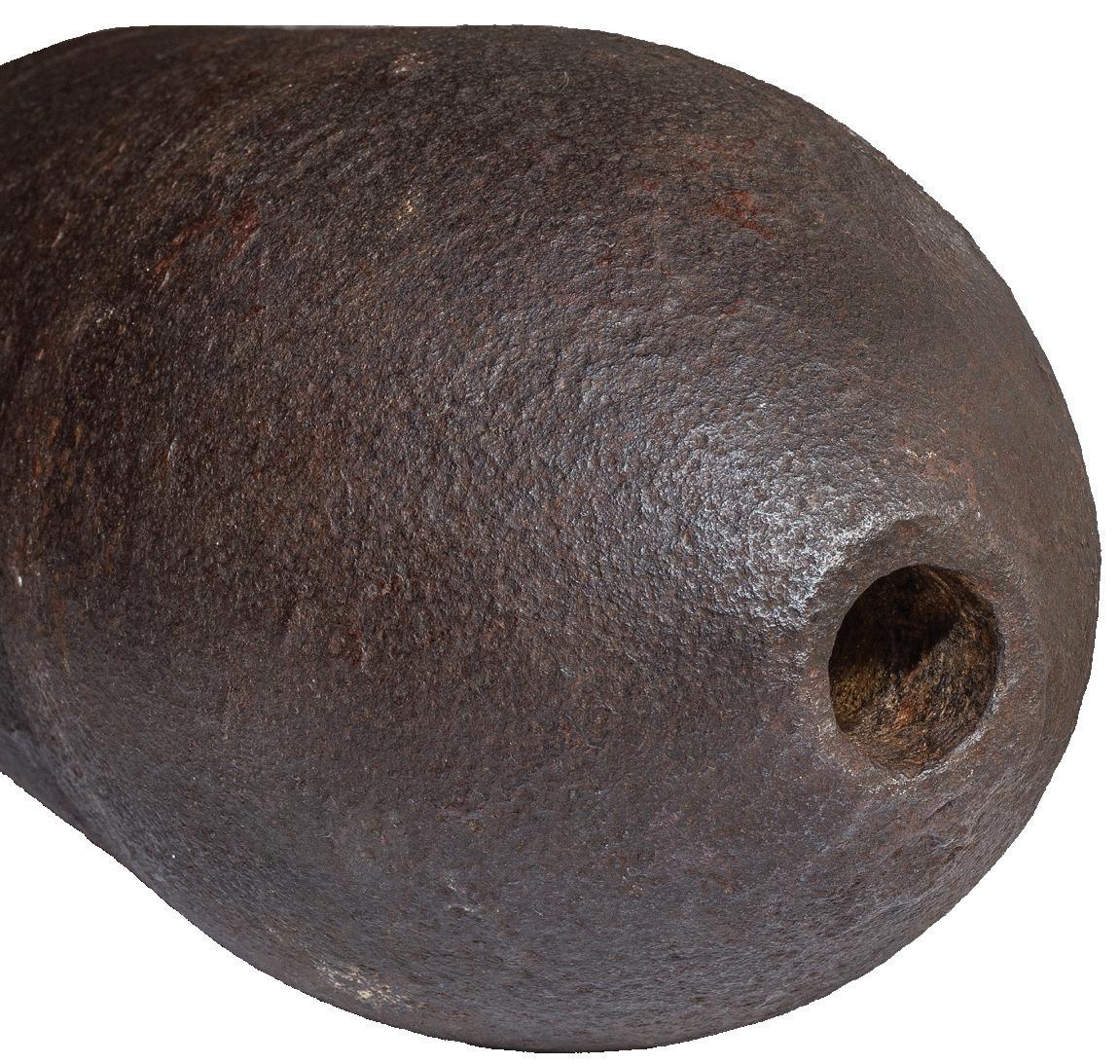
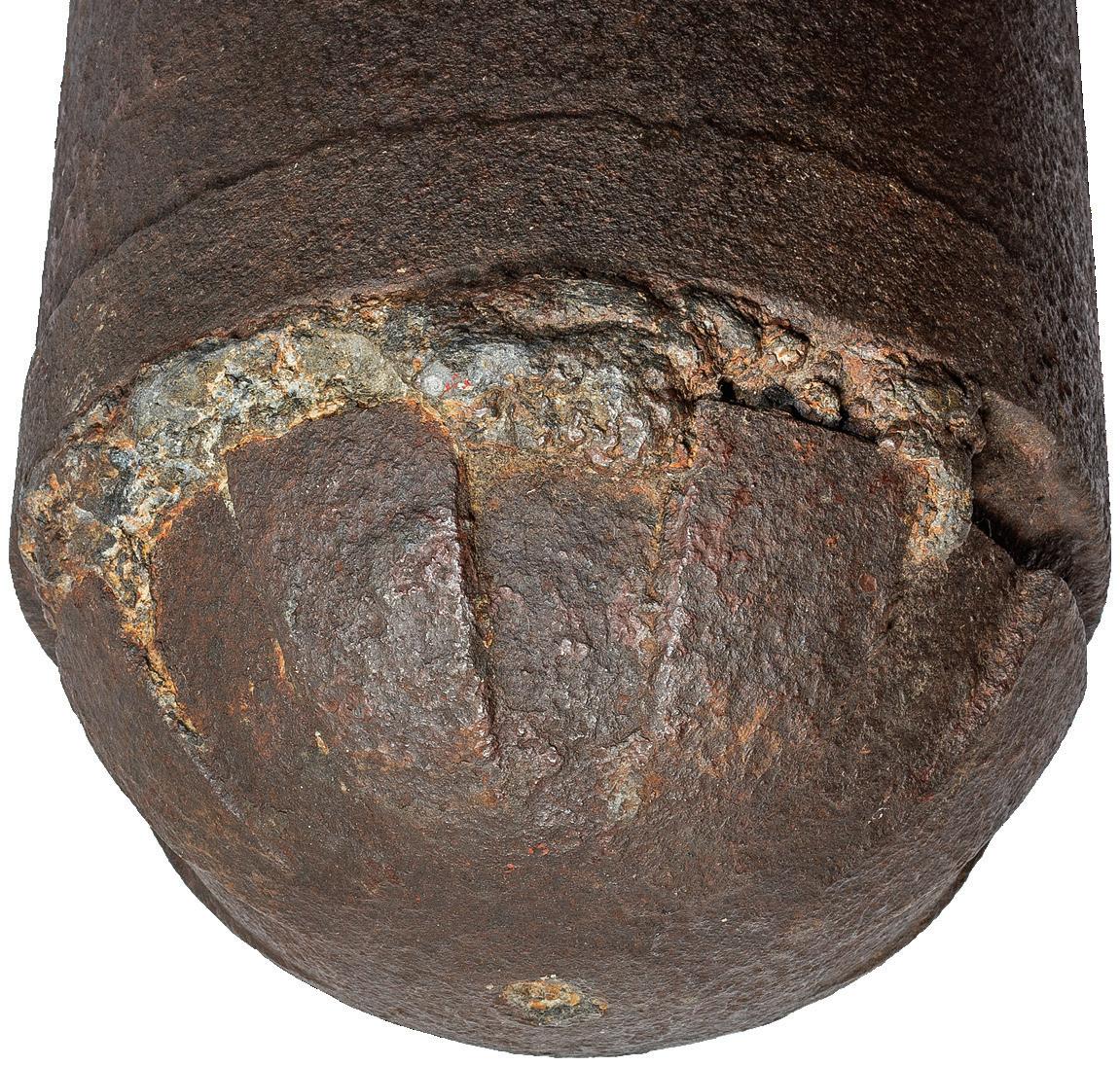
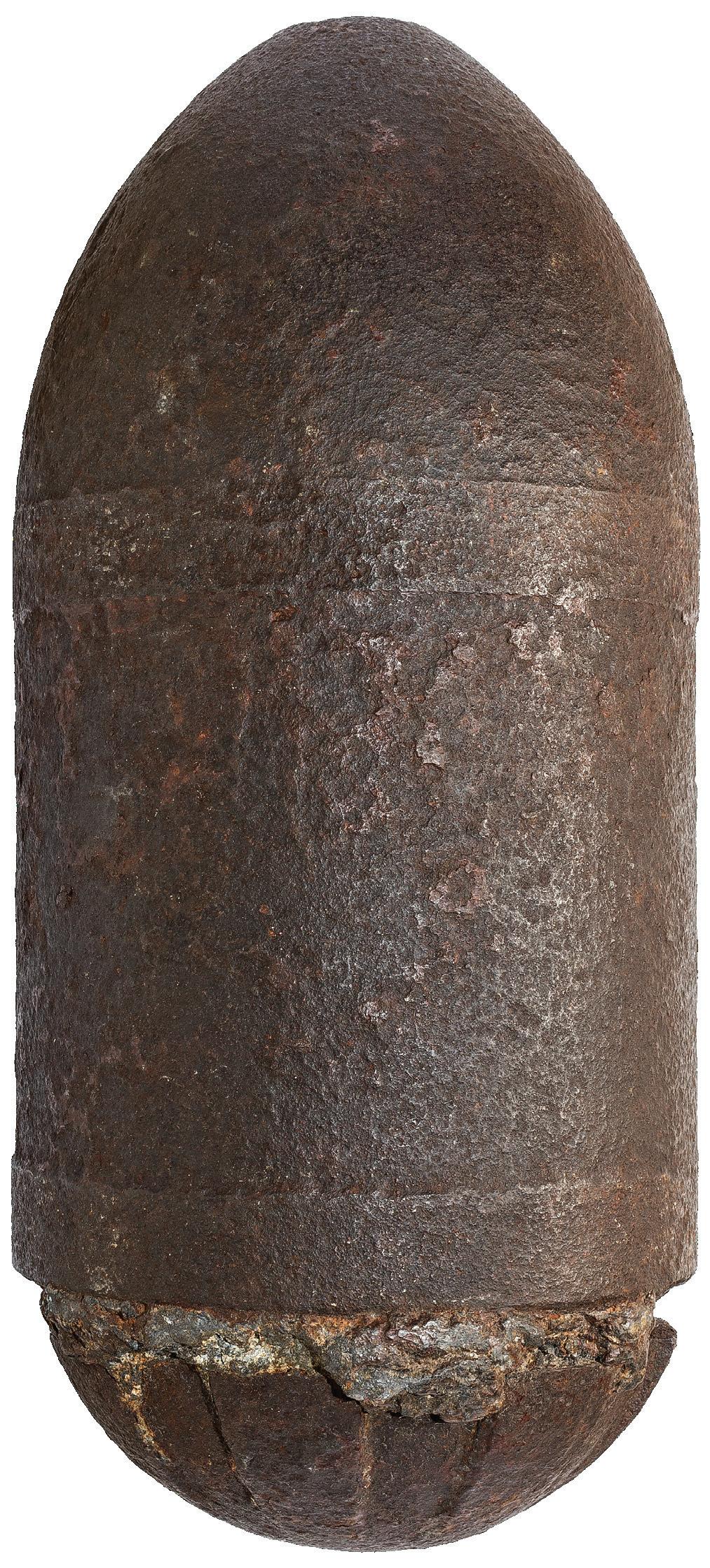
ArtillerymanMagazine.com | Vol. 42, No. 1 11
by John C. Whatley
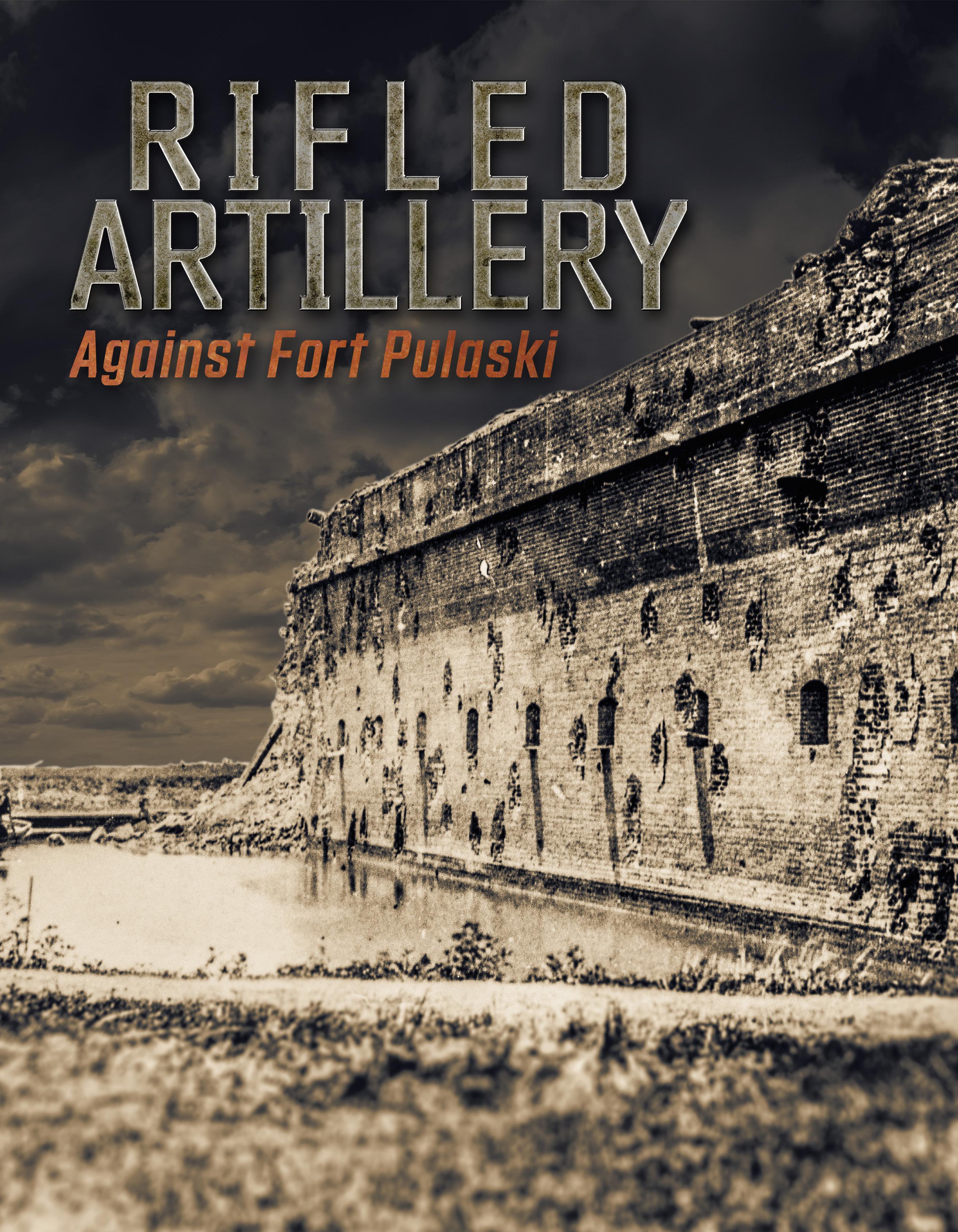
The American Civil War introduced three major warfare innovations: ironclad ships, the first successful submarine, and destruction of coastal fortresses by rifled cannon. This last usually gets no more than a footnote, if that, yet it foreshadowed today’s improved artillery and naval guns.

The first rifled cannon assault occurred with the initial Confederate bombardment of Fort Sumter. The first Union reduction was launched against Fort Pulaski, guarding the Savannah River and the port of Savannah, Ga. Named for Revolutionary hero Count Casimir Pulaski, it still sits on Cockspur Island, a low marsh island splitting the Savannah into two channels, and is open to the public.
Two prior forts had been constructed there: a palisaded log blockhouse named Fort George (after King George II) built as defense against the Spanish in Florida, and a timber-reinforced earthen fort mounting a guardhouse and artillery pieces named Fort Greene (after Revolutionary War hero Nathanael Greene). The first was torn
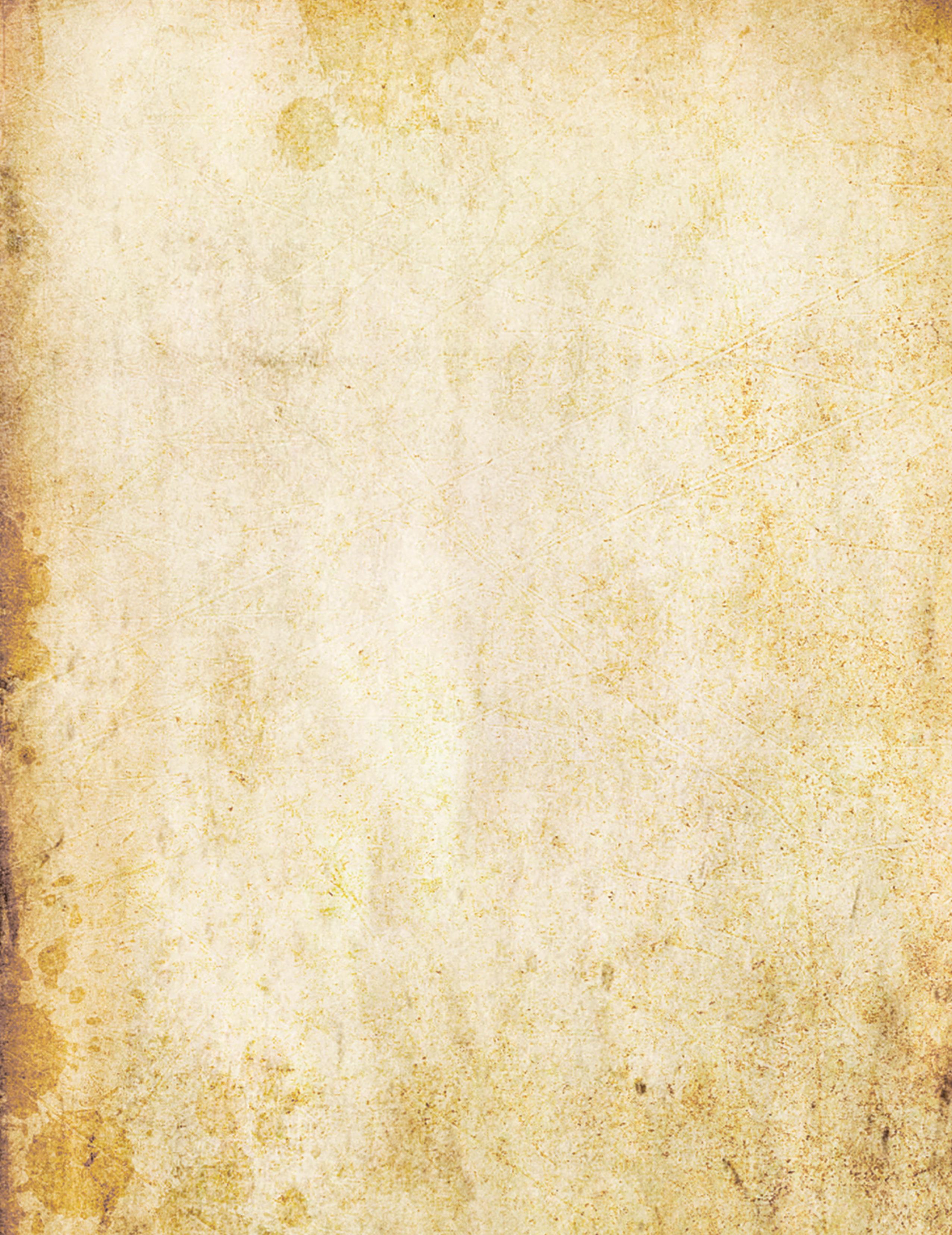
down; the second was destroyed by a hurricane.
Because the English fleet landed troops at will during the War of 1812, the United States decided to build 200 fortresses from Maine to Florida to protect major ports. In 1816 the Board of Engineers designed a series of coastal fortifications called the “Third System.” Cockspur Island was selected as site of the last Third System fort built.
Recent West Point graduate Lt. Robert E. Lee was the engineer assigned to construct Pulaski. Lee spent 17 months, starting in 1829, determining the fort’s location, building the dikes and drainage system, and planning the supporting structure. He was succeeded in 1831 by Lt. Joseph Mansfield, who finished the fort in 1846. By then the United States was at war against Mexico; England had become an ally, and the Third System had low priority.
Fort Pulaski was to be a twin to Fort Sumter in Charleston Harbor, a pentagonal, two-story edifice with three tiers of guns. Cockspur Island could
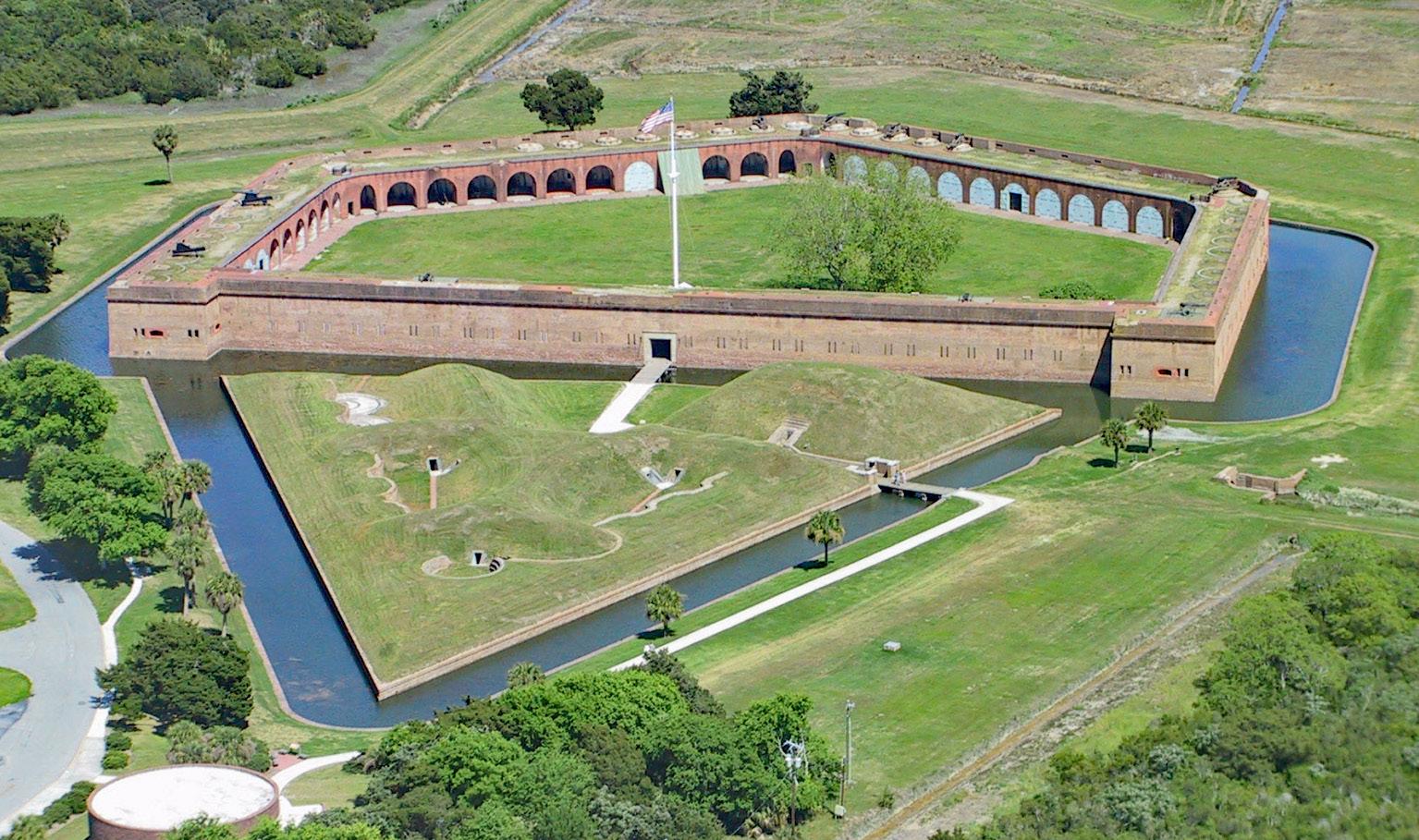
not support such weight so Pulaski was modified into a single-story twotiered fort. Two layers of subflooring were built atop 70-foot-long pilings driven into the mud. On this the 7½ -foot-thick walls were built, using 25 million bricks.
Behind Pulaski’s 48-foot-wide moat, two sides (faces) guarded the North Channel, two the south. The top tier of guns was en barbette (on the parapet) while the lower second tired fired through the casemate’s embrasures. Heavy casemate piers and arches backed the fort’s walls. Originally built for 150 guns, Pulaski had only 20 casemate 32-pounders in 1861.
When South Carolina seceded in December 1860, Union Maj. Robert Anderson consolidated his troops at Fort Sumter. Georgia Governor Joseph E. Brown, fearing a takeover of Pulaski by Federal troops, ordered Col. Alexander R. Lawton, commander of the 1st Georgia Volunteer Regiment at Savannah, to seize Pulaski. The two-person garrison, an ordnance sergeant and the fort’s caretaker, immediately surrendered.
Aerial view of Fort Pulaski. Bob Webster.
FORT PULASKI’S SIGNIFICANT MILITARY LEADERS
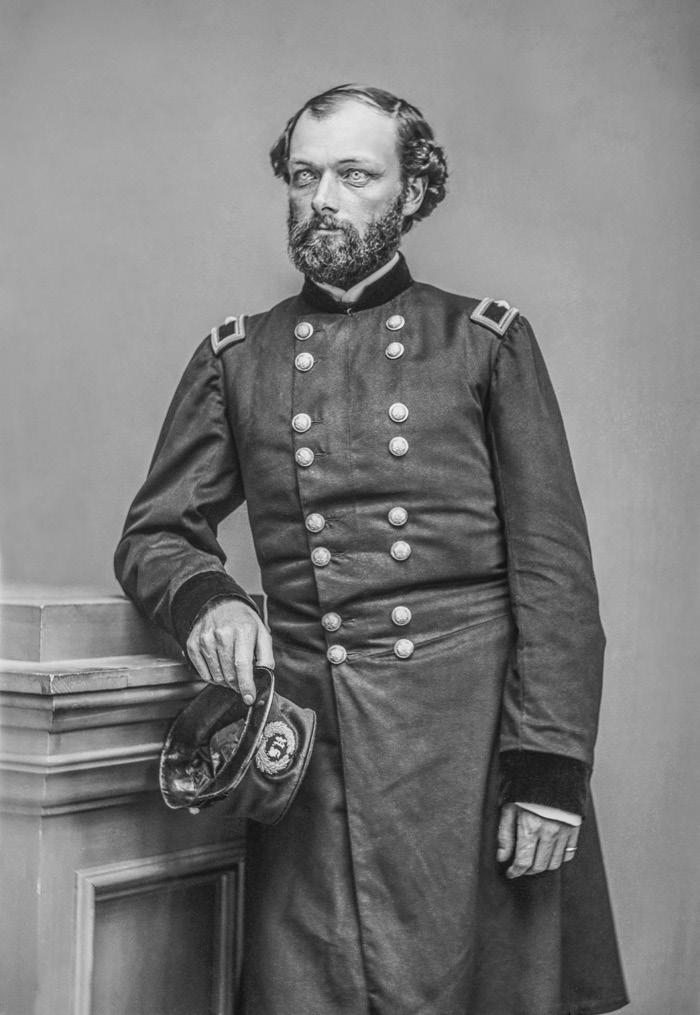
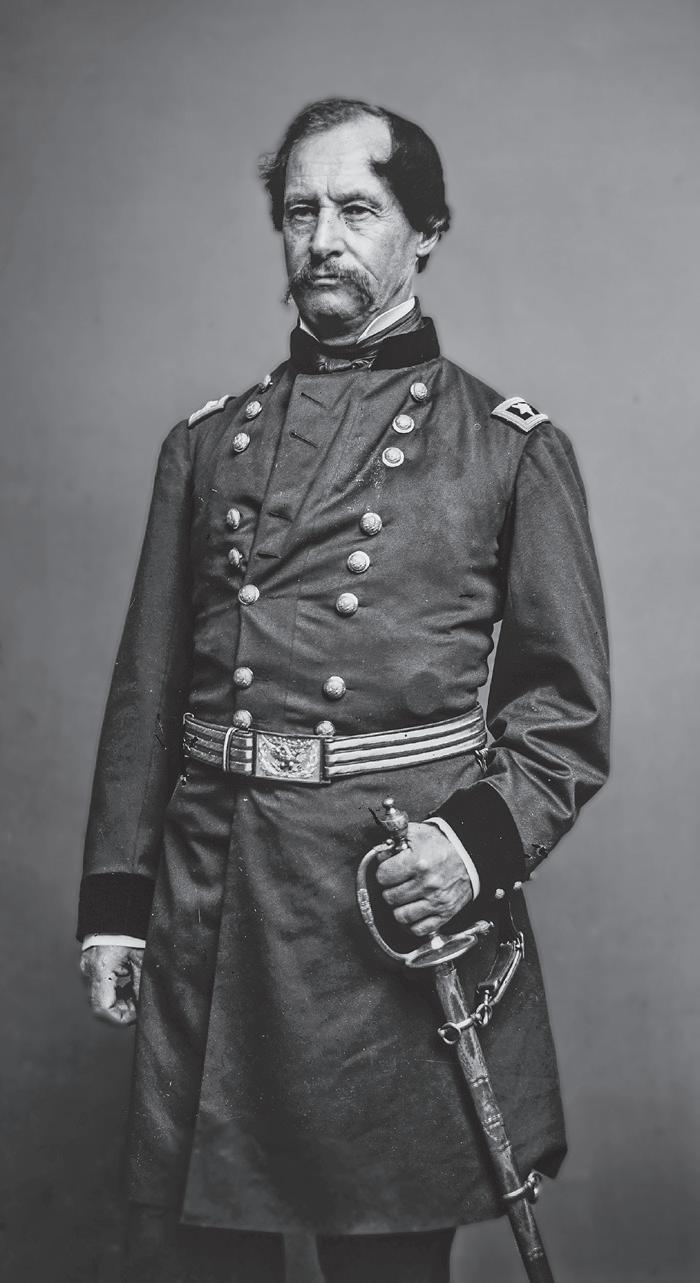
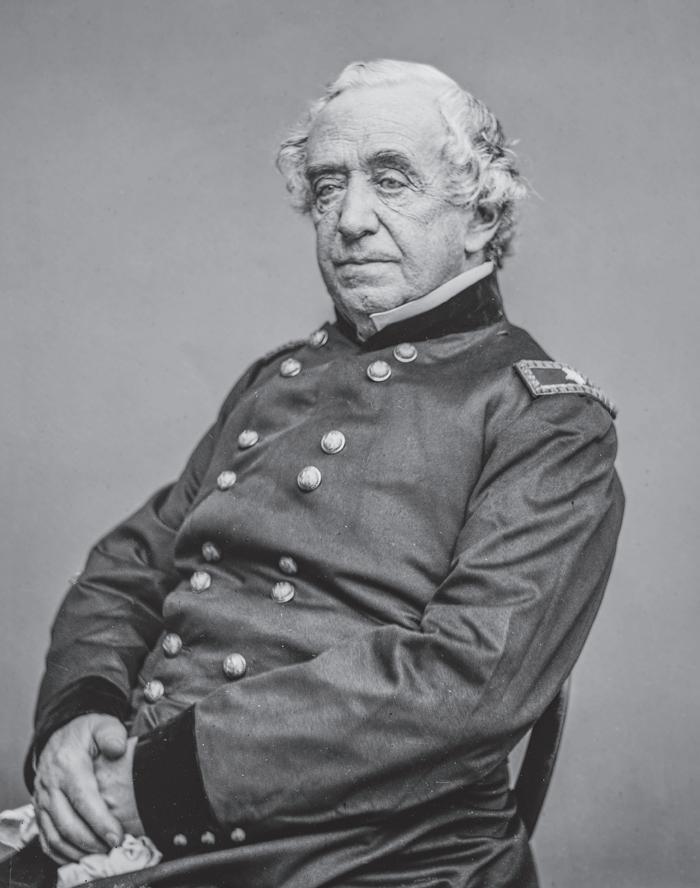
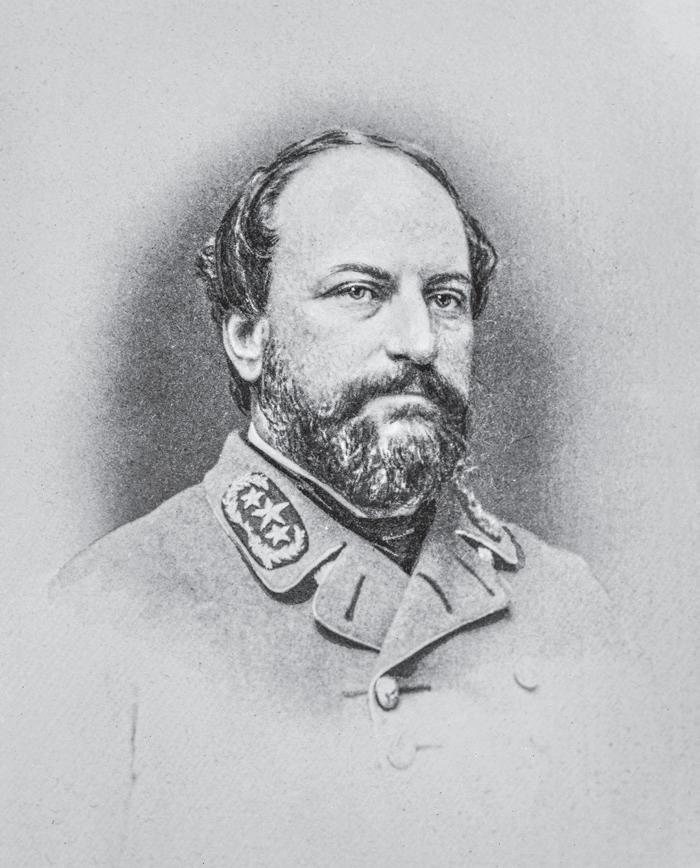
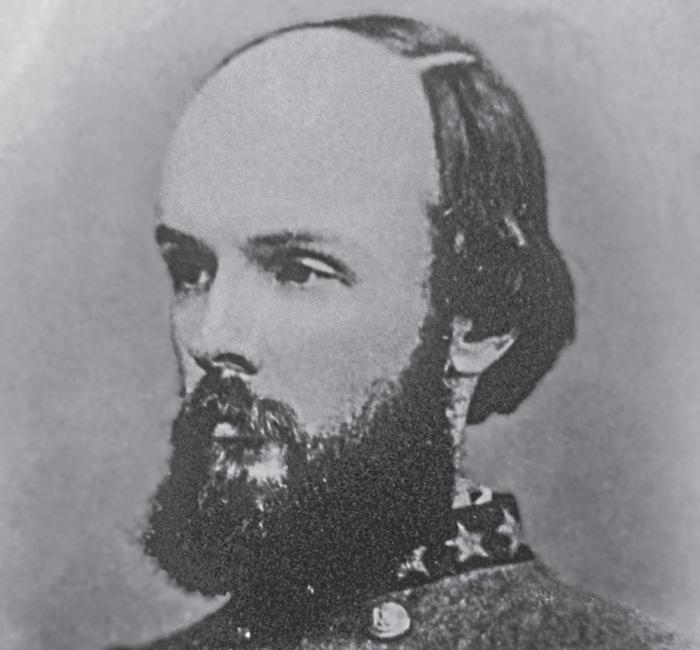


 Gen. Joseph K.F. Mansfield. NARA-528442.
Col. Charles H. Olmsted.
Alexander R. Lawton. Library of Congress.
Brig. Gen. Joseph G. Totten, Chief, Corps of Engineers. Library of Congress.
Maj. Gen. David Hunter. Library of Congress.
Gen. Joseph K.F. Mansfield. NARA-528442.
Col. Charles H. Olmsted.
Alexander R. Lawton. Library of Congress.
Brig. Gen. Joseph G. Totten, Chief, Corps of Engineers. Library of Congress.
Maj. Gen. David Hunter. Library of Congress.
The
14
Gen. Quincy Adams Gillmore. Library of Congress.
Artilleryman
Confederates found the fort neglected: the 32-pounders, mounted on rusted iron carriages, could not be fired; magazines held little powder and few projectiles; living quarters were uninhabitable; the parade ground was overgrown; silt and marsh grass filled the moat. By hiring 125 slaves from local rice plantations to repair the fort and clean the moat, 17 officers and 210 men garrisoned a refurbished Pulaski with 36 guns by October 1861. A telegraph line ran to Savannah, and supply ships regularly docked.
As a fortress, Pulaski was considered impregnable. Union Brig. Gen. Joseph Totten, a member of the Board of Engineers who designed the Third System, said Fort Pulaski “could not be reduced in a month’s firing with any number of guns of manageable calibers.” Even Lee told Col. Charles H. Olmstead, now commanding the fort, “They will make it very warm for you with shells from [Tybee Island] but they cannot breach at that distance [1,700 yards].” A contemporary military work noted: “An exposed wall may be breached with certainty at distances from 500 to 700 yards … [but at a] distance not exceeding 1,000 yards the quantity of artillery must be considerable, and it will require from four to seven days’ firing.”
The experts were wrong. New technology had recently arrived in the

form of rifled cannon. The stable flight produced by the rifled bores, coupled with the increased range of rifled cannon, and the impact effect of conical shot on a target, would render coastal fortresses obsolete.
Rifled Cannon
Englishman Sir Joseph Whitworth manufactured a breechloading gun with a distinctive hexagonal twisting bore in the 1850s. The hexagonal ammunition followed the tube when fired, producing spin. Whitworth discovered, though, that length and weight of the shot did not affect the gun. Larger projectiles could be made “by simply increasing the length of the projectile without increasing the diameter of the bore.”
Englishman William G. Armstrong tested his breechloading rifled gun against a Martello tower at Eastbourne, Sussex, England, in August 1860. Martello towers were squat, lighthouse-style towers mounting guns for coast defense instead of lights for navigation. The Eastbourne tower had 7 ½-foot-thick brick walls. At 1,032 yards a 4 ¾-inch 40-pounder, a 6-inch 82-pounder, and a 7-inch 100-pounder opened a breach 24 feet wide. The 40-pounder shot penetrated 4 to 5 ½ feet. A similar breaching test using 68and 32-pounder smoothbores at the same range was deemed a failure.
The following ordnance and ordnance stores were landed at different times, and placed in position in the batteries opposite Fort Pulaski:
12 13-inch mortars and beds.
4 10-inch siege mortars and beds.
6 10-inch columbiads and carriages.
4 8-inch columbiads and carriages.
2 84-pounder James rifles, and carriages. (old 42-pounders rifled.)
2 64-pounder James rifles, and carriages. (old 32-pounders rifled.)
1 48-pounder James rifles, and carriage. (old 24-pounder rifled.)
5 30-pounder Parrott rifles, and carriages.
The Kingdom of Prussia [Germany] tested rifled breechloaders against some obsolete fortifications in September 1860. Lt. Col. A. Ross of the Royal Engineers observed that at 640 yards, 27-pound rounds fired by two 12-pounder guns produced a breach 32 feet wide in a 3-foot-thick brick wall and penetrated 15 inches.
Americans also experimented with rifled cannon. West Point graduate Robert P. Parrott, supervisor of the West Point Foundry, patented his cast iron rifled cannon design in 1861. Its thick reinforcing band around the breech guarded against the higher internal pressures when firing rifled ammunition. Parrott’s reinforcing band adhered uniformly because he mounted the barrel horizontally on rollers while spraying water inside to cool it. The first Parrotts utilized a wrought iron cup sabot; later Parrott employed a softer brass metal band on his projectiles that, when fired, was forced into the rifling and imparted a spin.
Rhode Island militia general Charles T. James, a self-educated mechanic, invented a round with a conical top of cast iron. Iron ribs connected
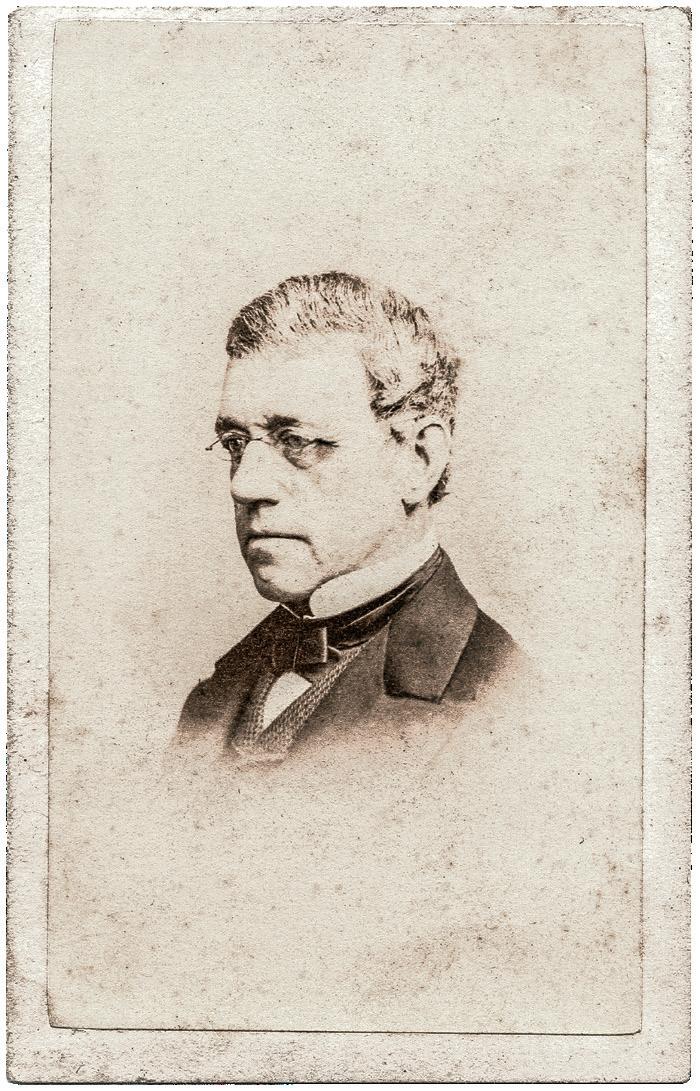 Robert Parker Parrott, inventor of the Parrott rifle, fuse, and projectile.
Robert Parker Parrott, inventor of the Parrott rifle, fuse, and projectile.
ArtillerymanMagazine.com | Vol. 42, No. 1 15
the top to an open circular base. A lead sabot and a lubricating greased canvas wrapped the ribs. Gases expanded through the ribs when fired, forcing the lead sabot into the rifling grooves, imparting spin.


Capt. Quincy A. Gillmore, the engineer officer of the Union force sent

to close Confederate ports along the South Atlantic coast, was familiar with these rifled weapons. He became convinced that rifled artillery could reduce even fortresses such as Pulaski. When Union troops captured Tybee Island, across the Savannah River’s South Channel from Pulaski, Gillmore put troops there to set up breaching batteries. Tybee, another Georgia marsh island, has little solid ground. When the cannon arrived, they were hauled by hand from the beach across the flat marshland to their emplacements. All work was done by night and camouflaged before morning. The Confederates heard noise by night, but saw nothing by day.
Effect On Pulaski
On the morning of April 10, 1862, the bushes on Tybee had been cut down and a camouflaging sand ridge leveled. The Confederates saw black objects they suspected were cannon. When a boat under a flag of truce rowed from Tybee to Pulaski carrying the formal demand for surrender, Olmstead politely replied that he was there “to defend the fort, not to surrender it.” A mortar arched the first shot, the Union cannon joined in, and the
Confederates replied.
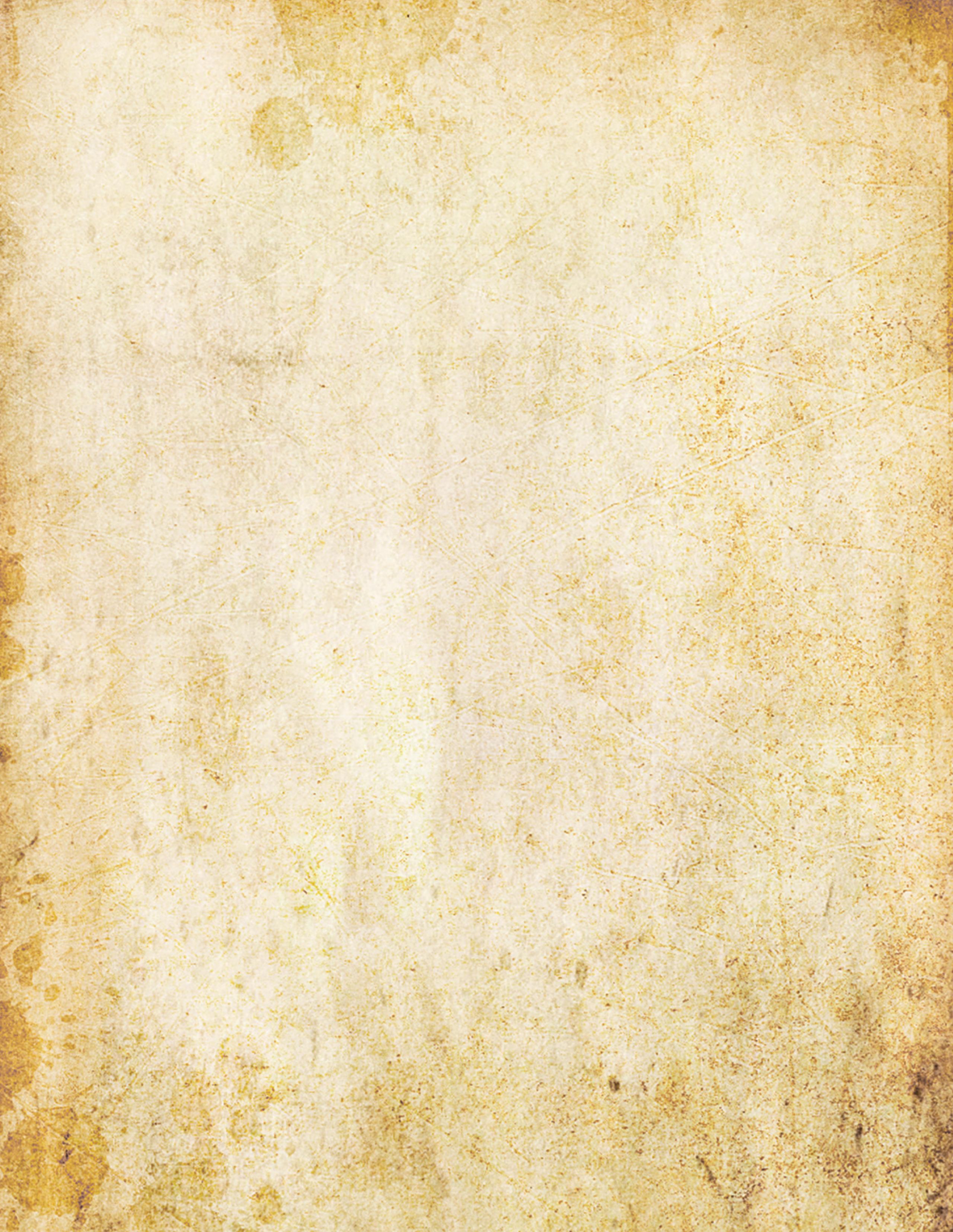
“Very early in the day however,” Olmstead wrote, “it was seen that the effect upon the fortification was becoming disastrous…. [The] rifled guns and Columbiads at the Point inflicted more damage to the Fort than all the others combined.” Firing from the Point were three 10-inch and one 8-inch smoothbore Columbiads in one battery, five 30-pounder Parrotts and one 48-pounder James [24-pounder smoothbore rifled on the James system, 5.82-inch caliber] in the second, and two 84-pounder [42-pounder smoothbores rifled on the James system, 7-inch caliber] and two 64-pounder [32-pounder smoothbores rifled on the James system, 6.4-inch caliber] James at the third. The James projectiles, both bolts and shells, penetrated the bricks, splitting them from the wall and causing whole sections to collapse. Clouds of reddish dust billowed from the walls at each impact.
A shot from one of the Columbiads “struck the wall beneath an embrasure while it was still intact and bulged the bricks on the inside,” wrote Olmstead. “[Our guns] upon the faces fronting the fire that was breaching our walls nearly all were dismounted before the close of the day.”
Rifled 42-pounder Gun: 84-pounder, 7-inch James Bolt
Diameter: 6.92 inches
Bore Diameter: 7.0 inches
Cannon: Rifled and banded
42-pounder smoothbore
Overall Length: 12.50 inches
Weight: 76.2 pounds
Construction: Bolt
Fusing System: None
Sabot Material: Lead
Sabot Height: 5.35 inches
Collection: Mike Ward
Right: 84-pounder James bolt picked up right after the siege of Fort Pulaski. Note the nose damaged by impacting the masonry fort walls. John A. Dietrichs Collection.
Charles T. James, inventor of the James rifling system, James rifle, fuse, and projectile.
16
The Artilleryman
Effects of shot and shell that rained down on Fort Pulaski
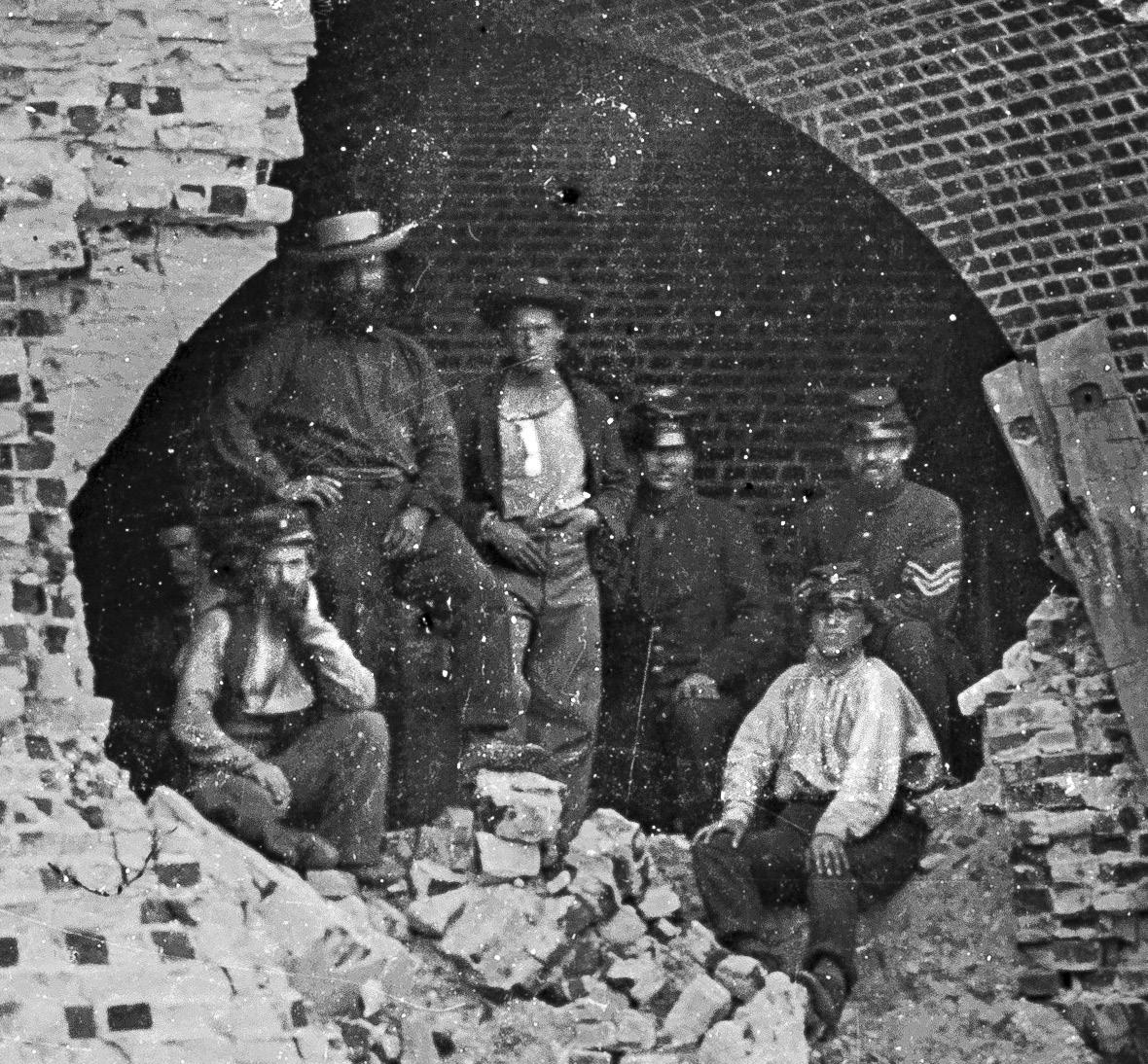

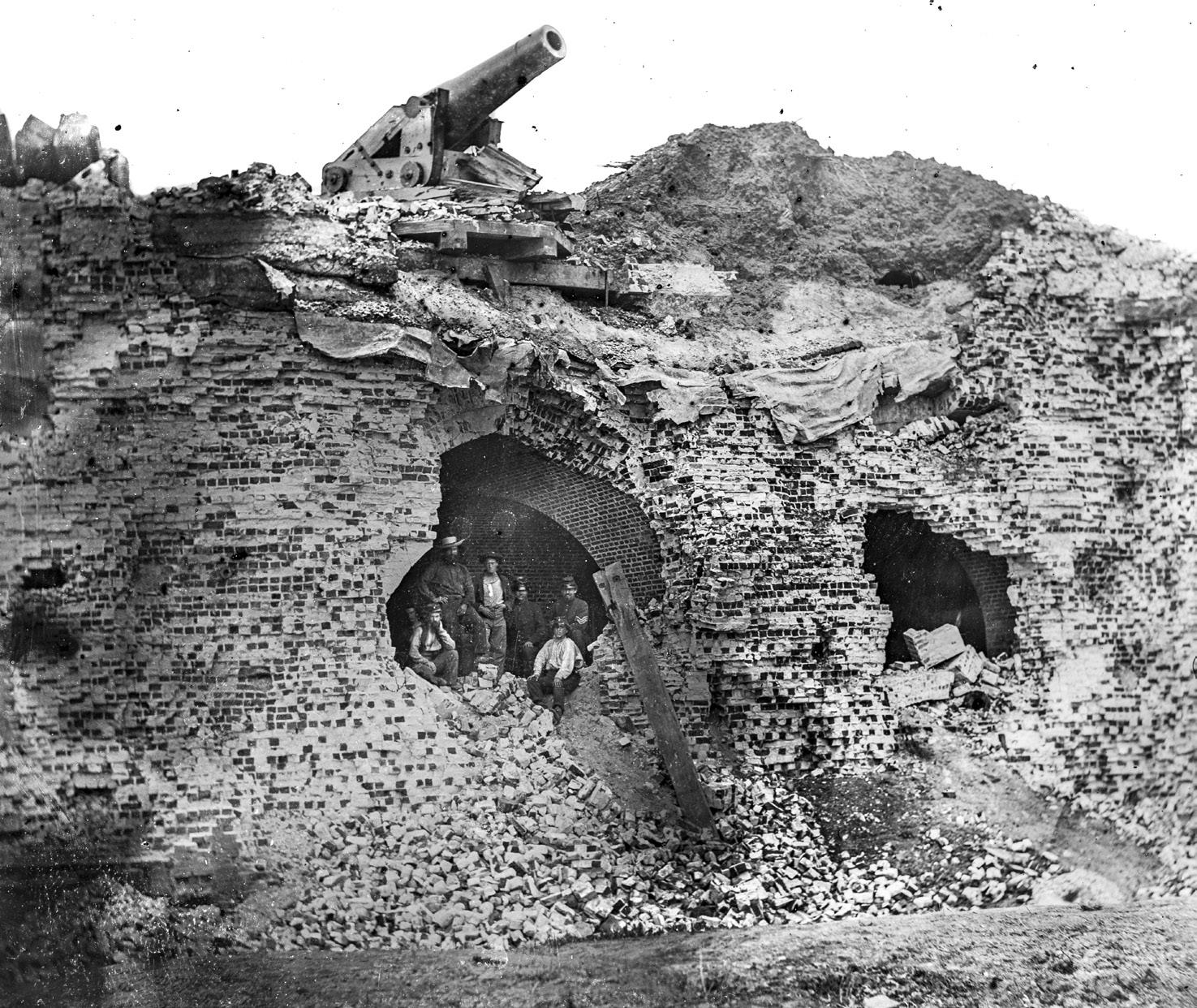
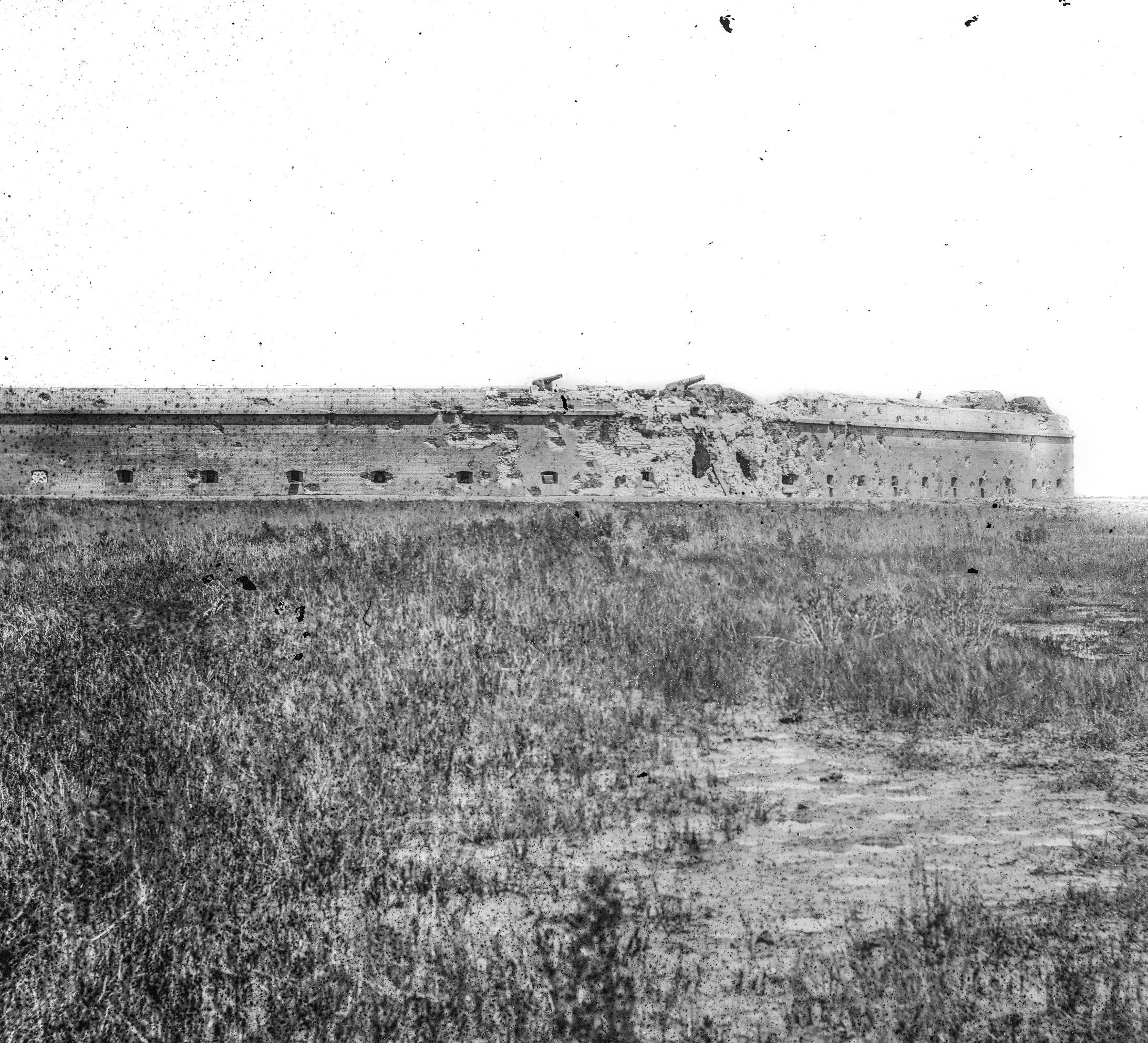

ArtillerymanMagazine.com | Vol. 42, No. 1 17
Wartime photographs of the damage to the fort’s walls. Library of Congress.
Olmstead inspected the damage from outside the fort that night. “It was worse than disheartening, the pan-coupe [a short wall between faces] at the south-east angle was entirely breached while above, on the rampart, the parapet had been shot away…. The two adjoining casemates were rapidly approaching the same ruined condition; the moat was nearly filled with masses of broken masonry, as was the interior of the three casemates where the dismounted guns
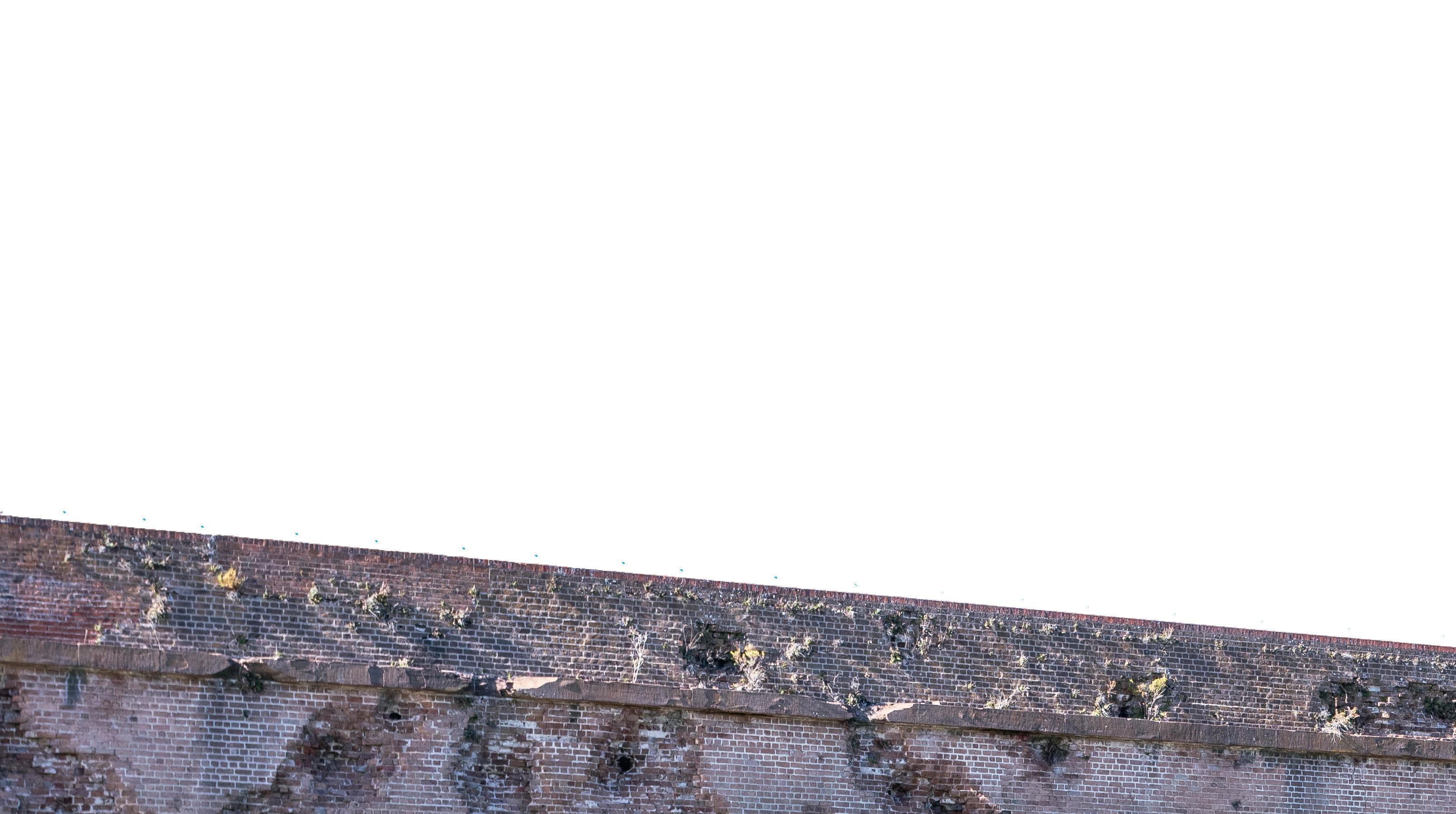
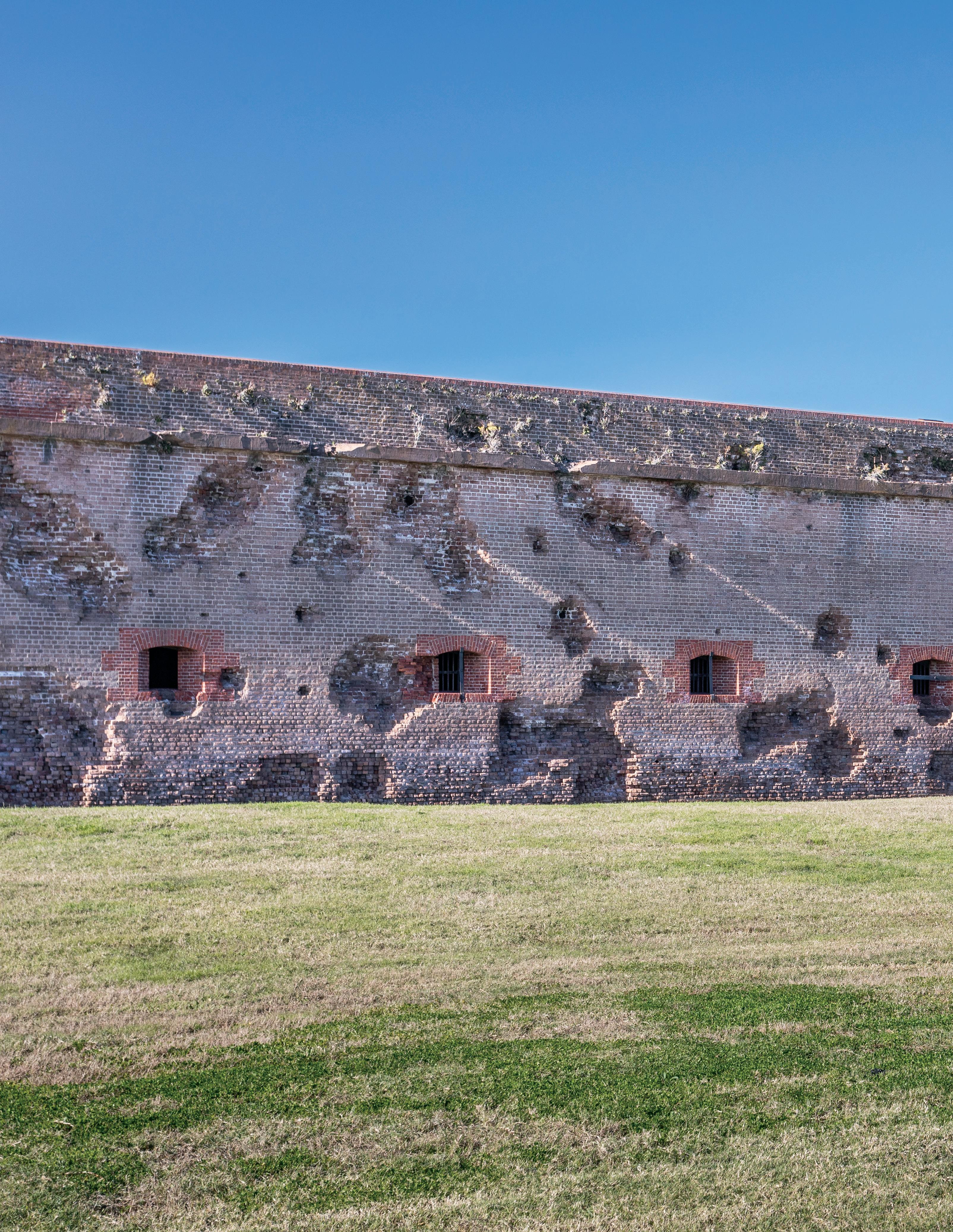
lay like logs among the bricks.”
The next morning “the breach rapidly became wider and the enemy’s shot and shell played freely through it across the parade upon the opposite interior angle where the principal service magazine [containing 44,000 pounds of powder] was located. The entrance to this was protected by a large traverse sufficiently heavy, it was thought, for the purpose designed. Between one and two o’clock in the afternoon, however, a shell passed through the top of this and exploded in the passage
way, filling the magazine with smoke and lighting it up with flame.”
It was evident that a second similar shot would blow up the fort.
The white flag was run up. “There are times when a soldier must hold his position ‘to the last extremity,’ which means extermination, but this was not one of them,” wrote Olmstead. After the surrender another round was discovered stuck in the middle of new brickwork closing the ventilation hole to the southwest magazine.

A corporal of the Phoenix Riflemen and a signalman, escaping the fort before surrender,
RECAPITULATION.
John C. Whatley is a retired Field Artillery Officer and writes narrative history about the War Between the States. He has had over 200 articles published about the War in various publications and is the author of the Typical Confederate series of books. This article originally appeared in the Old Guardsman newsletter of the Old Guard of the Gate City Guard (Atlanta, Georgia) in 2005 and was reprinted in The Sentinel newsletter of the Secession Camp of the SCV (Charleston, S.C.) in 2010, both of which publications the author edited.
Number of guns bearing upon the fort, 20 Number of mortars bearing upon the fort 16 Total number of pieces bearing upon the fort 36 Number of shots fired from the guns 3,543 Number of shots fired from the mortars 1,732 Total number of shots fired 5,275
18
The Artilleryman
reported to Savannah: “At the close of the fight the casemate walls [were] breached in almost every instance to the top of the arch, say between five and six feet in width. The moat outside was so filled with brick and mortar that one could have passed over dry shod. The officers’ quarters were torn to pieces, the bomb-proof timbers scattered in every direction over the yard, and the gates to the entrance knocked off.
“The parapet walls on the Tybee side were all gone, in many places down to the level of the earth on the casemates. The protection to the magazine in the northwest angle of the fort had all been
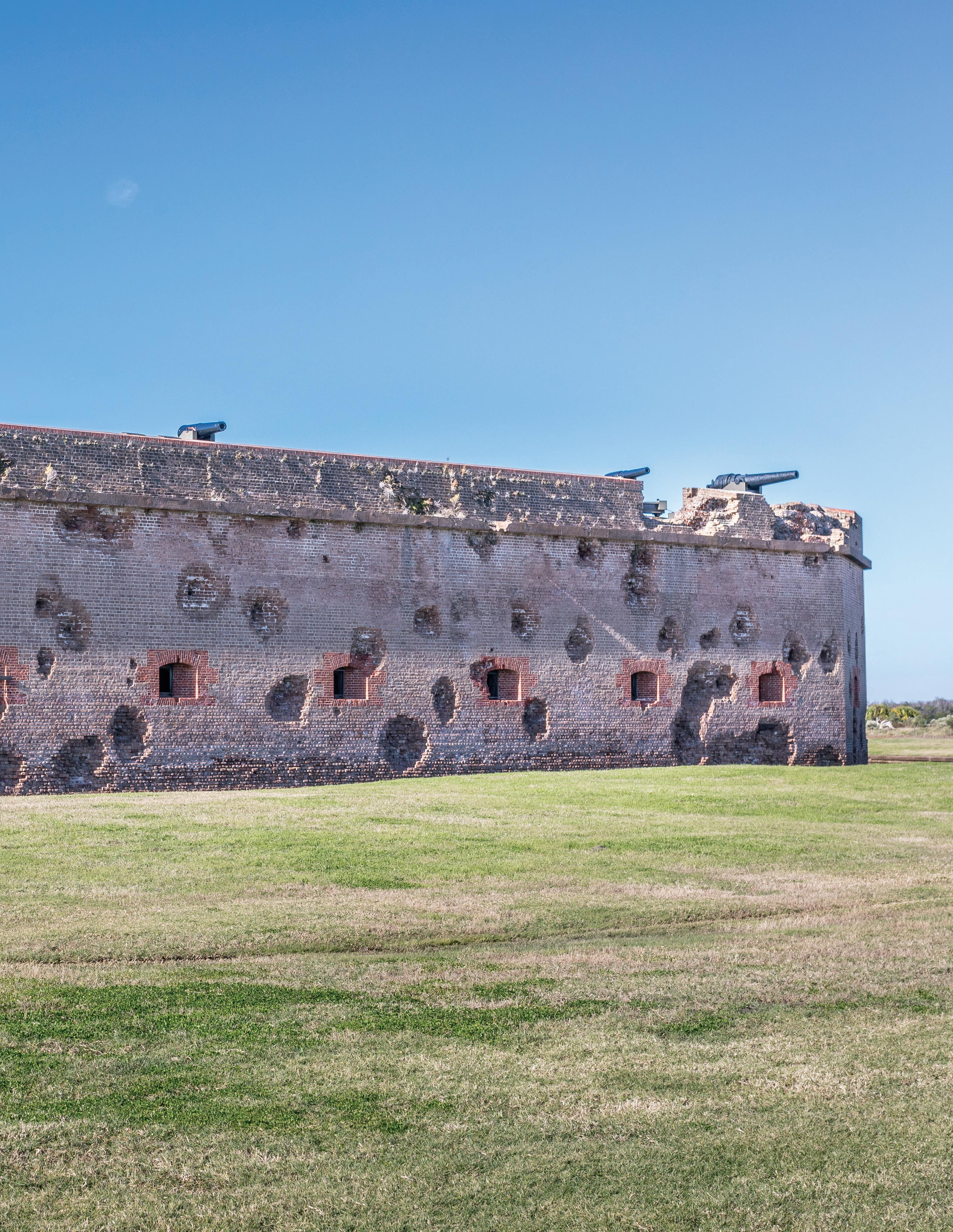
shot away; the entire corner of the magazine next to the passageway was shot off, and the powder exposed, while three shots had actually penetrated the chamber.”

Conclusion
After the surrender Gillmore rushed over, eager to see the effects on the fort, and Olmstead escorted him around. He found the 84-pounder James projectiles had penetrated 26 inches into the walls, and most James shells penetrated at least 18 inches before exploding, causing enormous lateral damage to the brick. One 42-pounder penetrated 12 feet into the
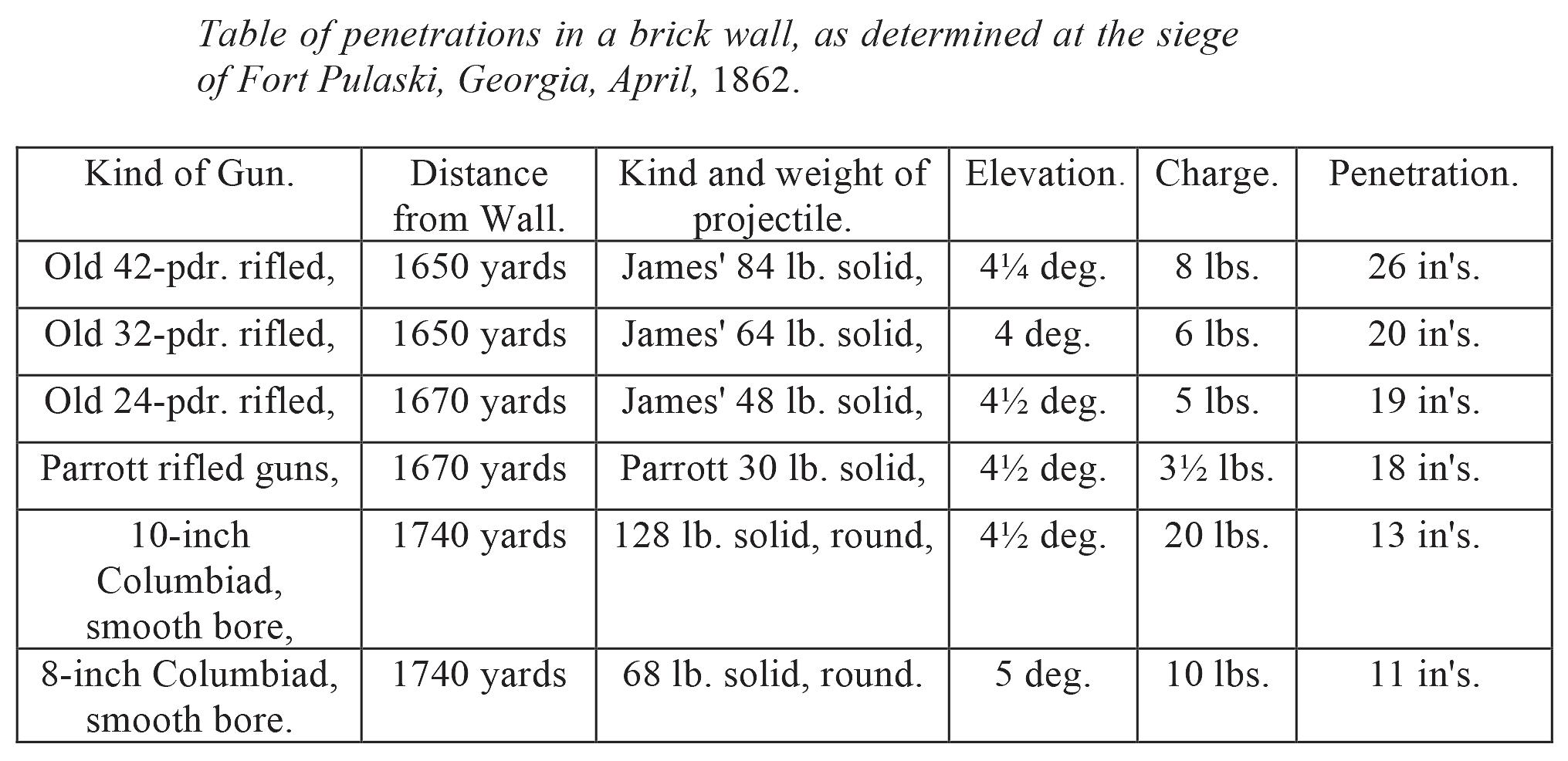
traverses between the barbette guns! Olmstead said the fort’s masonry yielded like wood to the James projectiles. “Brick and mortar cannot stand before them.”

But Union commander Maj. Gen. David Hunter realized Pulaski’s true significance: “The result of this bombardment must cause, I am convinced, a change in the construction of fortifications as radical as that foreshadowed in naval architecture by the conflict between the Monitor and Merrimac [Virginia].
“No work of stone or brick can resist the impact of rifled artillery of heavy caliber.”
ArtillerymanMagazine.com | Vol. 42, No. 1 19
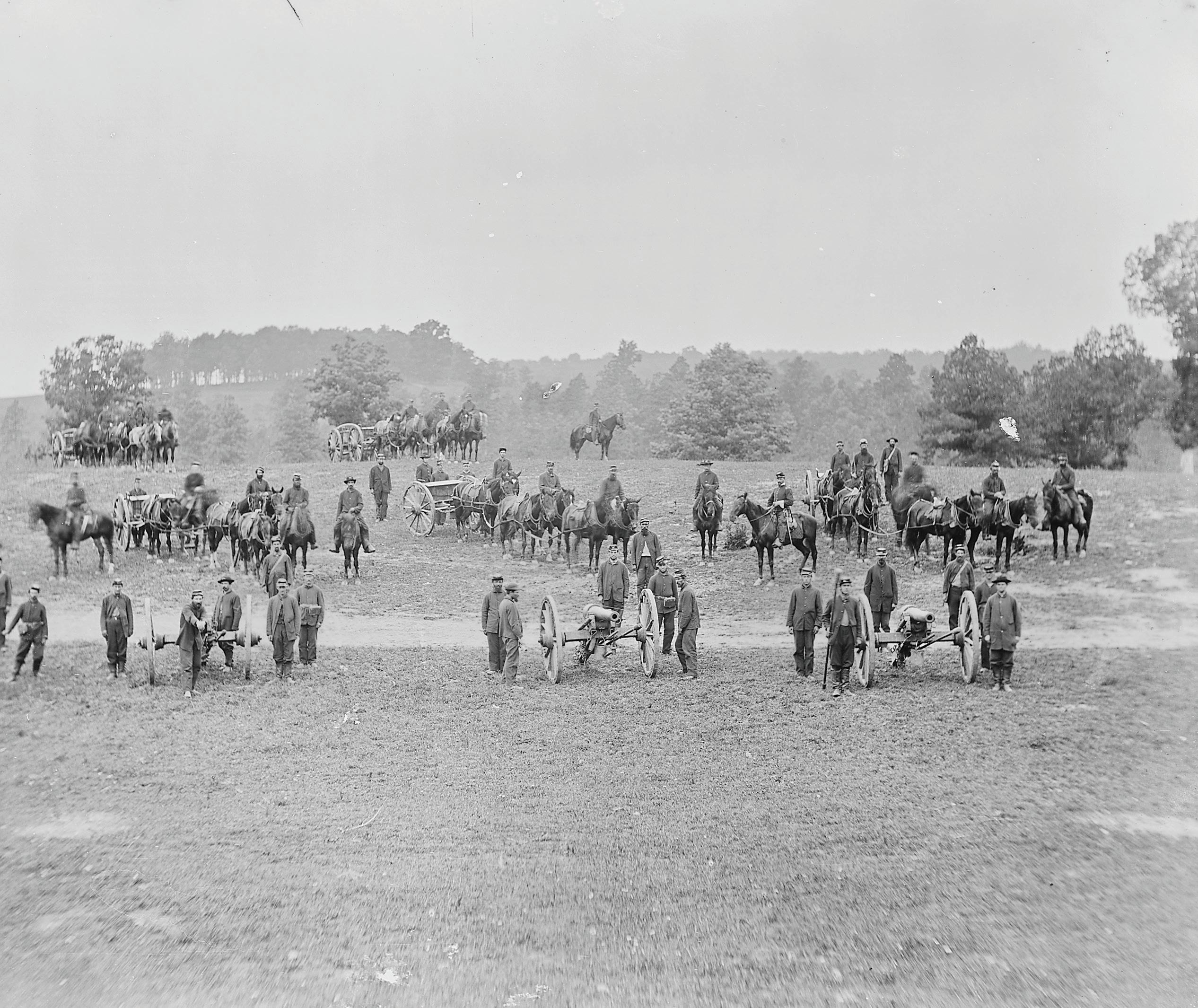


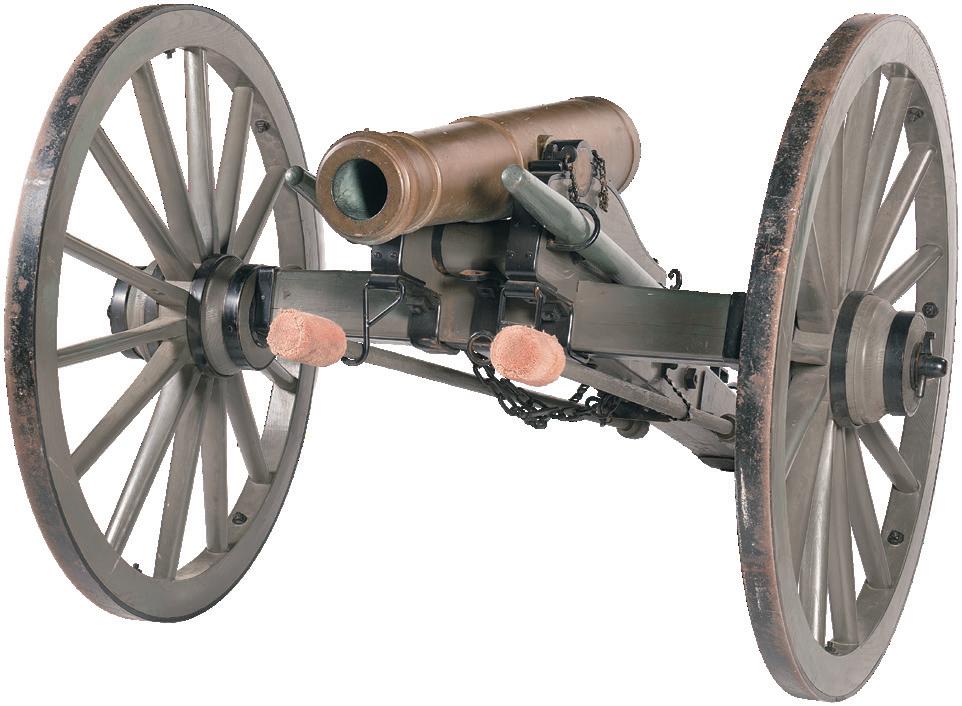


Results
Island Auction Company® 2020 artillery results. Civil War West Point Foundry 20-Pounder Parrott Rifle Civil War Confederate John Clark & Co. of New Orleans Pattern Bronze 12-Pound Field Howitzer with Carriage Sold $54,625 Sold $287,500 Colt Model 1874 Gatling Battery Gun with Field Carriage Sold $431,250 Sold $126,500 Company
2020 Artillery
Rock
Rifled Ames Model 1841
Heavy 12-Pounder Field Gun
Civil War 1862 Dated Phoenix Iron Co. Model 1861 3-Inch Ordnance Rifle
Pre-Mexican-American War 1837 Dated Cyrus Alger & Co. 6-Pounder Model
1835 Bronze Field Gun with Carriage

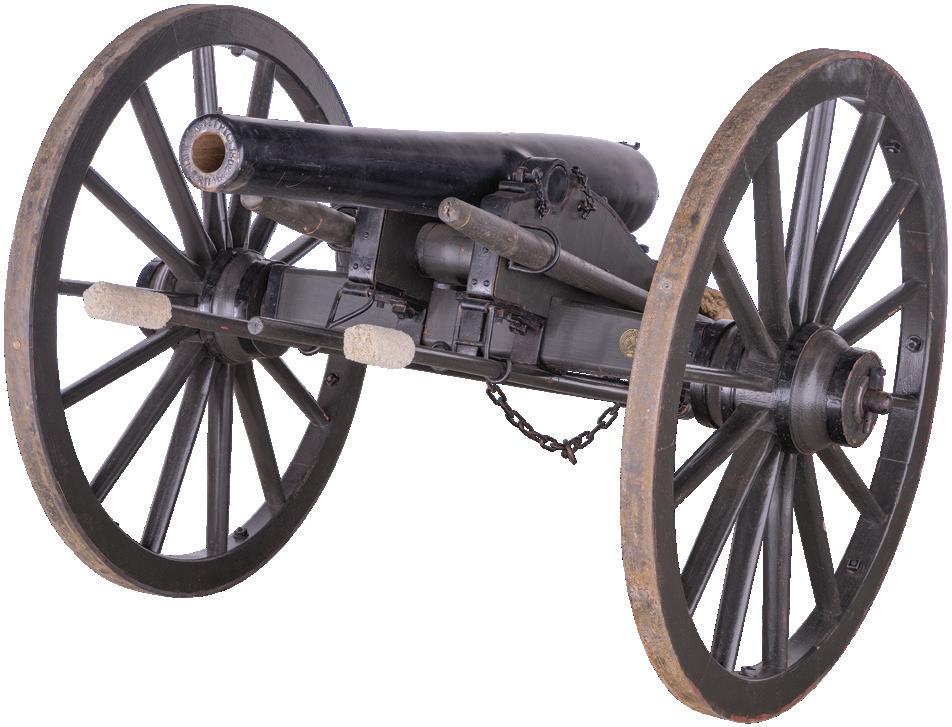


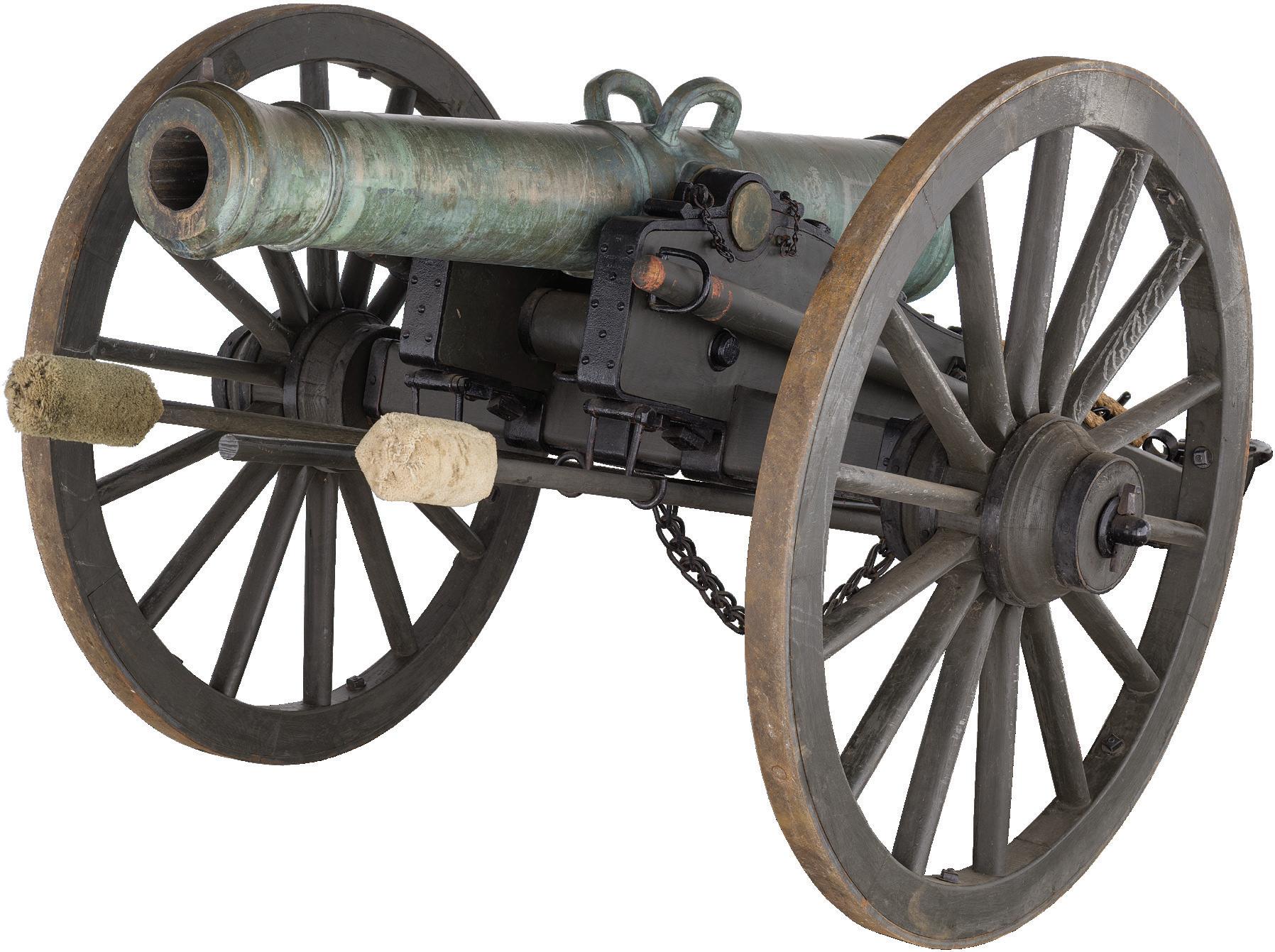
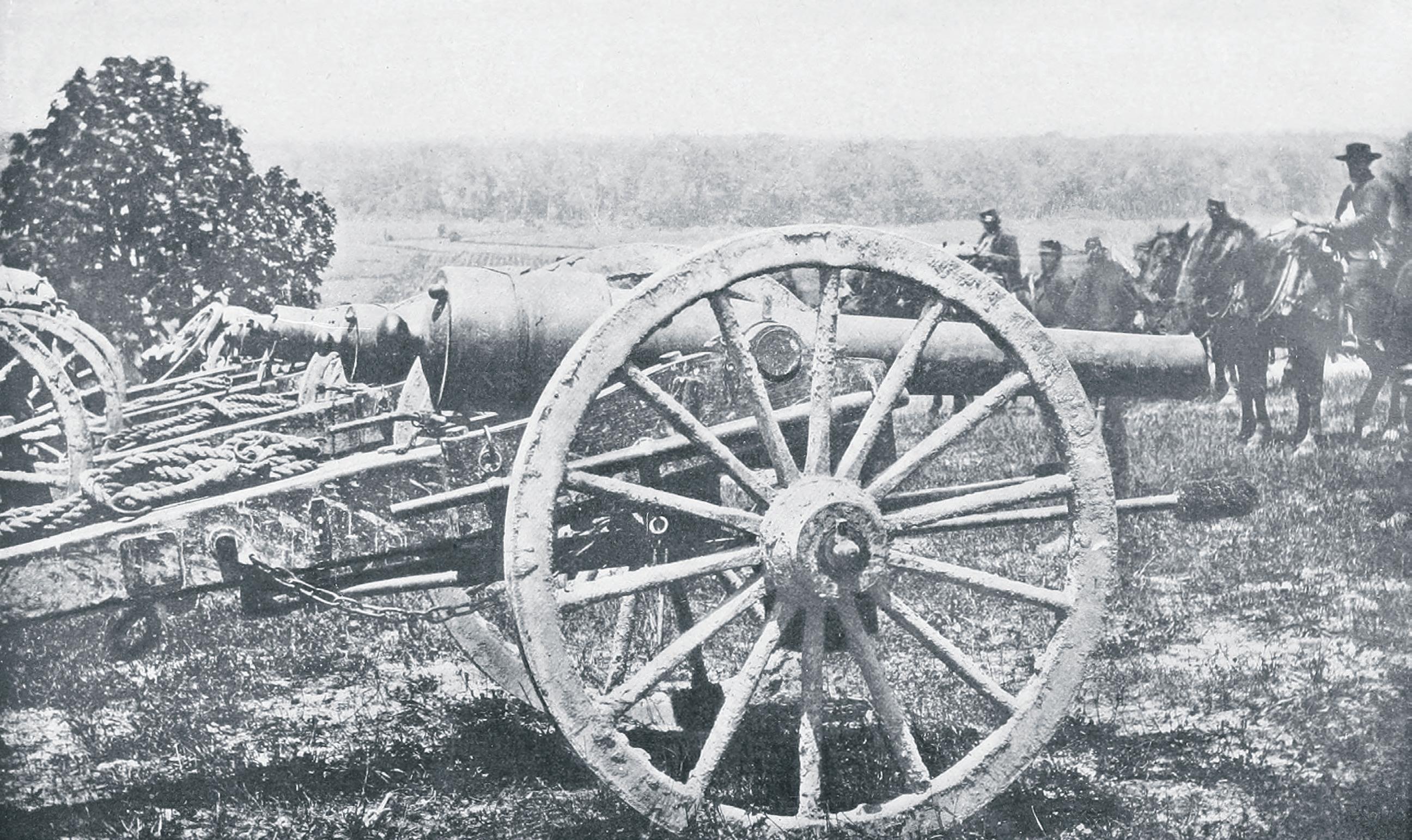
To
Early 1861 Dated Phoenix Iron Co.
Civil War Model 1861 3-Inch Ordnance Rifle, the 4th Produced

Rare, Desirable and Iconic U.S. Inspected and 1887 Dated Colt Model 1883 Gatling Gun with Field Carriage Visit
2020
®
Sold $126,500 Sold $92,000 Sold $97,750 Sold $63,250 Undisputed World Leader for Quality Collectable and Antique Firearms
RIAC’s
for updates WWW.ROCKISLANDAUCTION.COM
website
be offered Dec. 4-6,
News from the U.S. Army Artillery Museum
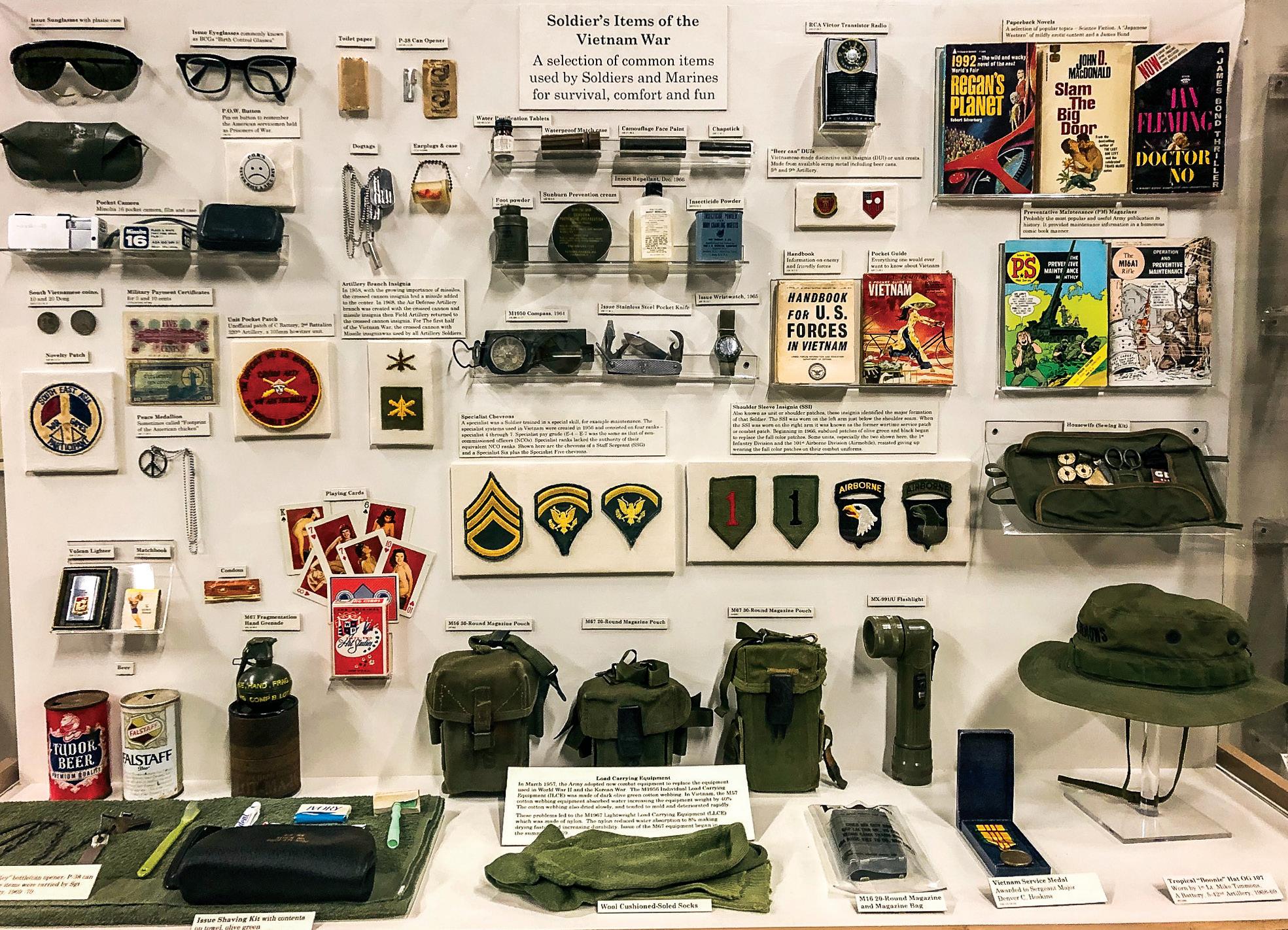

The museum was allowed to reopen to the public on October 7, masks required, of course. Tuesday–Saturday 9-5.
At long last, on July 15, we moved the last three macro artifacts into the new addition. That day, the biggest, heaviest, at 31 tons, piece, the M109A6 Paladin 155 mm Self-Propelled Howitzer was moved into position. With that task completed, each of today’s five Field Artillery Military Occupational Specialties (MOS) today is represented by a currently serving macro artifact.
Since completing the macro artifact installation, we have been working on finishing the Korean War diorama, equipping all the macros, and creating exhibits. The Korean War diorama was finished on August 28 after volunteer Steve Burns put in over 1,000 hours detailing the winter landscape.
The museum’s intent is that every vehicle/artillery piece be completely “battle ready” with every piece of equipment, tool, supplies, and gear. To date we are 90% complete on this very difficult task. The near impossible objective here is that every artillery veteran will find everything exactly in place as when they served on the piece.
We have completed the following new exhibits: Aerial Rocket Artillery (ARA) rockets, 9th Artillery pennant, Korean War & Forward Observer, North Korean flag, Vietnam War Souvenir Jacket, C-Rations, ARA Insignia Panel, Vietnam War Soldiers, ARA Map, Fire Direction Center (FDC) charts, and darts table. Additionally, in the North Gallery, we installed World War I and World War II Regimental Colors of the 2nd Artillery, which show a major change when the Distinctive Unit Insignia (DUI) or “unit crest” was added to the flag between the wars.
Gordon A. Blaker Director/Curator
U.S. Army Artillery Museum

238 Randolph Road, Fort Sill, OK 73503
Phone: (580) 442-1819
http://sill-www.army.mil/FAMuseum
Gordon.a.blaker.civ@mail.mil
View of one end of the Korean War Diorama.
The Artilleryman 22
The Vietnam War Soldier’s case.


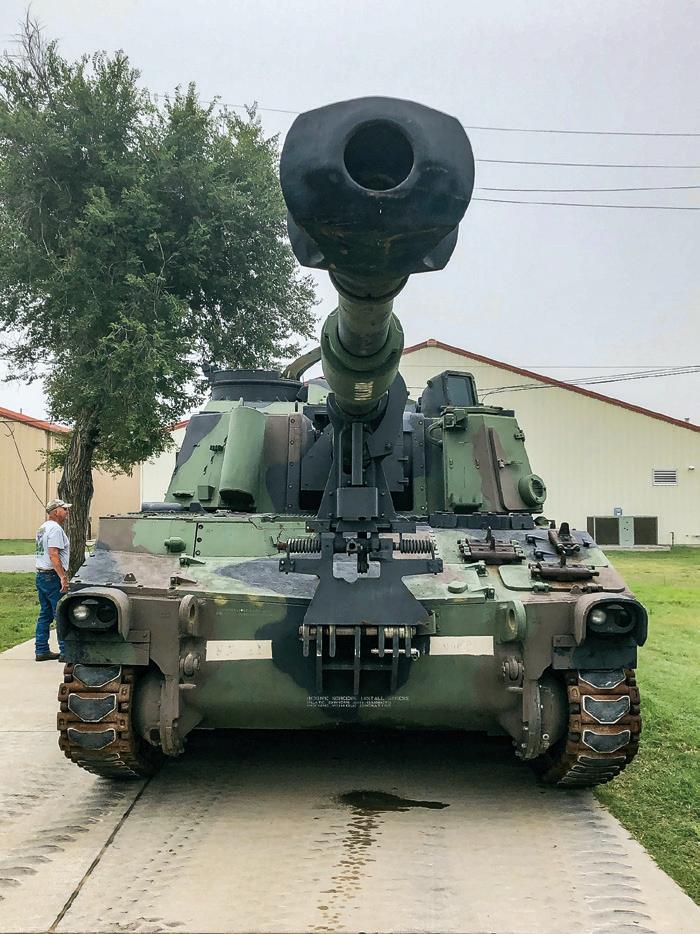
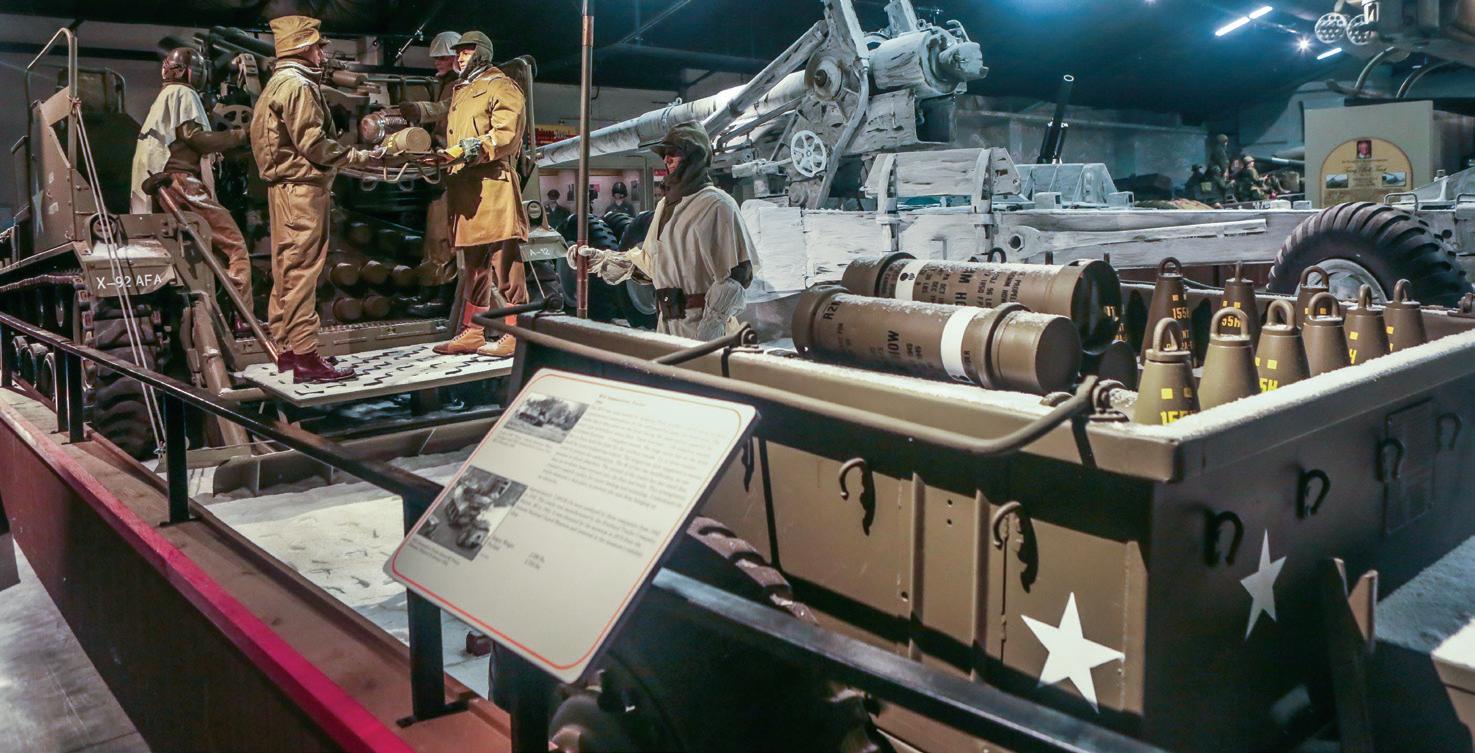


 M270 Multiple Launch Rocket System in position.
Exhibits Specialist Zane Mohler applying lettering to 155 mm projectiles.
M109A6 Paladin just before moving inside. Exhibits Specialist Zane Mohler provides a sense of scale.
M10 Ammo Trailer and M41 crew loading a projectile in Korean War Diorama.
M270 Multiple Launch Rocket System in position.
Exhibits Specialist Zane Mohler applying lettering to 155 mm projectiles.
M109A6 Paladin just before moving inside. Exhibits Specialist Zane Mohler provides a sense of scale.
M10 Ammo Trailer and M41 crew loading a projectile in Korean War Diorama.
SSG Jeffrey Fleming loading projectiles in the M109A6 Paladin. ArtillerymanMagazine.com | Vol. 42, No. 1 23
Volunteer Steve Burns working on the snow by the 155 mm powder canisters.
Macon Arsenal 10-Pounder Parrott
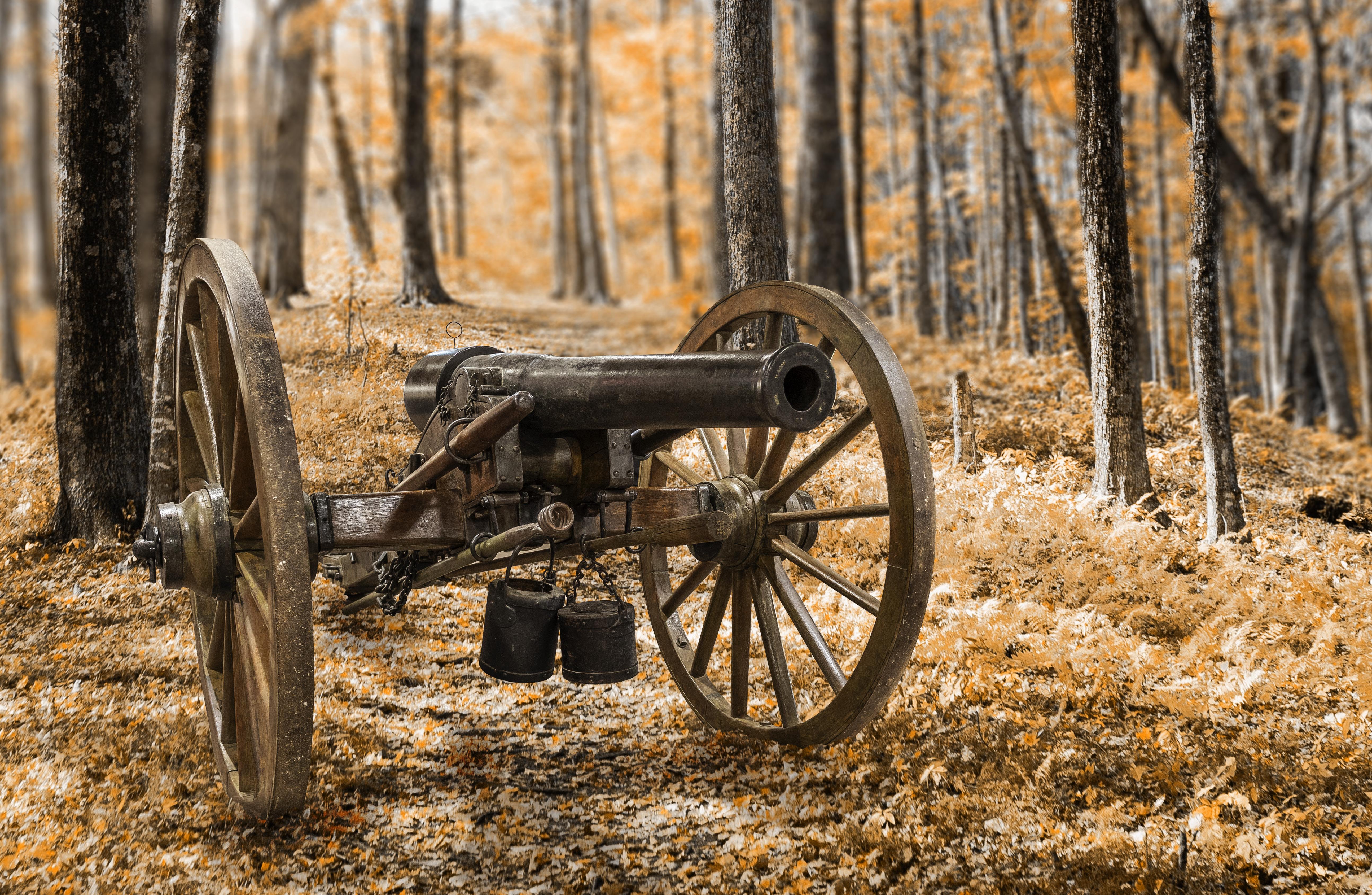
Ri e – Serial No. 8:
The Search for Its Battery
by Ken Knoll and Kerry Gossett

What we know, are three things: A) if you look in enough places, you’ll probably find what you’re looking for… eventually; B) if you’ll ask an expert in the field, you’ll probably get some advice that will help you find it faster; C) there is always more to be found. This applies to just about anything you want to research, but after a year and a half of searching for Ken Knoll’s Skates & Co. Confederate James rifle, those were the three caveats we had gleaned during our search.
After we had finished identifying not only the original Alabama artillery battery that received the Skates & Co. gun and also which battery had it when it was captured at Ft. Blakeley on April 9, 1865, we launched into another journey. Ken texted me: “I have a Macon Arsenal 2.9-inch 10-pounder Parrott rifle, the only one of 12 made
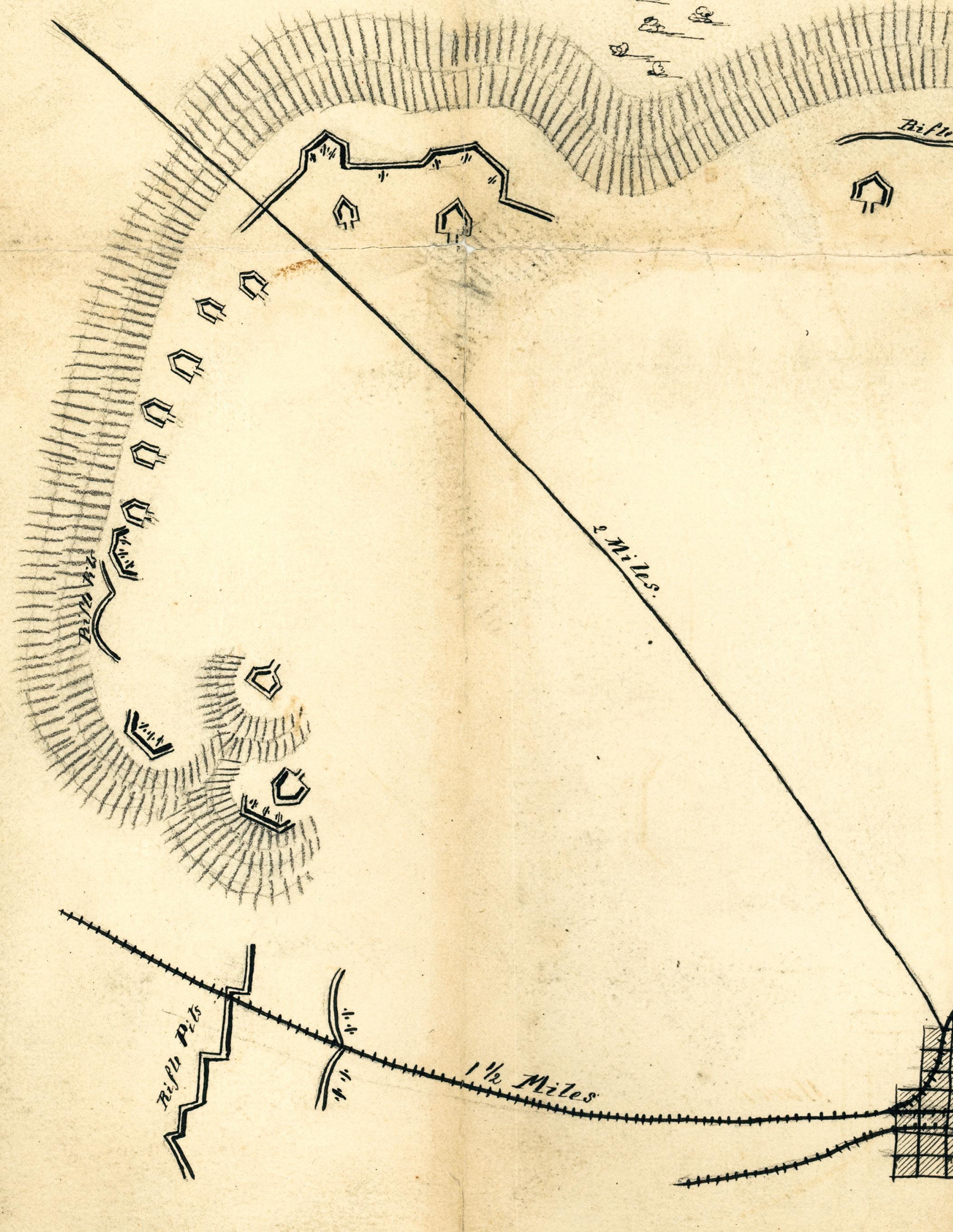
still around. I signed up to display it in Baltimore – end of March. I need to know who had the gun. The 2.9-inch is a 10# Parrott round, three grooves.”
I didn’t even hesitate, because the first search had been so challenging and gratifying that I replied, “Ok. I’m in.”
I remembered seeing something about a 2.9-inch round or gun somewhere during our earlier research, but I wasn’t looking for that type, so I moved on. A few texts later, we had our starting point, namely that the gun was cast at the Macon Arsenal in December 1863; the tube weight was 908 pounds, and the serial number on the muzzle face was “8.”

That’s basically it, but you start with what you have, and just methodically fill in around the facts you do have. You can add “weak” or unsubstantiated information, as long as you note that’s the case, and discard it
when it’s proven untrue. The facts will hopefully lead you to more, if not the whole story. It’s not easy. It’s tedious, frustrating, confusing, yet satisfying at the same time.
We began with the Fold3 files of Lt. Col. Richard M. Cuyler, who was at the Macon Arsenal in December 1863, Col. Gorgas in Richmond, and various ordnance officers in the Confederate Army of Tennessee, who would have been most likely to have signed for ordnance from Macon Arsenal, or who would have written letters requesting certain types of guns. We combed through reports in the Official Records of the War of the Rebellion, filed by the Chief of Ordnance of the Confederate Army of Tennessee during that time period, looking for artillery batteries that had captured Federal Parrott rifles, those that had been issued 10-pounder Confederate
The Artilleryman 26
Macon Arsenal 10-pdr. Parrott rifle, Serial No. 8, owned by Laura and Ken Knoll, received “Best Weapon” honors at the 65th Maryland Arms Collectors Association Show in 2019.
Parrotts before December 1863, or had lost them at the November 1863 Battle of Missionary Ridge, so those could be eliminated.
One useful source was the list of the gun types cast at the Macon Arsenal published in Larry Daniels and Riley Gunter’s book, Confederate Cannon Foundries That listed gun serial numbers, the dates they were cast, shipped, and delivered. The task of looking in the individual artillery company officer files for invoices or receipts of ordnance stores listing 2.9 caliber shot and shell followed. We were slowly but surely adding bits and pieces to the puzzle.
After sifting through several likely batteries and checking when they were issued their guns, we ran across an April 1, 1864, report in the ORs listing Capt. Winslow D. Emery’s Battery, Waddell’s Battalion, as having “4 – 10 pounder Parrott rifles.” We then started going through the Fold3 files of Maj. James F. Waddell and the two captains under him, Capt. Winslow D. Emery and Capt. Richard H. Bellamy.
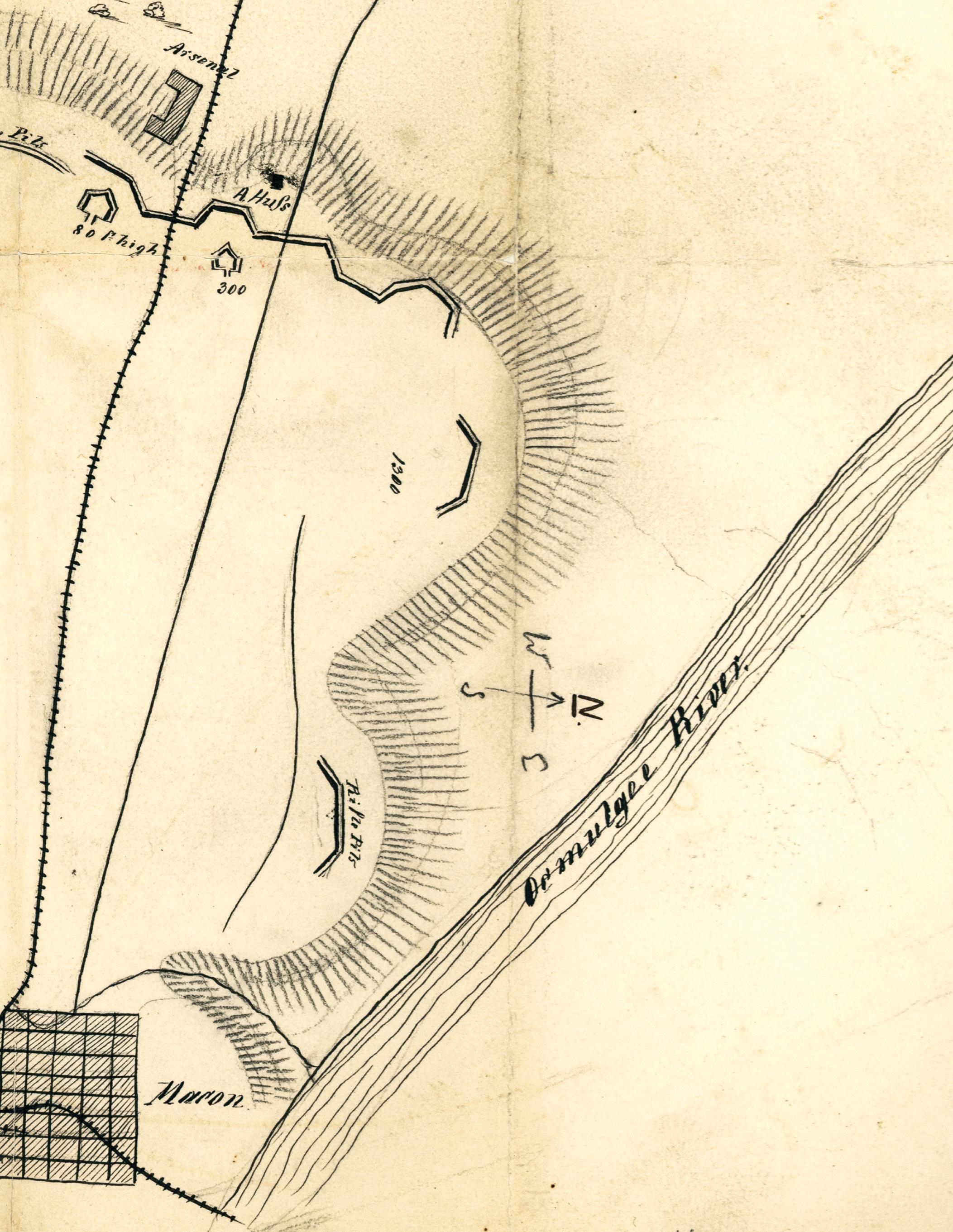
When researching a gun, it is very helpful to do a short history of the suspected “recipient” and “sister” batteries and start a chronology so dates and receipt of guns and ordnance stores can be viewed with clarity during the search. This involves looking at commanders’ orders, military store keeper receipts, and useful comments by individual soldiers, to confirm a fact.
Guns were used as “tools” by artillery battalions; much like a construction company uses different types of excavating machinery. Guns were issued and exchanged according to availability of ammunition or preference of guns, the types of topography encountered during a particular campaign or battle situation, wear and tear on the gun carriages, or maybe the rifling. The assignment of guns to a battery was not permanent; a battery might have certain guns for only weeks. As we examined the make-up of Waddell’s Battalion and the correspondence regarding it, we could see
many facets involving the arming of an artillery battery, and the difficulty a researcher has in trying to track the guns assigned to a particular battery.
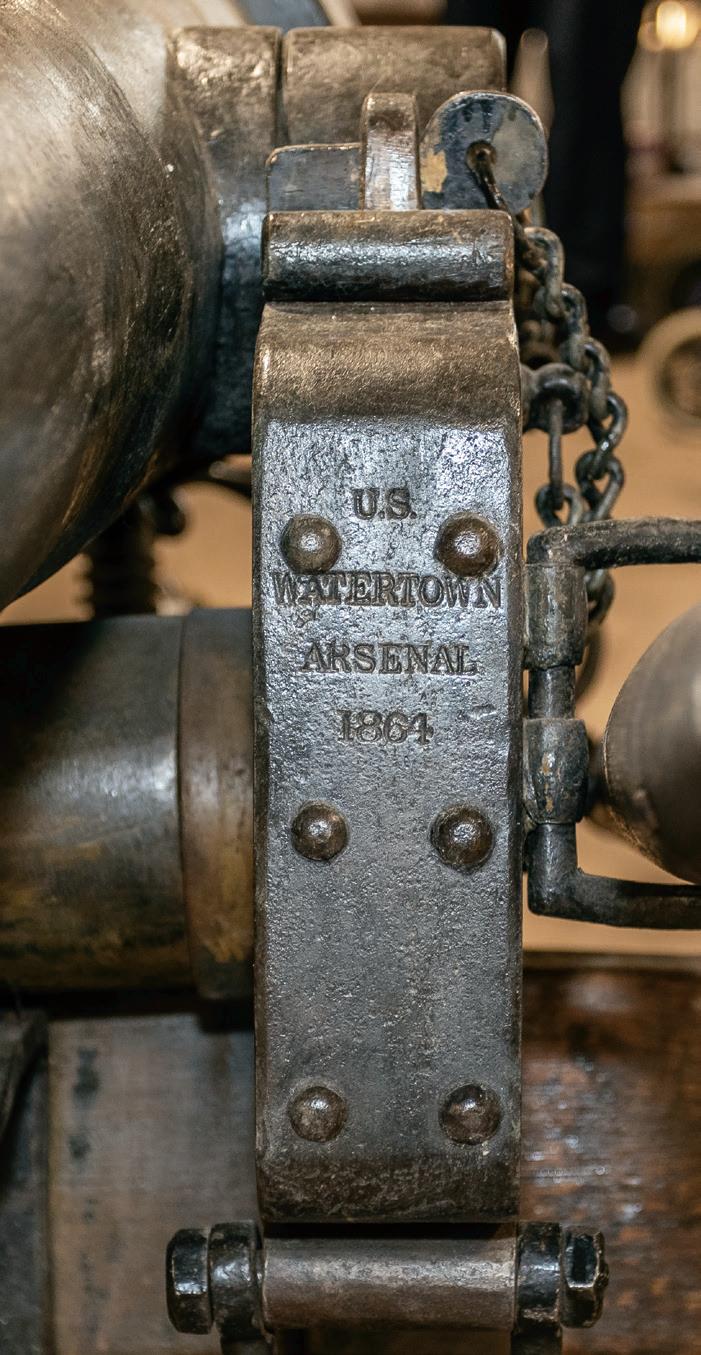
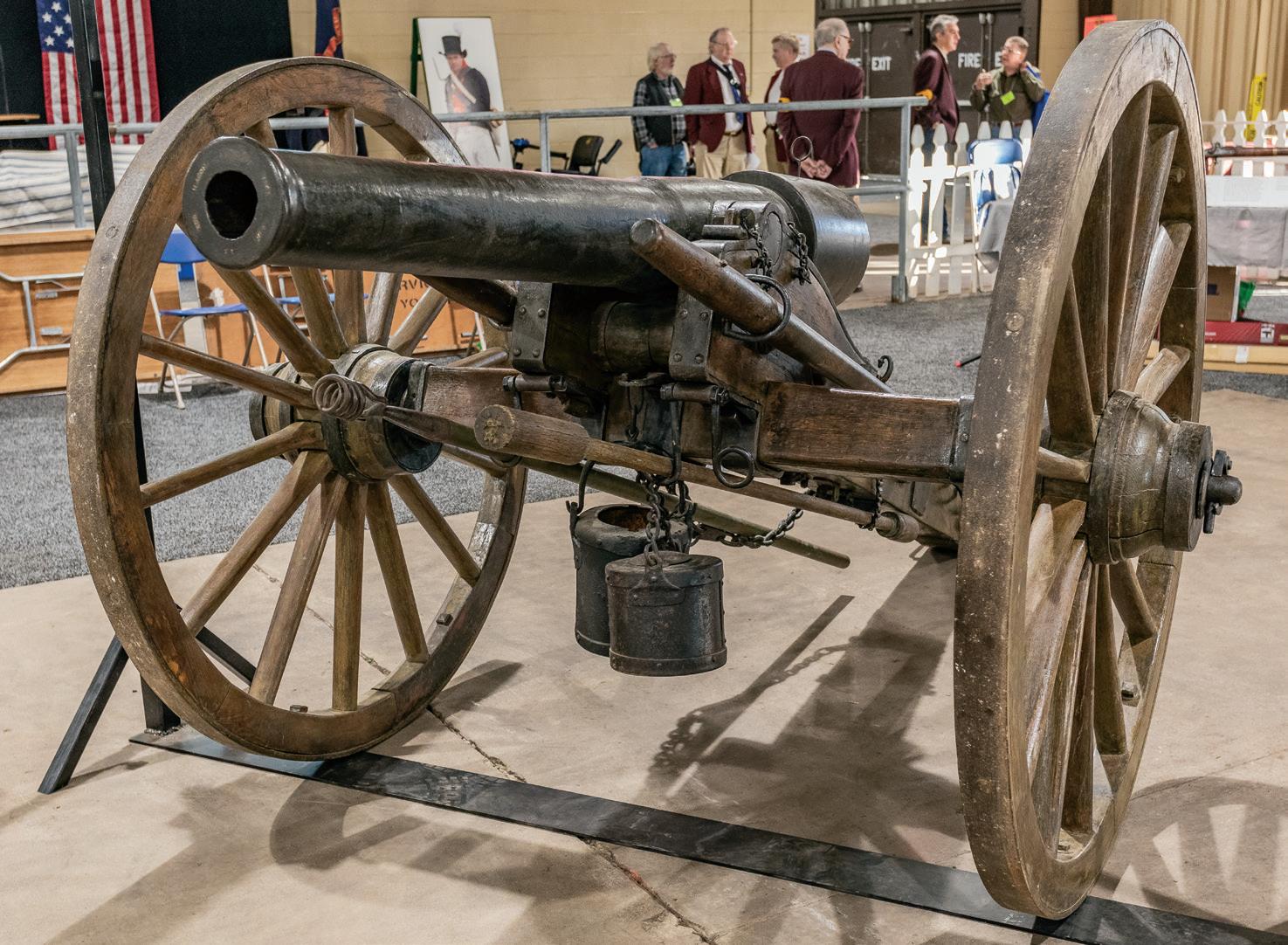
As a matter of historical perspective, Capt. James F. Waddell’s Alabama Artillery Battery was organized in February 1862, by an order allowing up to 20 men to be taken from each company of the 6th Alabama Infantry. His battery was in General Bragg’s Kentucky campaign, and was later transferred to Mississippi with Gen. Carter L. Stevenson’s Division. During the Siege of Vicksburg, it was captured, and lost all its guns in the surrender. After being paroled and exchanged on September 12, 1863, the battery was increased to battalion size, under the command of now Maj. James F. Waddell, and it was designated the 20th Alabama Light Artillery Battalion.
Waddell’s 20th Alabama Light Artillery Battalion consisted of Co. A commanded by Capt. Winslow D. Emery, Co. B commanded by Capt. Richard H. Bellamy, and sometime later Co. C. commanded by Capt. Thomas J. Key. It was organized in Columbus, Ga., in November 1863,
and was ordered to Dalton, Ga., to join the Army of Tennessee, where it was placed in the Reserve Artillery under Lt. Col. James H. Hallonquist.
U.S. Watertown Arsenal stamp appears on both iron trunnion straps.
ArtillerymanMagazine.com | Vol. 42, No. 1 27
The Confederate Macon Arsenal 10-pdr. Parrott rifle, Serial No. 8 is mounted on a U.S. Watertown Arsenal carriage, with all original wood and iron hardware, including the original iron lunette.
According to Larry Daniels’ book, Cannoneers in Gray: The Field Artillery of the Army of Tennessee, (2005), on page 136:
“The next month, [January 1864] Major James Waddell’s battalion of two Alabama batteries – W. D. Emery’s and R. H. Bellamy’s – arrived at Dalton. They had been exchanged since the surrender at Vicksburg, but needed horses and field guns.”
As of an Army of Tennessee reorganization report on February 29, 1864, Waddell’s was the “Third Battalion” of Hallonquist’s Reserve Artillery, and at this point, consisted only of Emery and Bellamy’s Alabama batteries. Organization of the battalion was at Columbus, Ga., after Sept. 12, 1863, and probably through October 1863. However, at some point, Major Waddell was at Decatur, Ga., the depot were all his battalion’s equipment and guns were being collected, before reporting to Dalton. Apparently, Waddell’s two batteries, Emery’s and Bellamy’s, weren’t issued guns until April 1, 1864. There were some quality “issues” with guns and ammunition coming from Tredegar and Macon, as well as other arsenals, so maybe the delay was due to inspections and recalls.
On November 19, 1863, a telegram sent by Lt. Col. Richard M. Cuyler of the Macon Arsenal to Col. Hypolite Oladowski at Missionary Ridge in Chattanooga, Tenn., stated:
“Col. Oladowski, I have a battery of Napoleons for you. Col. Gorgas asked if you will consent that it be given to Maj. Waddell at Decatur [Georgia]. Answer.
Richard M. Cuyler
Lt. Col.”
However, Colonel Gorgas apparently changed his mind about the 12pdr. Napoleons, or there was a more pressing need elsewhere, and they were given to another battery, so
Waddell’s two batteries were late receiving their rifled guns; 10-pdr. Parrotts for Emery’s Battery, and Blakely rifles for Bellamy’s Battery. The first report to show the armament of the two companies of Waddell’s battalion, is on April 1, 1864, stating that Emery’s Battery had four 10-pdr. Parrott rifles and Bellamy’s Battery had two 6-pdr., 2 ½-inch Blakely rifles, and two 12-pdr., 3 ½-inch Blakely rifles.
The following is a letter by Colonel Gorgas in Richmond to Lt. Col. H. Oladowski in Dalton, Ga., dated January 2, 1864:
“Ordnance Bureau
Richmond Jany 2nd 1864
Col.
A battery of 10 pounder Parrott guns is reported ready at Macon. If Genl Johnston requires them please to inform me in order that the necessary directions may be given.
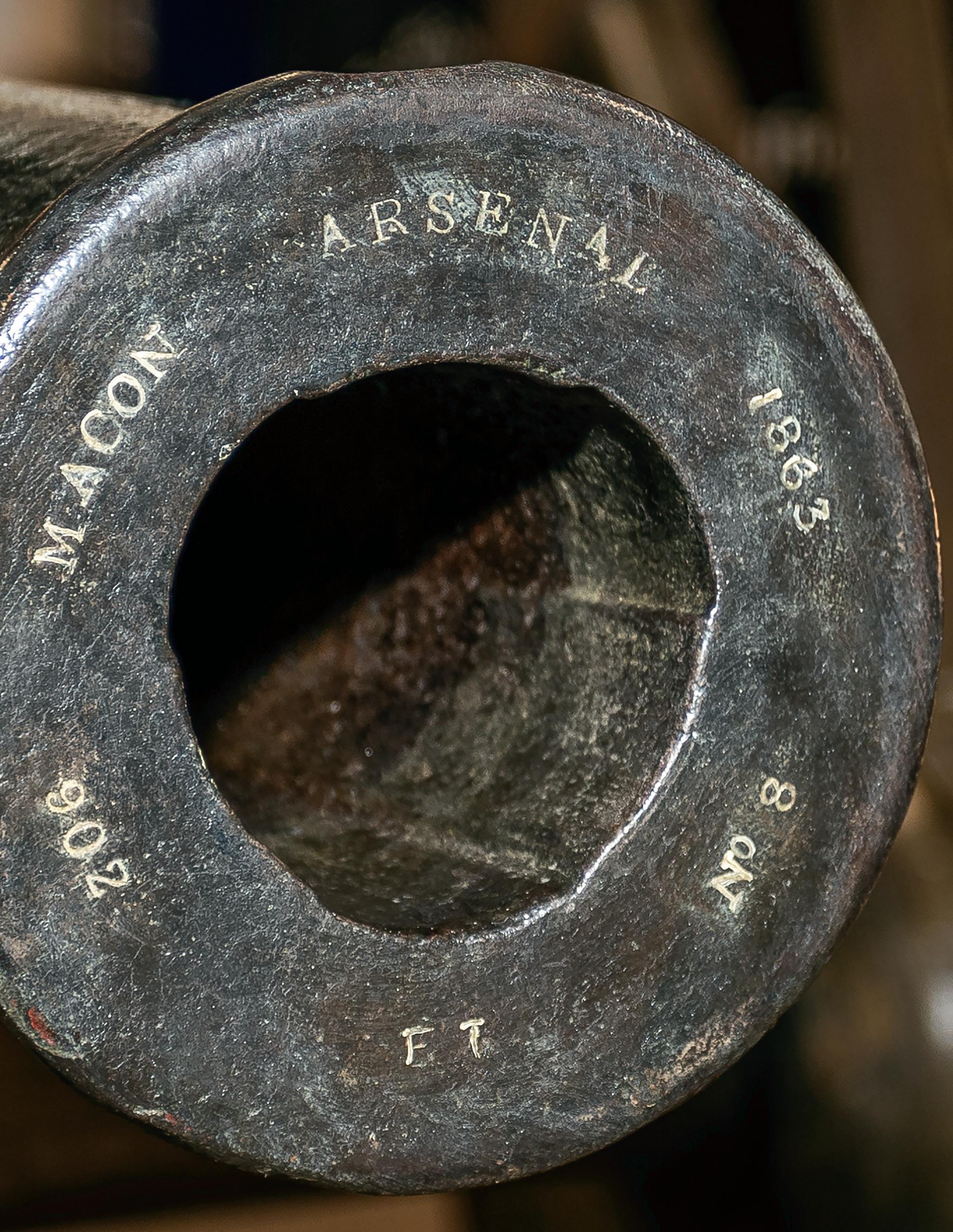
Very Resy, Yr obt svt
J. Gorgas Colo.
Chf. Of Ord.
Lt. Col. H. Oladowski
Chf. Ordnance officer
A of T
Dalton, Ga”
The following is a letter by Maj. Thomas Bayne in Colonel Gorgas’ office to Lt. Col. Oladowski in Dalton, dated January 16, 1864:
“War Department Ordnance Office
Richmond Jan 16th, 1864
Colonel:
I am directed by Col. Gorgas to inform you that the ‘Battery of 10 pdr Parrott Guns’ have been ordered from Macon to you at Dalton.
Respectfully
Thos Bayne Maj
on duty with Chief of Ordnance
Lt. Col. H. Oladowski
Chief Ord. Officer
Army of Tenn, Dalton”
The following correspondence was
from Capt. Isadore P. Girardy to Major Waddell in Decatur, Ga. Captain Girardy did not know that Major Waddell was away in Richmond. Either Captain Girardy was misinformed, or as senior captain in temporary command of the battalion, Captain Emery changed the gun assignment, because Captain Emery’s battery received the Parrott rifles, and Captain Bellamy’s battery received the Blakely rifles, as evidenced by the Army of Tennessee artillery report of April 1, 1864.
“Hd. Qtrs. Gunworks
Augusta Ga
Feby 4th, 1864
Major,
I forwarded per yesterday’s Express Co. Train one box of 2 ½ in & 3 ½ in Shells for Capt. Emery’s Battery of your Batt. for trial. You will please Inform me at once if they fit the caliber of their pieces in order to finish those on hand at once, to be forwarded to you. The Parrott ammunition will be sent with harness this week, they are now being packed –
I remain in haste
Respectfy Yours
I. P. Girardy [illegible]
Major J. F. Waddell
Chf of Arty
Decatur Ga”1
Captain Emery’s letter to Col. Moses Hannibal Wright, Commander at Atlanta Arsenal.
“Hd Qtrs 20th Bat Lt Artillery
Decatur Ga Feby 9th, 1864
Col
Your note with order to Maj. Waddell is received. Enclosed please find report for transportation. In addition to ordnance enumerated in report, I have four (4) twelve (12) pdr Howitzers with ammunition which I have been ordered to turn in to Atlanta Arsenal as soon as the ammunition for the two Rifle batteries arrives from Augusta. Enclosed please find Capt. Girardy’s letter in relation thereto.
The Artilleryman 28
Maj. Waddell is absent in Richmond.
I am Sir your obt Servt.
W. D. Emery
Capt. Co. “A” Comdg Battalion
To Col M H Wright
Comdg at Atlanta Ga”2
In a letter to Colonel Oladwoski in Dalton, dated Feb. 13, 1864, Captain Girardy wrote:
“I am endeavoring to supply you with as much [sic many] projectiles for your Rifle Batteries as possible. I have forwarded 200 Rounds to Major Waddell and in a few days shall sent 200 more.
The Napoleon Battery now ready and in the most-complete-style, has been ordered to Demopolis Ala for Gen. Lee’s Command. I was in hopes to send it to you, in fact it was ready marked to your address, when the change of direction was received.”3
Telegraph from Captain Girardy to Colonel Oladowski in Dalton:
“Two Hundred rounds ammunition for Waddell’s Battery has been forwarded – Shall send two hundred more this week. The Napoleon Battery is ordered to Demopolis but will soon have and ready.”
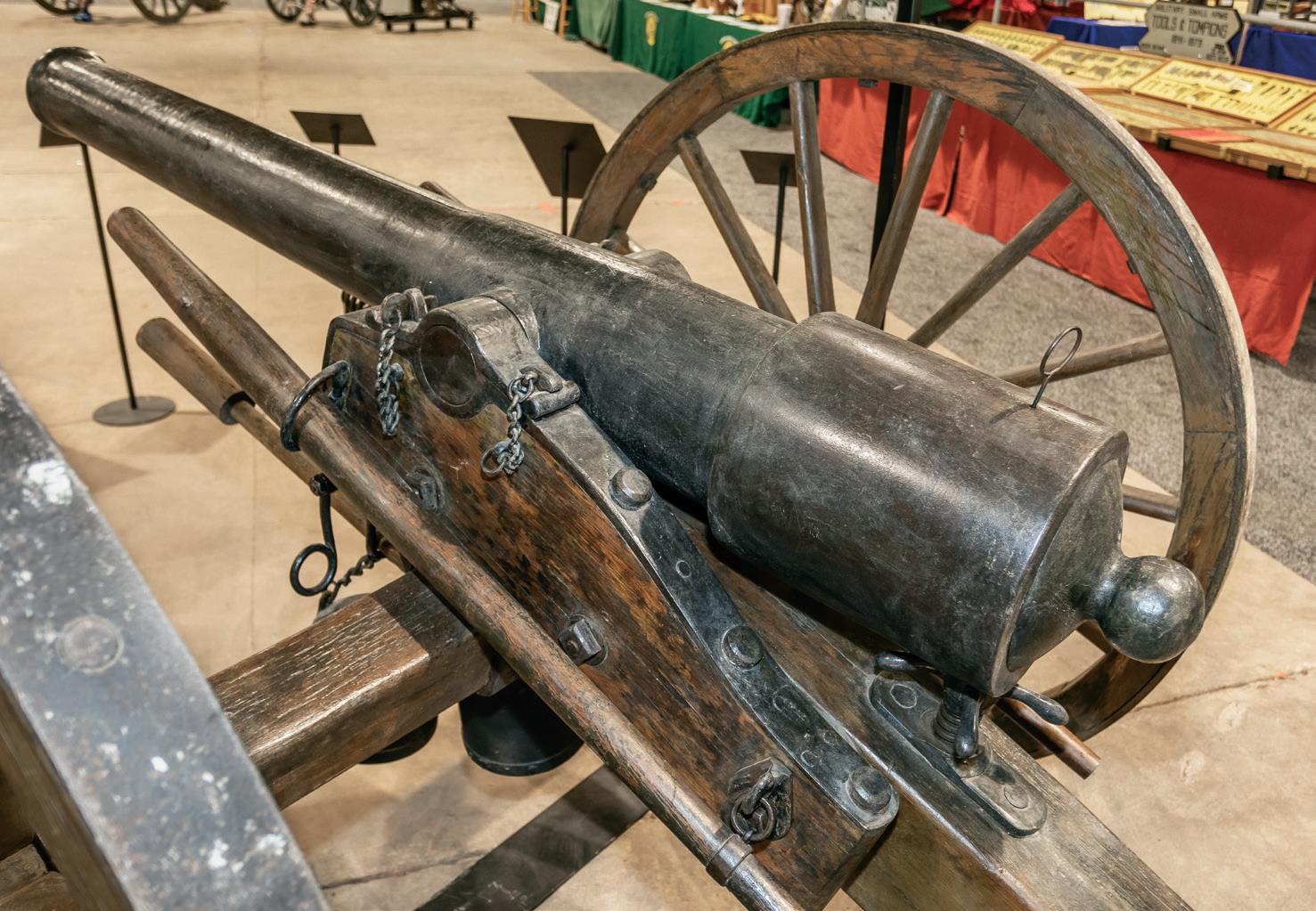

Telegraph from Captain Girardy to
Muzzle face: Macon Arsenal; rifle was cast December 13, 1863; the tube weighs 902 lbs.; serial no. 8; and the Confederate inspector’s initials
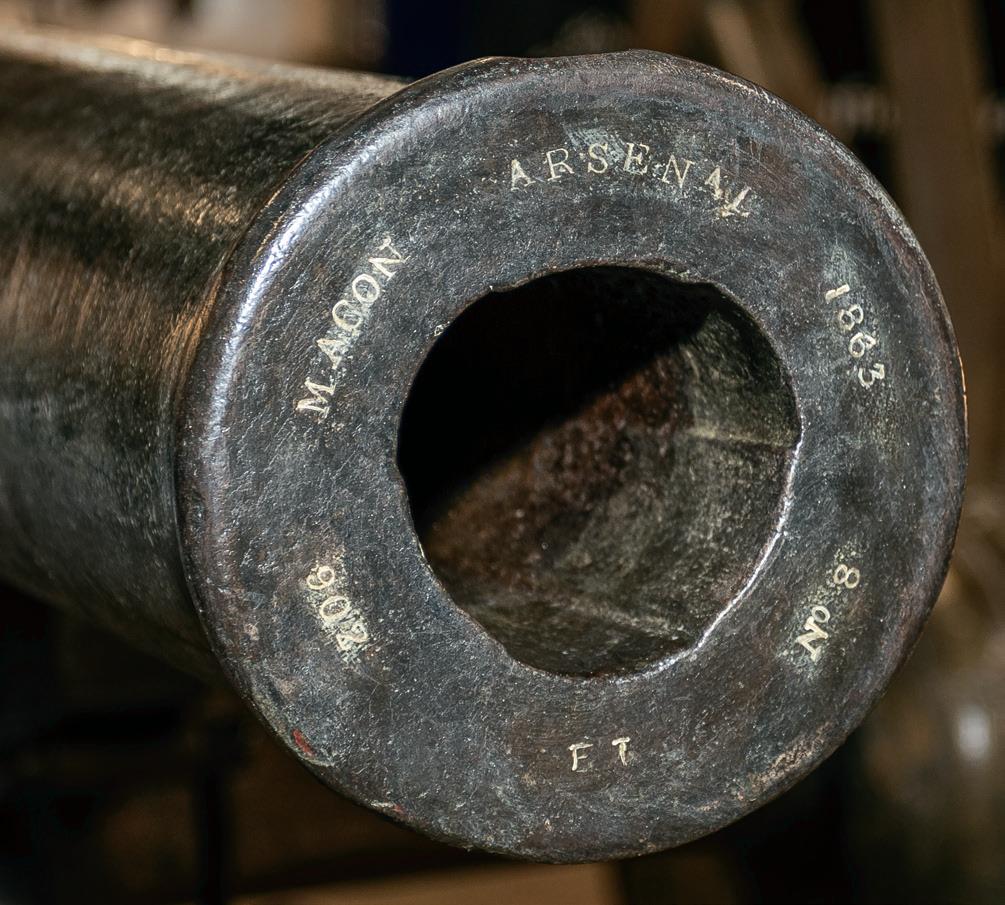
 “E. T.”
Angled views of the Macon Arsenal 10-pdr. Parrott rifle with a priming wire inserted in the gun’s vent. Both trunnions are unmarked.
Side view of the rifle’s muzzle, showing the mold seam that indicates time was not wasted on turning the whole tube on the lathe, but rather only the area of the breech where the reinforcement band was shrunk on, and the trunnions.
“E. T.”
Angled views of the Macon Arsenal 10-pdr. Parrott rifle with a priming wire inserted in the gun’s vent. Both trunnions are unmarked.
Side view of the rifle’s muzzle, showing the mold seam that indicates time was not wasted on turning the whole tube on the lathe, but rather only the area of the breech where the reinforcement band was shrunk on, and the trunnions.
ArtillerymanMagazine.com | Vol. 42, No. 1 29
Cololonel Oladwoski in Dalton, dated February 18, 1864:
“Two Hundred Parrott shells & artillery harness shipped on the Eighth instant addressed to Maj. Waddell – Decatur, Ga, and turned over to Quarter Master at that point by a Messenger.
I. P. Girardy”4
On March 15, 1864, Captain Girardy wrote to Colonel Oladowski in Dalton:
“I had sent to Capt. Emery of Major Waddell’s Batt for trial, but having heard of no complaint from them, I proceeded (in obedience to orders) to cast from the same pattern.”… “I have always been of your opinion concerning the charges for Rifled Guns; as often it is owing for this cause that guns proof ineffective.”5
On Oct. 31, 1864, a receipt from Richard Lambert, Military Store Keeper at the Macon Arsenal, shows Captain Bellamy signed for four 12pdr. howitzers, as well as four carriages, two caissons, and six limbers.6
Things for Waddell’s Battalion, and subsequently Emery’s Battery were quiet during most of their time at Columbus, Ga., as they defended the city, with its arsenal, Navy yard, and all the factories producing goods for the Confederate forces, until spring 1865.
In Charles A. Misulia’s book, Columbus Georgia 1865; The Last True Battle of the Civil War, on page 116, discussing the Confederate troops manning some of the defenses in Columbus on the evening of April 16, 1865, he writes:
“Farther south, just to the north of Fort 1, members of Waddell’s artillery battalion manned six rifled cannon, mostly Parrotts [four of the six guns would have been Emery’s Parrott rifles], which were stationed near Jackson Street. They were protected
by a low set of hastily constructed earthworks forming an inner semicircle surrounding the entrance to the Franklin Street Bridge, but through which passed two streets that led to the bridge’s mouth. Inside Fort 1, members of Barrett’s Missouri Battery manned four 12-pounder howitzers.”
Then on pages 146 and 147, a description of Waddell’s artillery battalion, i.e. Emery’s and Bellamy’s batteries, being captured at Girard, Ala., across the Chattahoochee River from Columbus as Gen. Emory Upton’s Federal cavalry troopers rushed upon them, past multiple burning buildings, in an overwhelming night attack.
“The guns of Waddell’s artillery battalion were stationed across the streets and the lawns north of Fort 1, near the intersection of Jackson and Brodnax streets at the south of the tete-de-pont, and were protected by a hastily constructed redoubt.”....“Part of the battery stationed near Jackson Street in Girard [Alabama] opened fire on the approaching Federals as their ranks were exposed by the radiance of the flames. Uncertain of what to do but unwilling to blast the many Confederates who were still in their front, the rest of the battery held their fire. Within moments, the cannoneers realized that all was lost and began to abandon their pieces.”
The Federal troops were those of Capt. Abraham’s 4th Iowa’s 1st Battalion. The shock of the attack had been too great. On page 147, the account of the attack states:
“At the battery, Abraham led his battalion in an intense hand-to-hand melee with a few determined artillerymen, but within moments the remaining Confederate cannoneers broke and fled eastward down the hill toward the bridge.”
There we have the fate of Emery’s four 10-pounder Parrott rifles,
and most probably the Macon Arsenal Parrott, “Serial No. 8.” We know that Capt. Emery was issued the four Macon Parrott guns originally, including “No. 8,” and since we don’t find evidence that those guns were exchanged, although they could have been, we feel confident that the gun was captured by Capt. Abraham’s Federal troopers on April 16, 1865.
There are many stories just like the one about the Macon Arsenal 10-pounder Parrott rifle No. 8, that are still to be discovered, whether Federal or Confederate in nature. As pleasurable as it is reading about battles, for those interested, bringing alive through extensive research the hidden stories of individual cannon, presentation swords, lost revolvers, etc., can be extremely gratifying. There is a potential for resurgence of interest in the tragic and complicated American Civil War, that is just waiting for us to do the research and do our part.
Endnotes:
1. Capt. Winslow D. Emery, Fold3 file, p. 27.
2. IBID, Fold3 file, pp. 24-25.
3. Capt. Isadore P. Girardy, Fold3 file, p. 162.
4. IBID, Fold3 file, pp. 282.
5. IBID, Fold3 file, p. 160.
6. Capt. Richard H. Bellamy, Fold3 file, p. 70.
Ken Knoll is an owner of a Structural Steel Co. He specializes in collecting Civil War artillery.
Kerry Gossett is an Alabama native, who is a retired Certified Registered Nurse Anesthetist, former Civil War reenactor with the 28th Alabama Infantry, genealogist, and history researcher, who has been interested in the American Civil War since 1962. During retirement, Kerry has enjoyed doing “deep dives” into subjects of the Civil War and looking at those subjects through intense research to ferret out little known facts and concepts.
The Artilleryman 30
Historical Ordnance Works
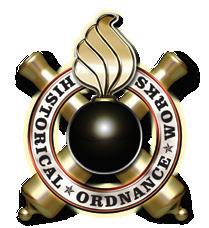
Builders of museum quality Civil War era artillery carriages. Authentic reproduction implements. Restoration of original ordnance.

Thomas J. Bailey
PO Box 2236, Woodstock, GA 30188 (770) 928-2298 • www.historicalordnanceworks.com
GOEX l SCHUETZEN SKIRMISH l KIK l SWISS
We ship mixed 5, 10 & 25 lb. cases Cap and Ball Pistol Loaders RWS Musket, #11 caps, Schuetzen musket caps and Friction Primers WWW.POWDERINC.COM
jerry@powderinc.com toll-free (877) 833-1799
Powder Inc., 1861 North College Ave., Clarksville, AR 72830
 Master Distributor for GOEX POWDERS
Master Distributor for GOEX POWDERS
ArtillerymanMagazine.com | Vol. 42, No. 1 31
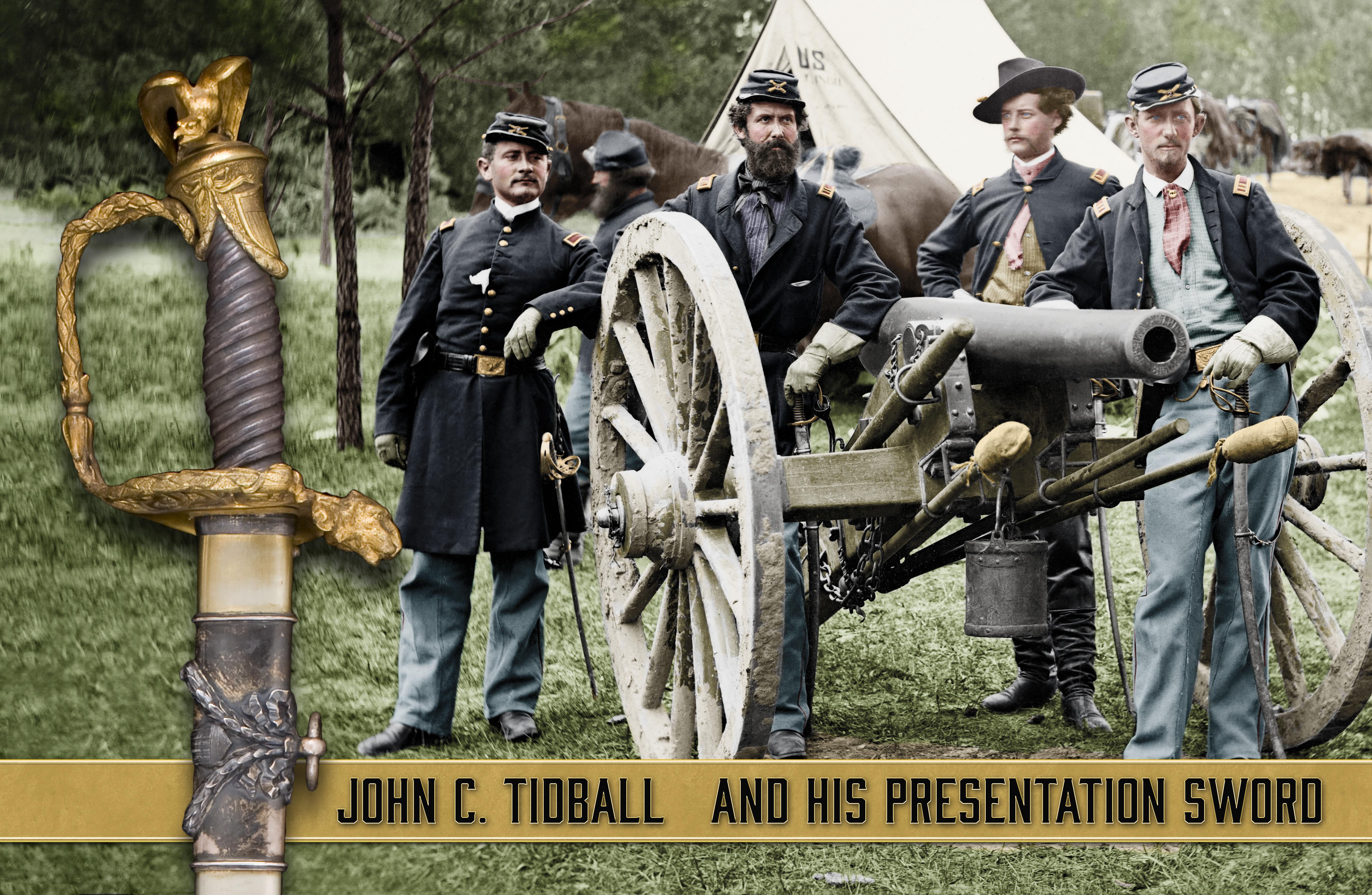
 by Gordon Blaker
by Gordon Blaker
Ihad been a collector of swords, specifically Imperial German Army ones, for over twenty years in 1997.
One day a gentleman seeking my assistance in selling a family sword approached me. The sword was a Civil War presentation piece. I had never had any interest in presentation pieces because they seemed overly gaudy. The name on the sword, Captain John Tidball, an artillery officer, meant nothing to me. We went over the many ways he could sell it, advantages, disadvantages, and approximate timeline for each option. He explained he was in a desperate situation and needed the money immediately. There was something beautiful and elegant about this sword that drew me to it so I did something very spur of the moment. Quickly figuring out how much cash I could come up with by the next day, I made him an offer. He accepted and the next day a Civil War presentation sword was mine so there some research ahead.
The first thing that an old friend told me about was the sword’s maker. Of course, I knew the name Tiffany, but was not aware that they made high end Civil War presentation swords.
The sword has an ornate pierced gold guard with an eagle perched atop the pommel. The presentation, from the non-commissioned officers and privates of Light Company A, 2nd U.S. Artillery, on the scabbard is dated January 1, 1864. Over many years, I learned more about the remarkable owner, Captain John C. Tidball. The following is his story.
John Caldwell Tidball was born to William and Maria Caldwell Tidball on January 25, 1825, in western Virginia near Wheeling Creek. In 1830, the family moved twenty-five miles west to Belmont County, Ohio, settling along the National Road. William Tidball opened a country store in the new town of Hendrysburg. John’s mother died on his ninth birthday of consumption. Young John went to school, clerked in the store, and helped work the family’s 100-acre farm.
At the age of seventeen, John sought admission to the U.S. Military Academy. He achieved his goal and arrived at West Point on June 7, 1844. At the academy, Tidball received his best grades in chemistry and mathematics. He also perfected a natural talent for drawing, an important skill taught at the Academy. In tactics, he found his true calling in the light artillery and it would become his lifelong profession. He graduated in June 1848, finishing eleventh in his class of thirty-eight.
As a new second lieutenant of artillery, Tidball joined Battery E, 3rd Artillery at Fort Brown, Texas. After a brief stay, his battery was transferred to Fort Adams, Newport, R.I. In Newport he met his future wife, Mary Hunt Davis, the adopted daughter of the regimental surgeon. His next assignment was to Company M, 2nd Artillery, Oglethorpe Barracks, Savannah, Ga., and then up the Savannah River to Augusta. In June 1849, Company M was sent to Florida
upon the threat of a third war with the Seminoles. In Florida, the company served as construction workers, rather than artillerymen, building roads and bridges. Fortunately for history, Tidball was a prolific writer throughout his life and most of his writings survive, leaving a valuable record of his experiences. He remembered his time in the hot, humid disease-ridden terrain as the most difficult of his long Army career.
Tidball was promoted to first lieutenant on March 31, 1853. John married Mary Davis in Philadelphia on May 27, 1853, just before departing for Fort Defiance, New Mexico Territory. There, 1st Lt. Tidball was selected to join an expedition to explore a possible railroad route along the 35th parallel. During this challenging expedition, he made detailed notes on the flora and fauna along with many fine illustrations. A number of his illustrations were published in the official Pacific Railway Reports. Upon reaching Los Angeles, the expedition was disbanded in March 1854, and Tidball took a ship back to New York City. In Newport, he reunited with Mary following a yearlong separation; the couple then moved to Carlisle, Penn., to await his next assignment.
His next assignment was a return to Fort Defiance, but this time in charge of 150 recruits. Accompanied by Mary, he was leading his command across the Kansas prairies when a courier overtook them. Tidball received orders to immediately report to the U.S. Coast Survey in Washington, D.C. There he successfully completed a number of assignments leading to his becoming head of the Drawing Department in August 1855. During John and Mary’s time in Washington, the couple had two sons prior to Mary’s death in January 1858. His young sons went to live with John’s father in Ohio.
After serving over four years with the U.S. Coast Survey, 1st Lt. Tidball returned to the artillery service. He was first posted to Fort Monroe, Va., with Battery B, 2nd Artillery in the autumn of 1859, then reassigned to Battery A at Fort Leavenworth, Kansas, in June 1860. As the nation approached war, his battery was one of a number of units quickly moved to the capitol in January 1861. After a brief time, the battery moved to Fort Hamilton, N.Y., where they boarded ship for a secret destination.
Two weeks later, in April 1861, Tidball and Battery A unloaded at Fort Pickens, Fla., where they guarded the entrance to Pensacola Bay. While at Fort Pickens Tidball was promoted to captain and given command of Battery A. His pride at the promotion paled in comparison to receiving command of one of the Army’s most famous light artillery units.
In June 1861, Battery A was relieved, returned to New York City, and then south to Washington, D.C., arriving on July 16. At Washington Arsenal, the unit hastily loaded ammunition and moved south to Centreville, Va., to join the newly formed Union Army. July 21st found Tidball’s
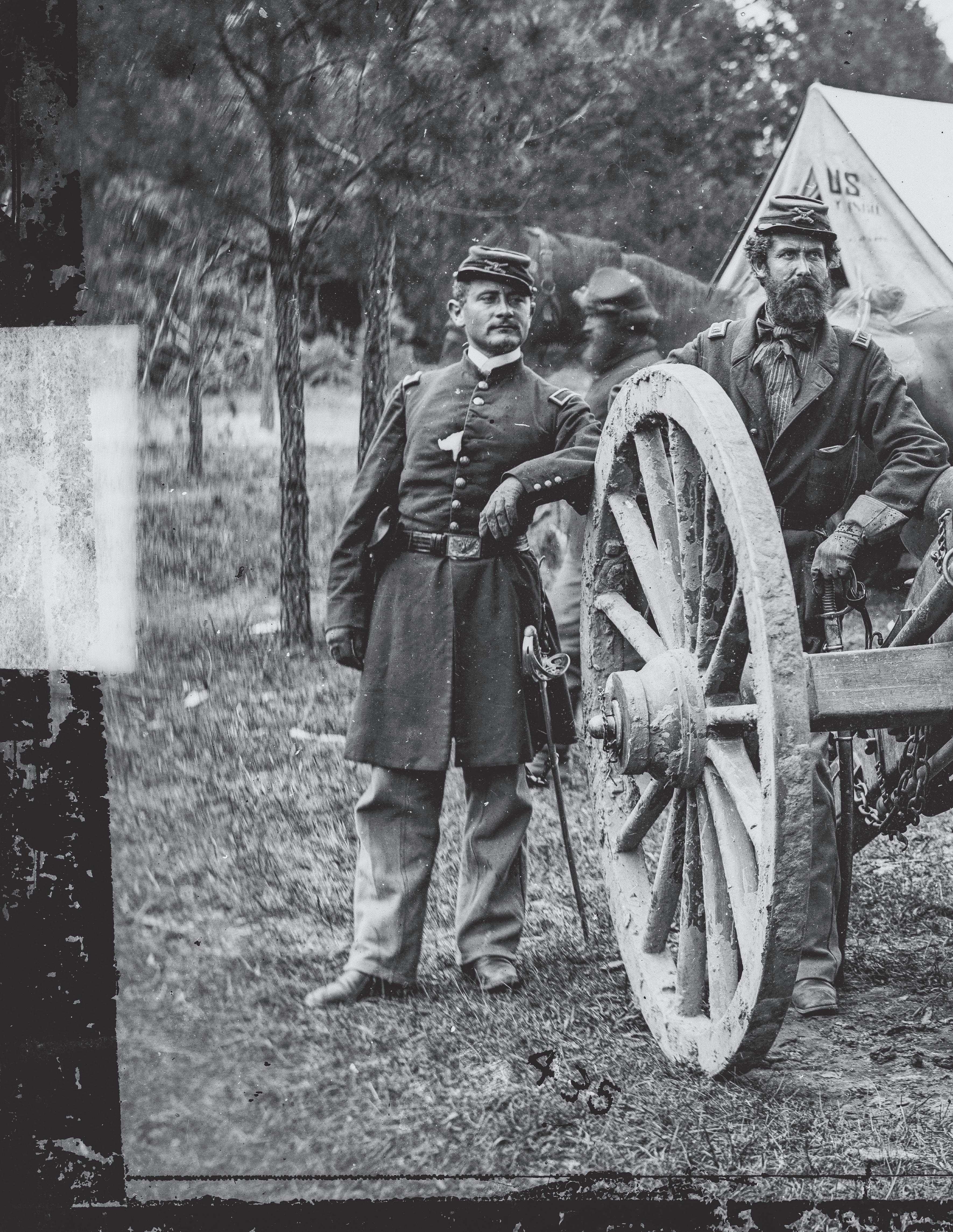
The Artilleryman 34
Battery A, 2nd Light Artillery with two 6-pdr. smoothbore bronze guns and two 12-pdr. howitzers stationed on a knoll along the Warrenton turnpike as part of the army reserve. From this position, Tidball witnessed the headlong retreat of the Union Army following the defeat at Bull Run.
In the autumn of 1861, Captain Tidball reorganized his battery as the first horse artillery battery, in which all his soldiers were mounted as opposed to some riding the ammunition chests of the limbers and caissons. This gave his battery, now armed with six 3-inch ordnance rifles a considerable advance in speed of movement.
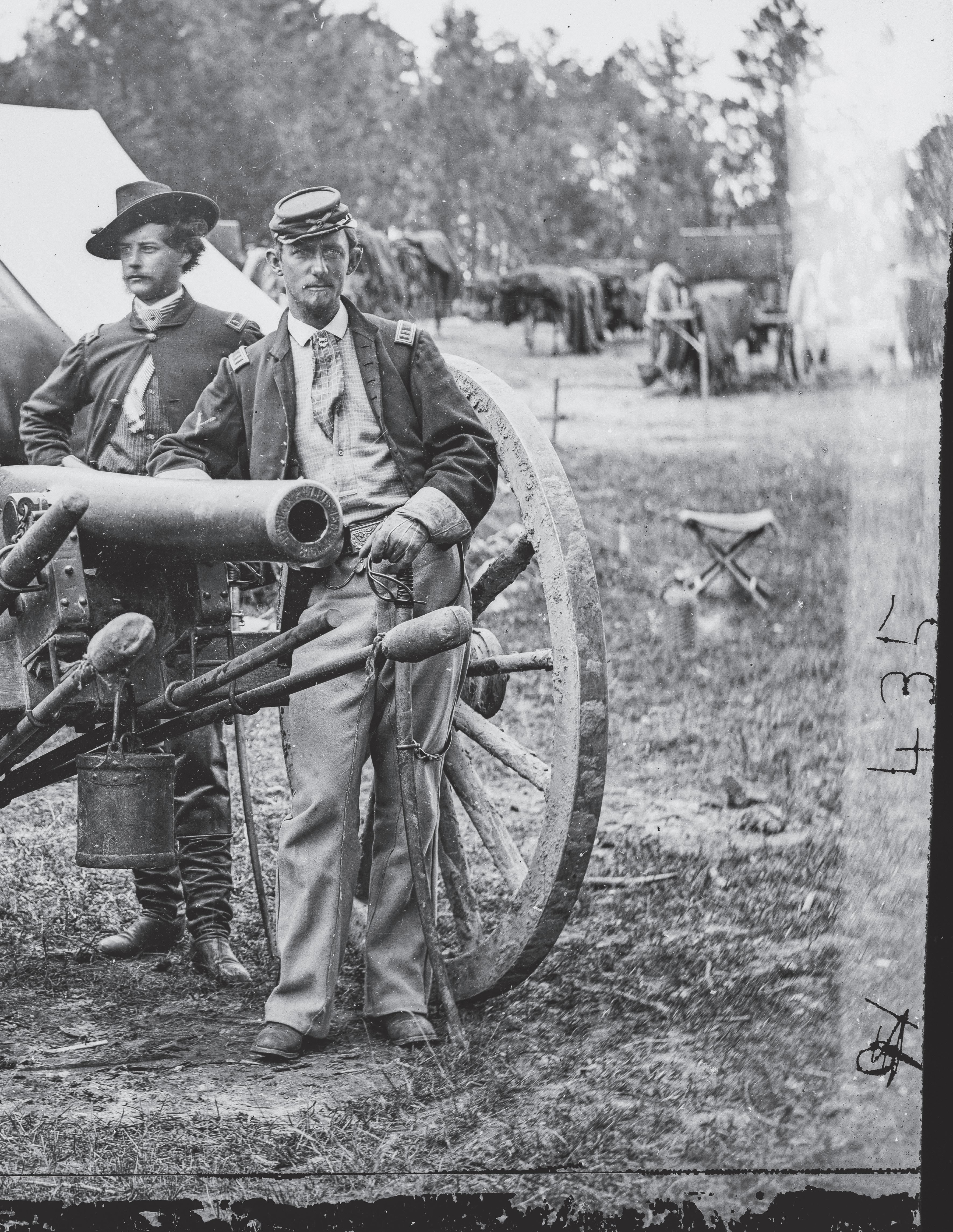
In spring 1862, General McClellan launched the Peninsula Campaign with Battery A, 2nd Artillery serving in the 1st Artillery Brigade attached to General George Stoneman’s Cavalry. The four batteries of horse artillery, 24 guns, were capable of keeping up with Stoneman’s horsemen. On May 5, 1862, Tidball and his battery fought their first battle at Williamsburg, Va., joined the pursuit of Confederate forces up the peninsula, engaging in numerous engagements including the battle of Mechanicsville on May 24.

peninsula. Tidball’s Battery fought as part of the rearguard at Mechanicsville, and then again at Gaines’ Mill with General Fitz John Porter’s V Corps. Following the action at Gaines’ Mill, General Porter recommended Tidball for promotion to brevet major. Battery A continued their excellent rearguard service at the Battles of Glendale and Savage Station. At Malvern Hill, Battery A was brought into the artillery line late in the battle and played a major role in stopping the last Confederate infantry assault. Tidball shared the disappointment of most Union officers with McClellan’s retreat after the battle that ended the Peninsula Campaign. Battery A was one of the last units to depart the peninsula on July 2nd bound for New York.
In September 1862, Tidball’s old friend and mentor, Henry Hunt, was appointed Chief of Artillery for the Army of the Potomac. Tidball and his battery joined five other horse artillery batteries assigned to General Alfred Pleasanton’s Cavalry Division.
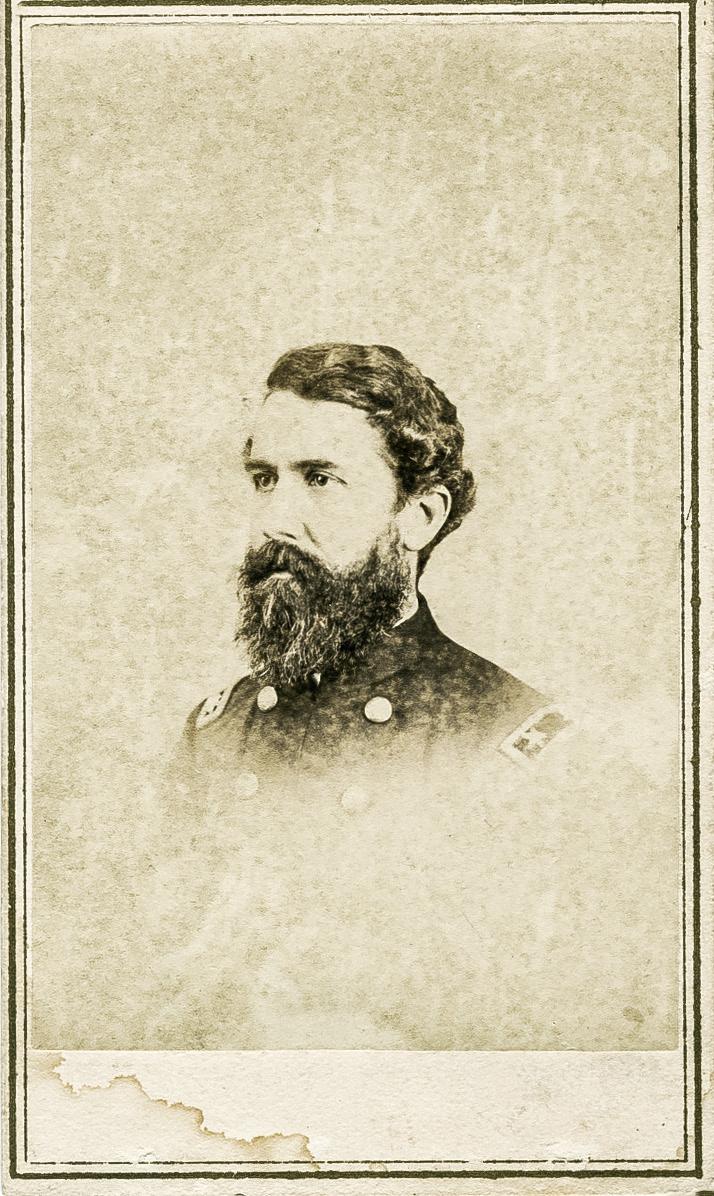
Carte de visites of Brevet Brigadier General (left) and Colonel Tidball (right).
The famous photograph of Captain Tidball was taken of Battery A’s officer’s (left to right: Lt. Robert Clarke, Capt. John C. Tidball, Lt. William N. Dennison, and Capt. Alexander C.M. Pennington) at Fair Oaks Station on June 1 by photographer James Gibson (see title pages, courtesy Library of Congress. Colorized by CivilWarInColor.com) It shows a full-bearded Tidball and his three lieutenants wearing an interesting array of uniforms around one of their 3-inch ordnance rifles (No. 247, dated 1862).
On June 25, the Seven Day’s Battles began at Oak Grove as McClellan’s Army began its withdrawal down the
On September 16, from a hill overlooking Antietam Creek, Tidball’s battery fired the opening shots of the war’s bloodiest day. On the 17th, Tidball’s guns devastated Confederate infantry in Miller’s cornfield. In the afternoon, Tidball’s Battery crossed the Middle Bridge with some of Pleasanton’s horsemen.
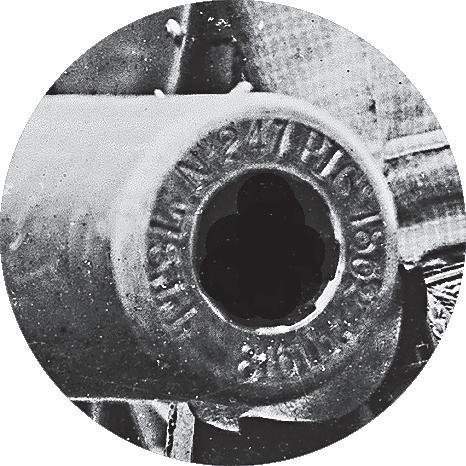
The cavalry was soon driven back leaving Tidball’s battery alone against considerable Confederate forces. Firing canister, Tidball advanced his guns until he reached a commanding position where he continued to pound the Confederates. Eventually reinforced, Tidball held his advanced post and when nightfall ended the battle, Battery A had fired some 1,200 rounds and received the compliments of numerous Union generals. Captain Tidball was promoted to brevet lieutenant colonel.
The next major event in John Tidball’s life came on May 24, 1863, when he was given command of the 2nd Brigade of Horse Artillery. He handed command of Battery A to Lt. John Calef. Tidball now led six horse artillery batteries
Muzzle of No. 247.
ArtillerymanMagazine.com | Vol. 42, No. 1 35
in the Army of the Potomac’s Cavalry Corps. During Lee’s second invasion of the north, Tidball’s batteries sparred with the Confederates numerous times. His old battery fired the opening artillery rounds of the Battle of Gettysburg, and played a huge role in delaying the Confederate advance. Tidball’s batteries served in various locations around the three-day battle especially in the cavalry battle on the final day.
Throughout the first part of the war, Tidball watched as his peers received promotions by leaving the artillery to rise rapidly in the infantry ranks. In August 1863, Tidball was finally promoted, but not in the regulars. The governor of New York gave Tidball command of the 4th New York Heavy Artillery Regiment occupying the defenses of the capitol. The horse artilleryman spent the autumn and winter of 1863–64 bringing his new command of heavy artillerymen up to his high standards of training and discipline.
In March 1864, Tidball and his heavy artillery regiment joined General Grant and the Army of the Potomac. Colonel Tidball was made commander of General Winfield Hancock’s II Corps artillery brigade’s nine batteries. At the Wilderness, two batteries played a key role in halting the Confederate advance and averting a Union disaster. At Spotsylvania Court House, Tidball’s batteries provided excellent support to II Corps including turning twenty-four Confederate captured cannon against their former owners.
In spring 1864, Grant reorganized the artillery reducing the batteries to four guns each, which increased Tidball’s Artillery Brigade to twelve batteries. The 4th NY Heavy Artillery, still under Tidball’s command, was converted to infantry. At Cold Harbor, he employed ninety-one artillery pieces in support of a II Corps’ attack. As both sides dug in, Tidball continually increased his use of mortars, eventually using everything from small 24-pdr. Coehorns to massive 10-inch mortars.
In late summer 1864, Tidball briefly served as Commandant of Cadets at the United States Military Academy but returned to the Army of the Potomac as IX Corps Chief of Artillery under an old friend, Major General John Parke. At the end of 1864, Tidball was promoted to brevet brigadier general.
At Petersburg, Tidball excelled at the Battle of Fort Stedman on March 25, 1865. After Confederates took the Union fort, Tidball deployed his batteries to prevent
the Confederates from receiving any reinforcements. The lack of reinforcements and the well-directed fire of Tidball’s artillery soon allowed Union forces to push the Confederates back to their lines. For his service at Fort Stedman, Tidball received the praise of General Grant and promotion to brevet major general. Tidball’s last major effort was implementing the IX Corps artillery support during the attack that shattered the Confederate lines and forced Lee’s withdrawal from Petersburg.
Tidball led his brigade in the Grand Review and then led the 4th New York Heavy Artillery to New York City where they mustered out. With the end of the war, Brevet Major General John Tidball once again became a captain and resumed command of Battery A. In August 1867, Tidball was finally promoted to major in the Regular Army. Until 1872, Major Tidball had a variety of western assignment from San Francisco to Kodiak,Alaska.
In 1874, he returned to artillery service at the Artillery School at Fort Monroe. There he wrote The Manual of Heavy Artillery Service published in 1880, which stayed in use until at least 1900. In 1881, General Sherman selected Tidball to be one of his six aide-de-camps and his artillery advisor. When Sherman retired in 1884, Tidball became Commandant of the Artillery School. He served there until his retirement on January 25, 1889, after forty-five years in the Army.
In retirement, he wrote extensively about his service and family history. In 1904, he finally received the coveted rank of brigadier general. He passed away in Montclair, N.J., on May 15, 1906, at age 81, and was buried at West Point.
Fortunately, many of Tidball’s writings have survived, providing an invaluable account of his military career and the times. One of his descendants, Eugene C. Tidball, authored an excellent biography entitled No Disgrace to My Country: the Life of John C. Tidball, (Kent State University Press, 2002). Personally, I feel honored to own the presentation sword of such andexceptional artillery officer.
Gordon A. Blaker is the Director/Curator of the U.S. Army Artillery Museum at Fort Sill, Okla., which he opened in June 2009. He is a retired Armor and Cavalry officer. Mr. Blaker entered the museum profession in 1995. He served as Curator at the Augusta Museum of History, Augusta, Ga., from 1997 to 2006. Mr. Blaker is the author of two books and co-author of one book on military history subjects.
Overall view of the Tidball sword and scabbard.

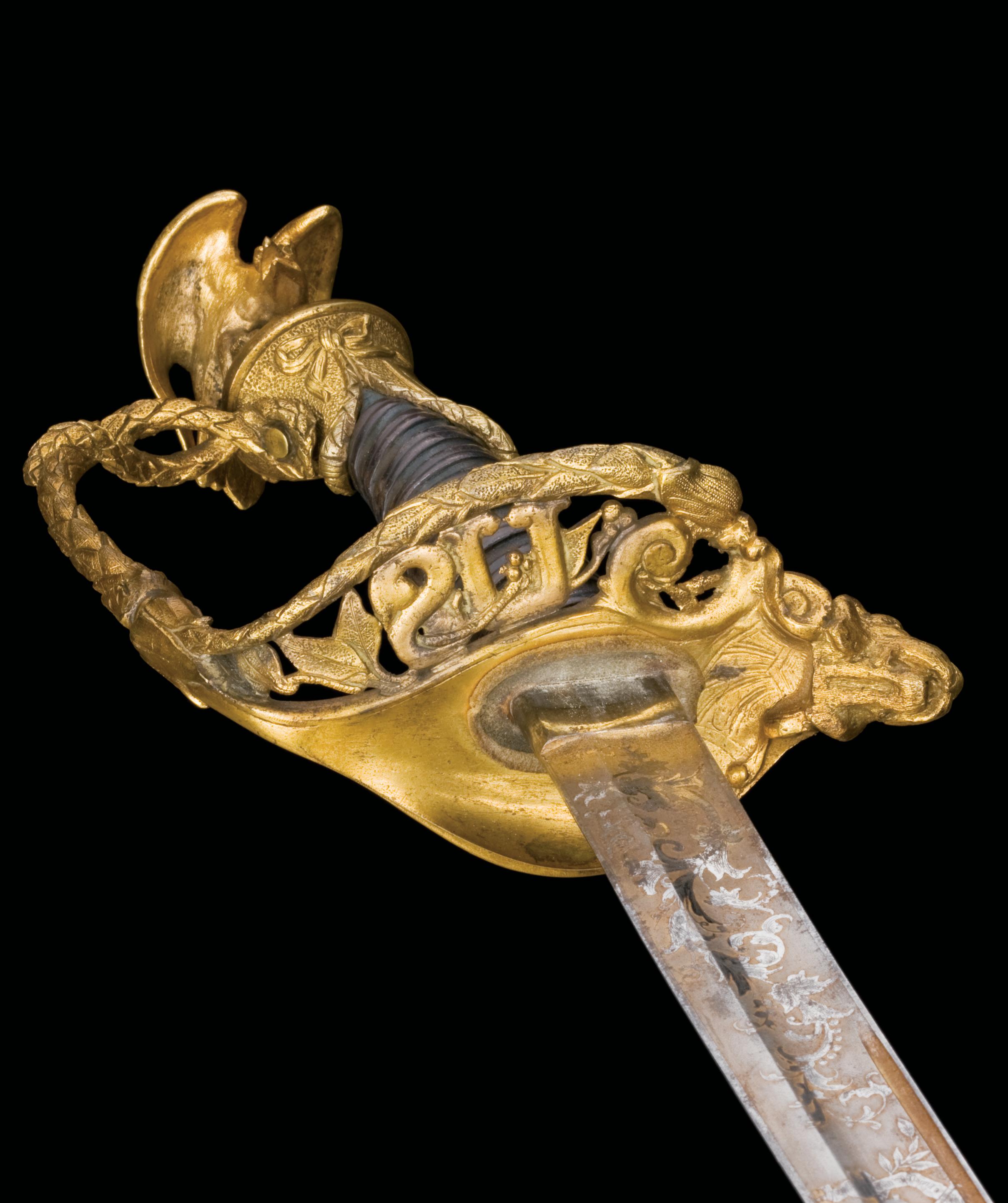
 Angled view of the hilt illustrating the beautiful craftsmanship of Tiffany & Co.
Presentation engraving on the scabbard
Angled view of the hilt illustrating the beautiful craftsmanship of Tiffany & Co.
Presentation engraving on the scabbard
Extremely high grade presentation staff officer’s sword with a raised relief patriotic Union shield on the pommel cap and a highly detailed gargoyled positioned American eagle unique to Tiffany. Tiffany
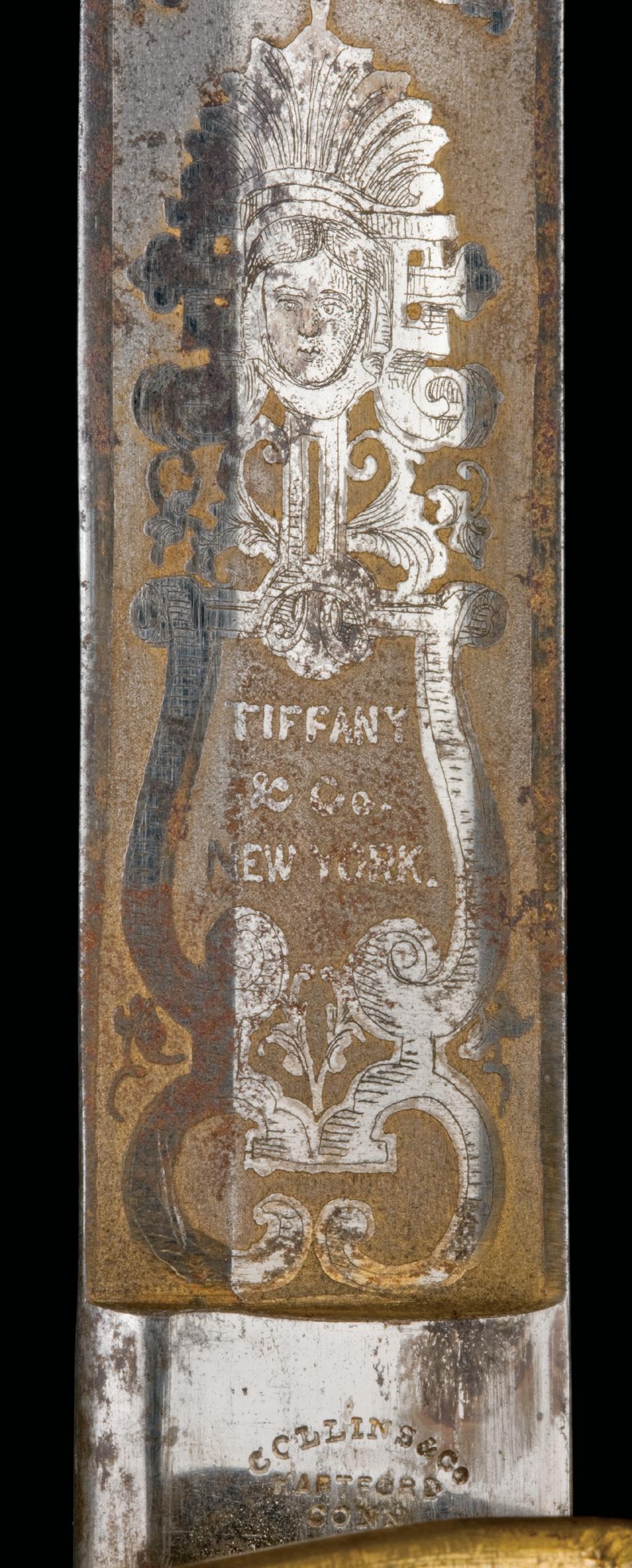

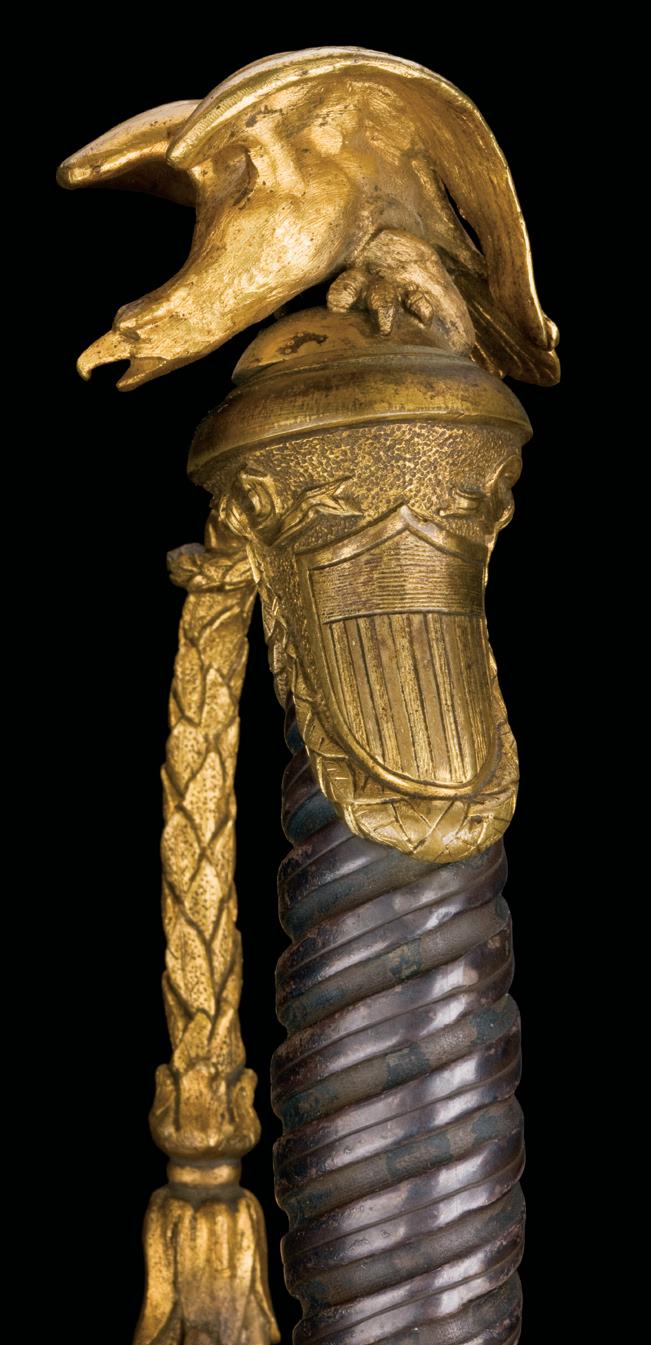
 & Co. etching on blade.
& Co. etching on blade.
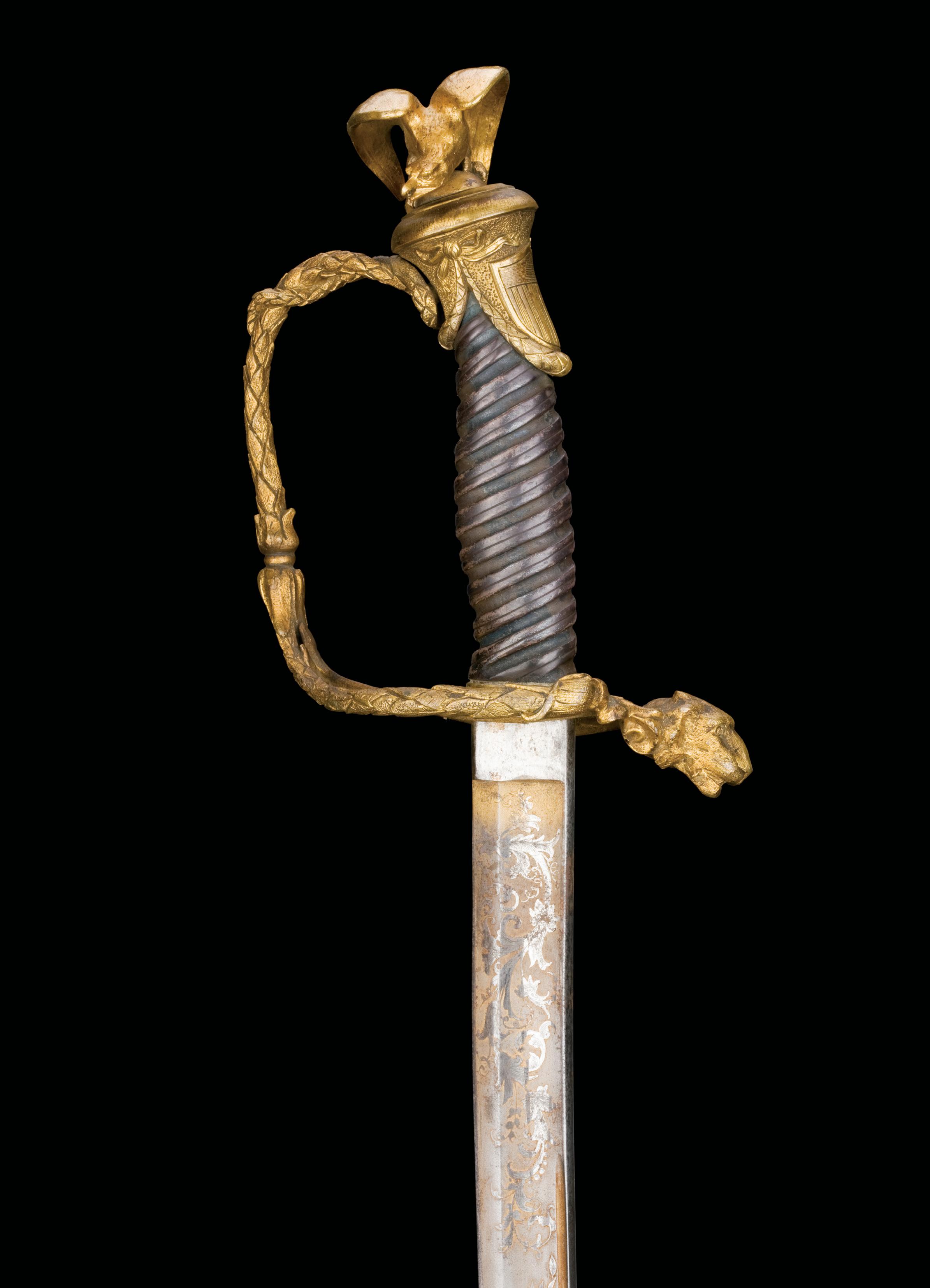
 Tiffany marking on the scabbard.
Detailed view of the presentation sword’s hilt and blade.
Tiffany marking on the scabbard.
Detailed view of the presentation sword’s hilt and blade.
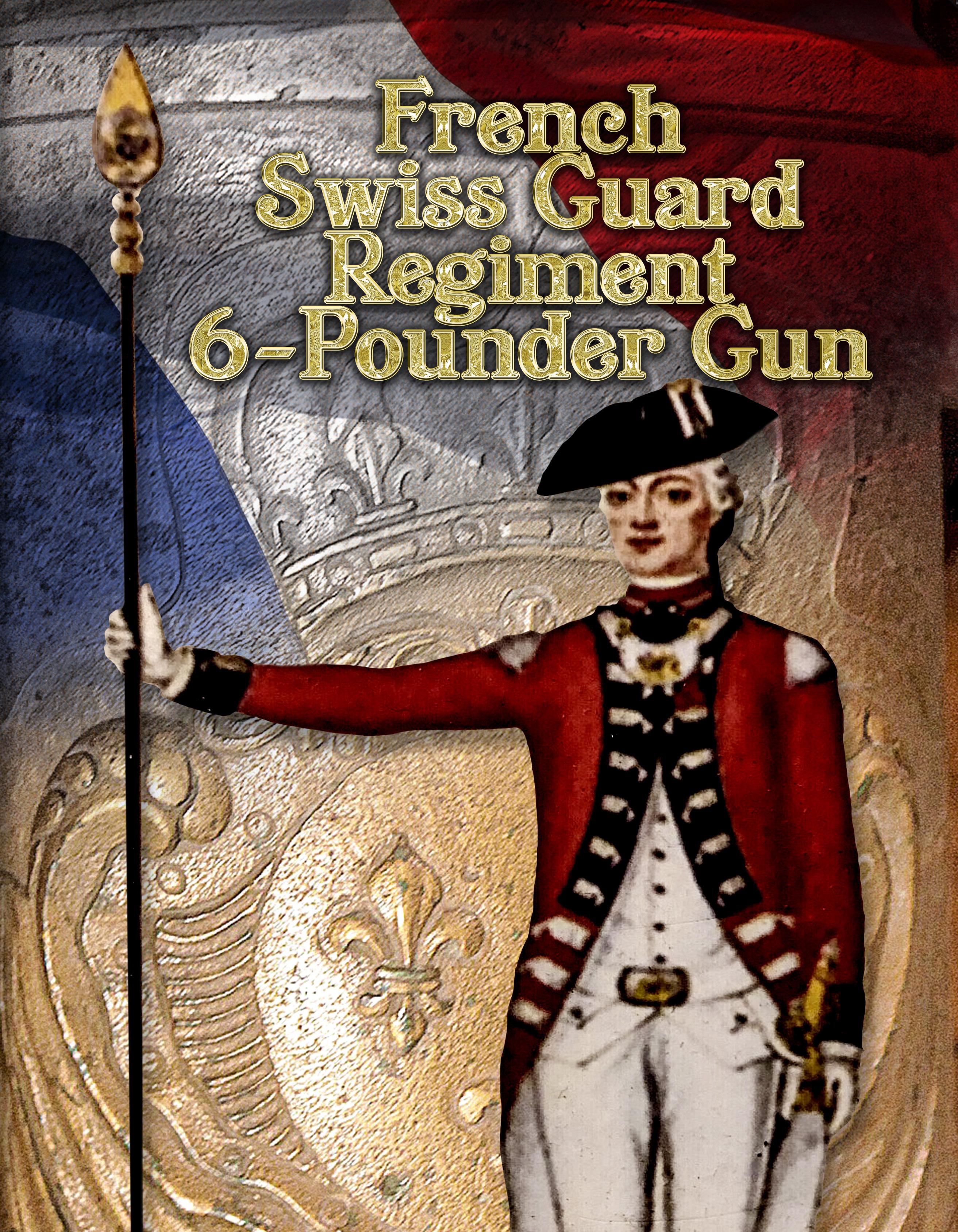 by Becky Coffield
Officer of the Royal French Swiss Guard Regiment.
by Becky Coffield
Officer of the Royal French Swiss Guard Regiment.
In 2017, the U.S. Army Engineer Museum offered the U.S. Army Artillery Museum a Revolutionary War era French bronze cannon. As we are always seeking to expand the museum’s artillery collection, we agreed to the transfer. The gun arrived in a crate in September 2017. The cannon was cataloged as a 9-pounder, but upon opening the crate, it was obvious it was a somewhat smaller caliber. The markings were definitely French, but different from other French cannon in the collection. A measurement of the bore revealed it was a 6-pounder. Now, the problem was that the French did not make 6-pounders. It should be either a 4 or 8-pounder. At this point, the curator, Gordon Blaker, contacted an old friend knowledgeable about all things French. The answer was that the cannon had come from the one organization in the Royal French Army that did almost everything differently, the Swiss Guard.

This gun was cast in Strasbourg on August 22, 1741. Behind the muzzle is the name of the cannon, Le Cho, as well as Ultima Ratio Regum, the “Last Argument of Kings” a motto established by King Louis XIV. Below is the name, Louis Charles de Bourbon, Comte d’Eu, and his coat of arms. The breech ring markings have the name Jean Maritz, who was the Commissioner of the King’s Foundry. Although the gun is within the Vallière French artillery system it differs in some details including a plain breech face and cascabel.
This cannon first appears in museum records at the Rock Island Arsenal Museum in 1957. It was transferred to the U.S. Army Engineer Museum in 1994, then to the U.S. Army Artillery Museum at Fort Sill, Okla. It seems that the gun was deemed obsolete when the new Gribeauval system of artillery was introduced in 1776, but sent as one of a large number of French artillery pieces supplied to the Continental Army during the American Revolution. These French cannon played a very important role in
winning the war.
Beginning in the late 15th century, Swiss mercenaries were recruited to serve as bodyguards for several European rulers. The earliest known permanent indoor palace guard and ceremonial troop unit, known as Cent Suisses or 100 Swiss, served the French court in 1490. The Swiss Guard Regiment in France was created by King Louis XIII in 1616 to protect the various royal palaces, as they were still regarded as the best foot soldiers in Europe.
Throughout the 17th and 18th centuries, the Swiss Guard (Gardes Suisses) established themselves as a disciplined elite unit in peace and war. Everything about the Swiss Guard was different from the regular French Army. Their uniforms were red with blue lapels and cuffs instead of white;
their discipline, adhering to Swiss code, not French was stricter; their arms and weapons, including cannon, were different as well.
Louis Charles de Bourbon, Comte d’Eu, and last Grand Master of Artillery ( Grand-Maître de l’Artillerie ), 1710–1755, was responsible for the production of artillery, ammunition, and powder, as well as the administration of arsenals. In addition, the GrandMaître de l’Artillerie also served as the commander of the Royal Artillery Regiment and the Swiss Guard Regiment. He changed the artillery to the Vallière system’s 4, 8, 12, and 24-pounders. By 1755, the Grand Master of Artillery position was abolished by King Louis XV and the French artillery underwent changes again, this time into the Gribeauval system by 1776.
The loyal Swiss Guard Regiment
ArtillerymanMagazine.com | Vol. 42, No. 1 41
Rear view of the Swiss Guard 6-pdr. gun.
Breech ring markings. The Artilleryman
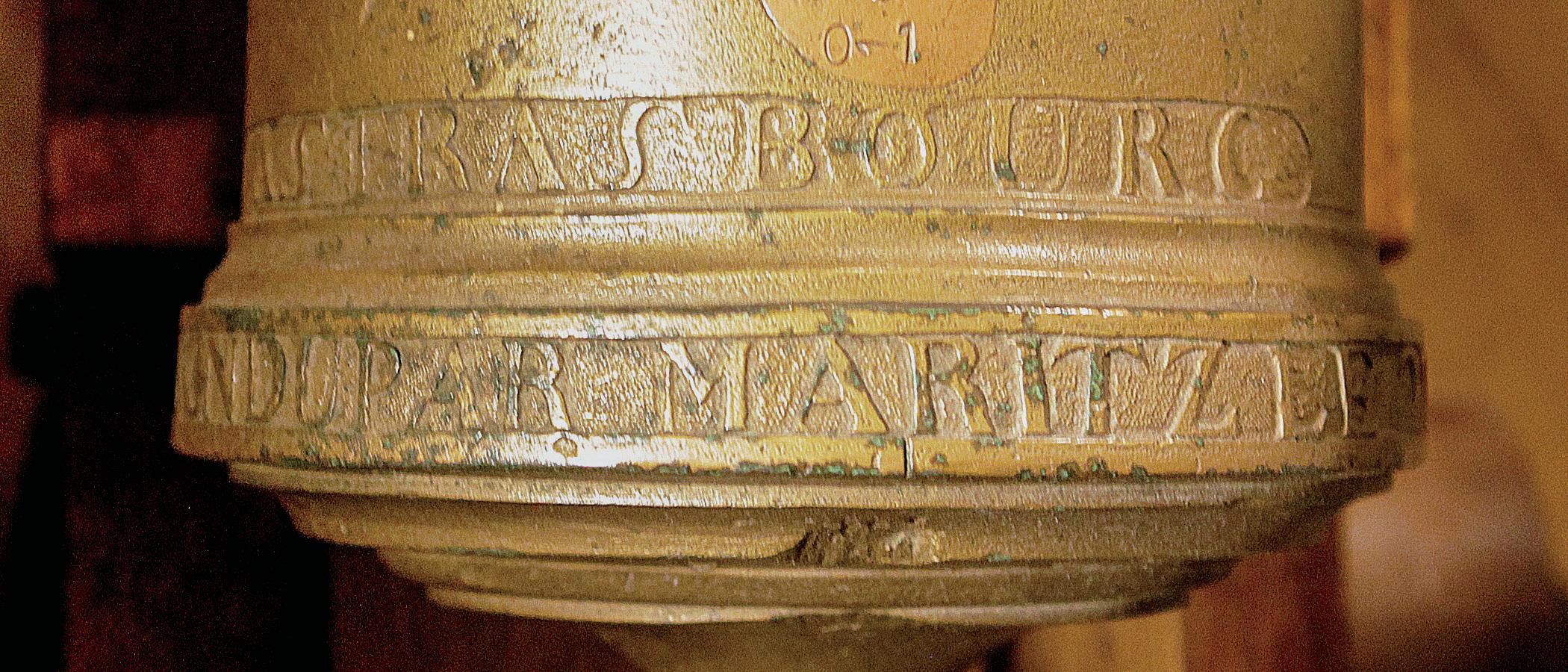
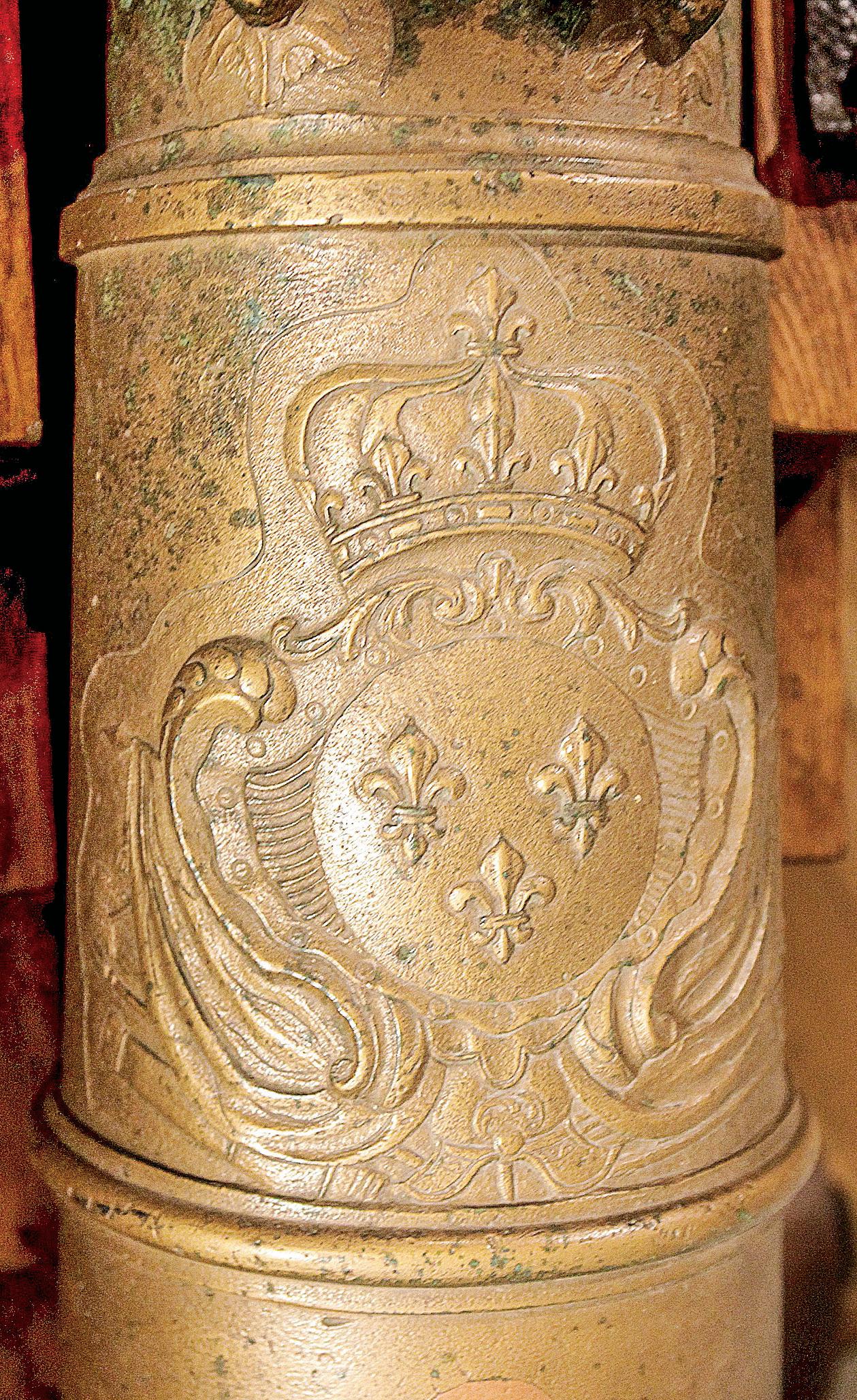
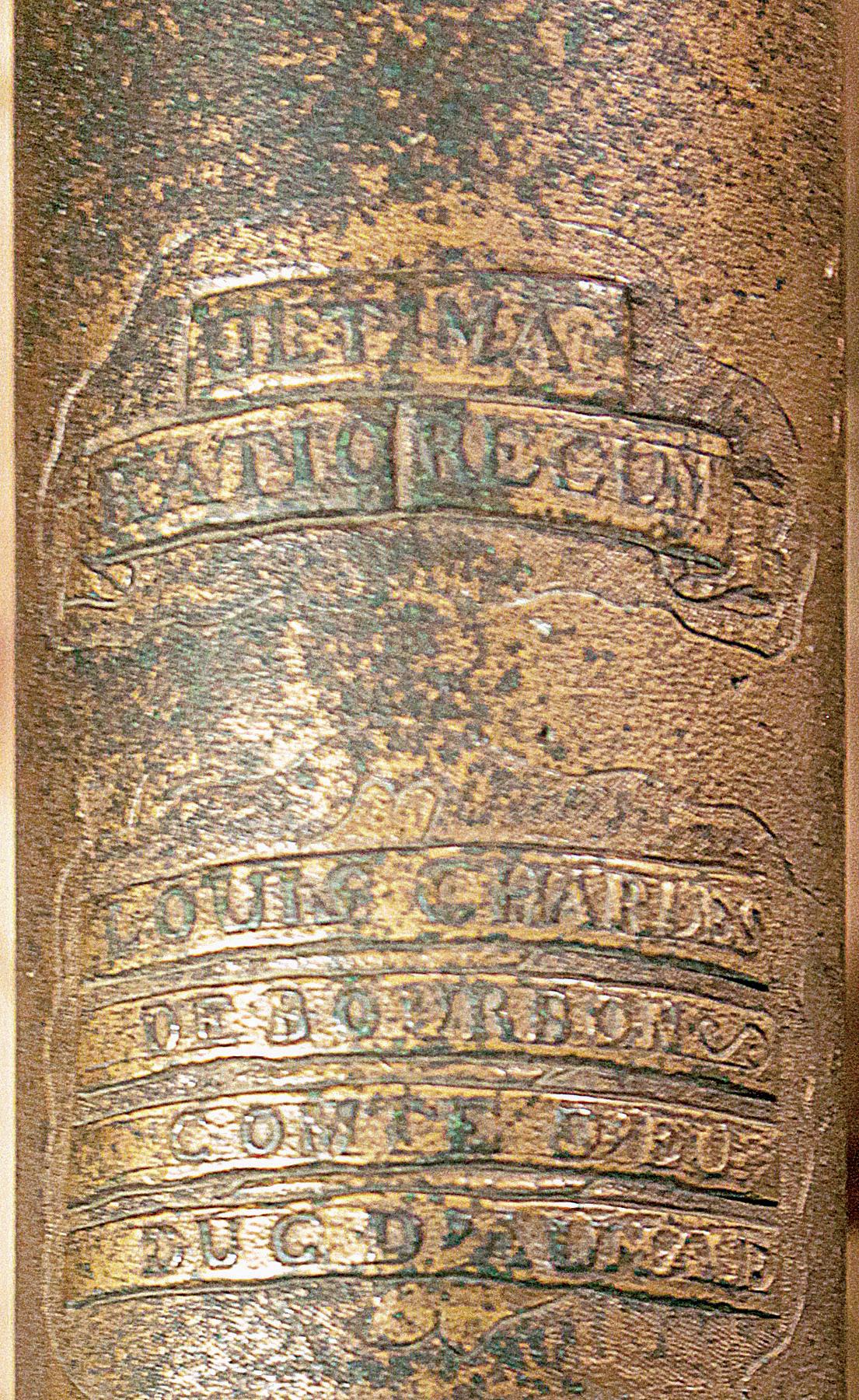 Top of the tube with Ultima Ratio Regum, its name, Le Cho, and Louis Charles de Bourbon, Comte d’Eu.
Top of the tube with Coat of Arms of Louis Charles de Bourbon, Grand Master of the Artillery of France and commander of the Swiss Guard Regiment.
Top of the tube with Ultima Ratio Regum, its name, Le Cho, and Louis Charles de Bourbon, Comte d’Eu.
Top of the tube with Coat of Arms of Louis Charles de Bourbon, Grand Master of the Artillery of France and commander of the Swiss Guard Regiment.
42
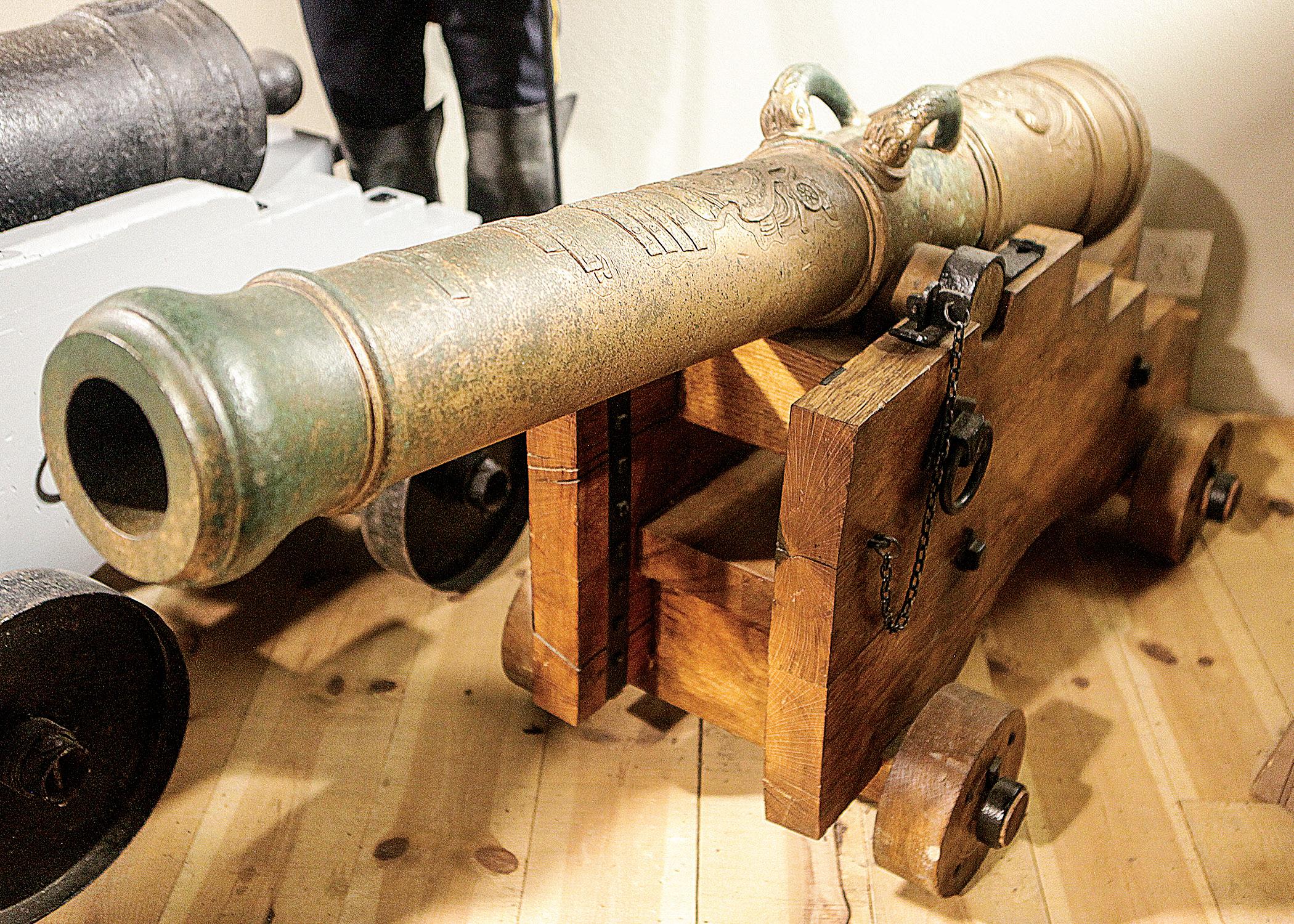

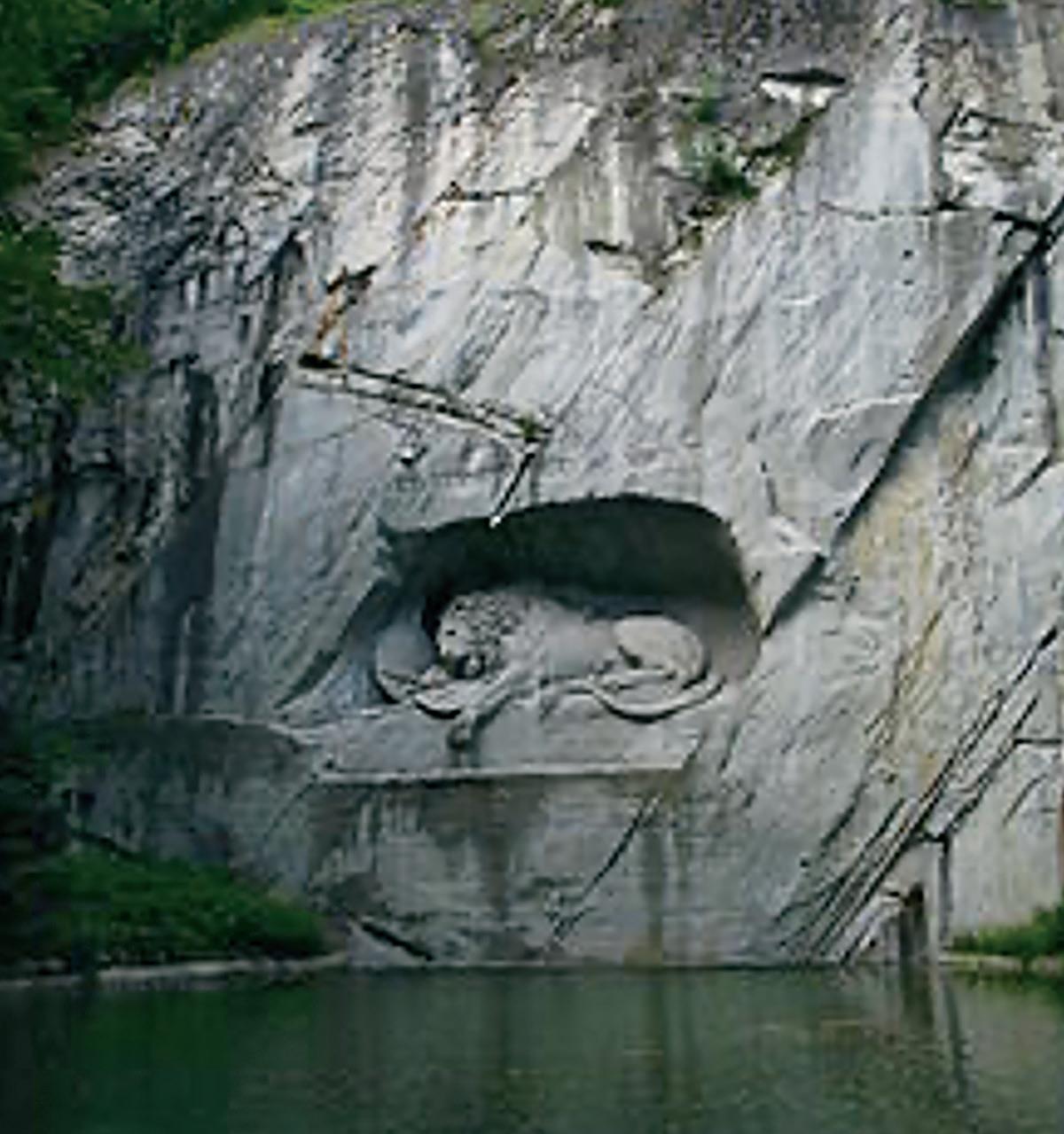 Front view of the Swiss Guard 6-pdr. gun.
Louis Charles de Bourbon (1705–1775).
Front view of the Swiss Guard 6-pdr. gun.
Louis Charles de Bourbon (1705–1775).
ArtillerymanMagazine.com | Vol. 42, No. 1 43
Monument to the Royal French Swiss Guard in Lucerne, Switzerland.
was annihilated defending Tuileries Palace in Paris during the French Revolution, August 10, 1792, and later disbanded. Over three thousand Swiss soldiers transferred to French units to continue service, while others returned to Switzerland. Karl Pfyffer von Altishofen, an officer of the Guards who had been on leave in Lucerne during the Revolution, created a monument dedicated to Helvetiorum Fidei ac Virtuti (“To the loyalty and bravery of the Swiss”) in 1821. The dying lion is portrayed impaled by a spear, covering a shield bearing the fleur-de-lis of the French monarchy; beside him is another shield bearing the coat of arms of Switzerland. The inscription below the sculpture lists the names of the officers and gives the approximate numbers of soldiers who died (DCCLX = 760), and survived (CCCL = 350).


Today the Swiss Guard cannon is on exhibit in the U.S. Army Artillery Museum, Fort Sill, Okla. During COVID-19 we are open only for soldiers training, not the public. Check the museum’s Facebook page for updates.
Becky Coffield has been a docent and research historian for the U.S. Army Artillery Museum at Fort Sill, Okla., since 2014. She has a master’s degree in Museum Studies from the University of Oklahoma, is a former U.S. Army Chemical Officer and recipient of the Honorable Order of Molly Pitcher. Previously, Becky interned at the Dr. Pepper Museum and Free Enterprise Institute in Waco, Texas, and has been published in the Army Museum Memo. Currently, Becky is raising three daughters and is married to an active duty Field Artillery Officer.
 Right trunnion markings.
Expand view of the top of the tube with Ultima Ratio Regum, its name, and Louis Charles de Bourbon, Comte d’Eu, and crest.
Right trunnion markings.
Expand view of the top of the tube with Ultima Ratio Regum, its name, and Louis Charles de Bourbon, Comte d’Eu, and crest.
The Artilleryman 44
Left trunnion markings.
“Hard-to-Find” becomes easy. For generations, re-enactors, modern hunters and competitive shooters have looked to the DIXIE GUN WORKS’ catalog for the hardest to find blackpowder items. Our all new 2021 catalog continues the tradition with the world’s largest selection of


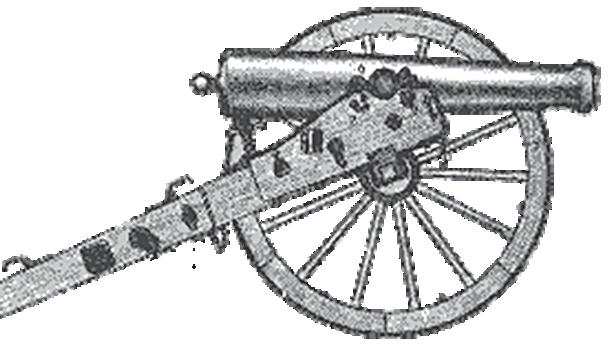
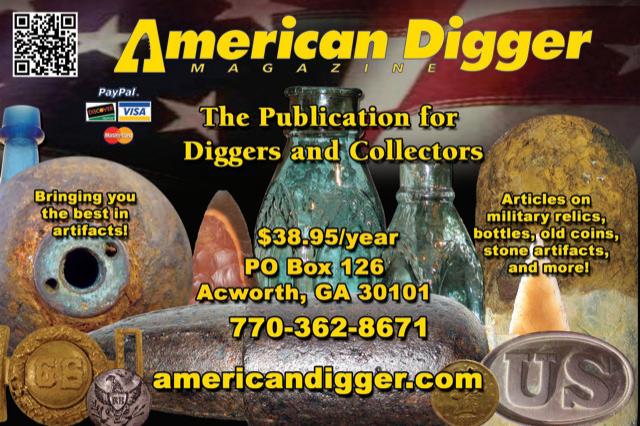
Advertising information: Contact us at mail@artillerymanmagazine.com or call 800-777-1862. Ad rate sheet is available online at www. ArtillerymanMagazine.com and click on Advertisers link. Artillery Drawings Contact us for a catalog sheet. Drawings with dimensions of carriages, limbers, ammunition chests and more. Antique Ordnance Publishers PO Box 610434 Port Huron, MI 48061 AOrdP434@comcast.net • (810) 987-7749 DIXIE GUN WORKS, INC. 1412 W. Reelfoot Avenue PO Box 130 Dept. 66 Union City, TN 38281 INFO PHONE: (731) 885-0700 FAX: (731) 885-0440 EMAIL: info@dixiegunworks.com Gun Works, Inc. Where
sport shooting equipment. PROFESSIONAL SERVICE AND EXPERTISE GUARANTEED STILL ONLY $5.00 VIEW ITEMS AND ORDER ONLINE! www.dixiegunworks.com Major credit cards accepted FOR ORDERS ONLY (800) 238-6785 Civil War Artillery Projectiles –The Half Shell Book by Jack W. Melton Jr. Order Online at ArtillerymanMagazine.com See advertisement in this magazine. COONIE’S BLACK POWDER, INC. (800) 713-6321 - Fax (575) 393-6060 PO Box 2062, Hobbs, NM 88241 We ship out in full case lots (25 - 1# cans) Will Mix Cases Email: cooniesblkpdr@aol.com for price quotes. GOEX: 1Fg-4Fg - Cannon - Cartridge - Cowboy - ExpressOlde Eynsford - Reenactor & Swiss Black Powder GOEX: Pinnacle & Clear Shot (BP-Sub.) Master Distributor for Goex Powders (Since 1983) ArtillerymanMagazine.com | Vol. 42, No. 1 45
blackpowder replica arms, accessories, antique parts, muzzleloader hunting and
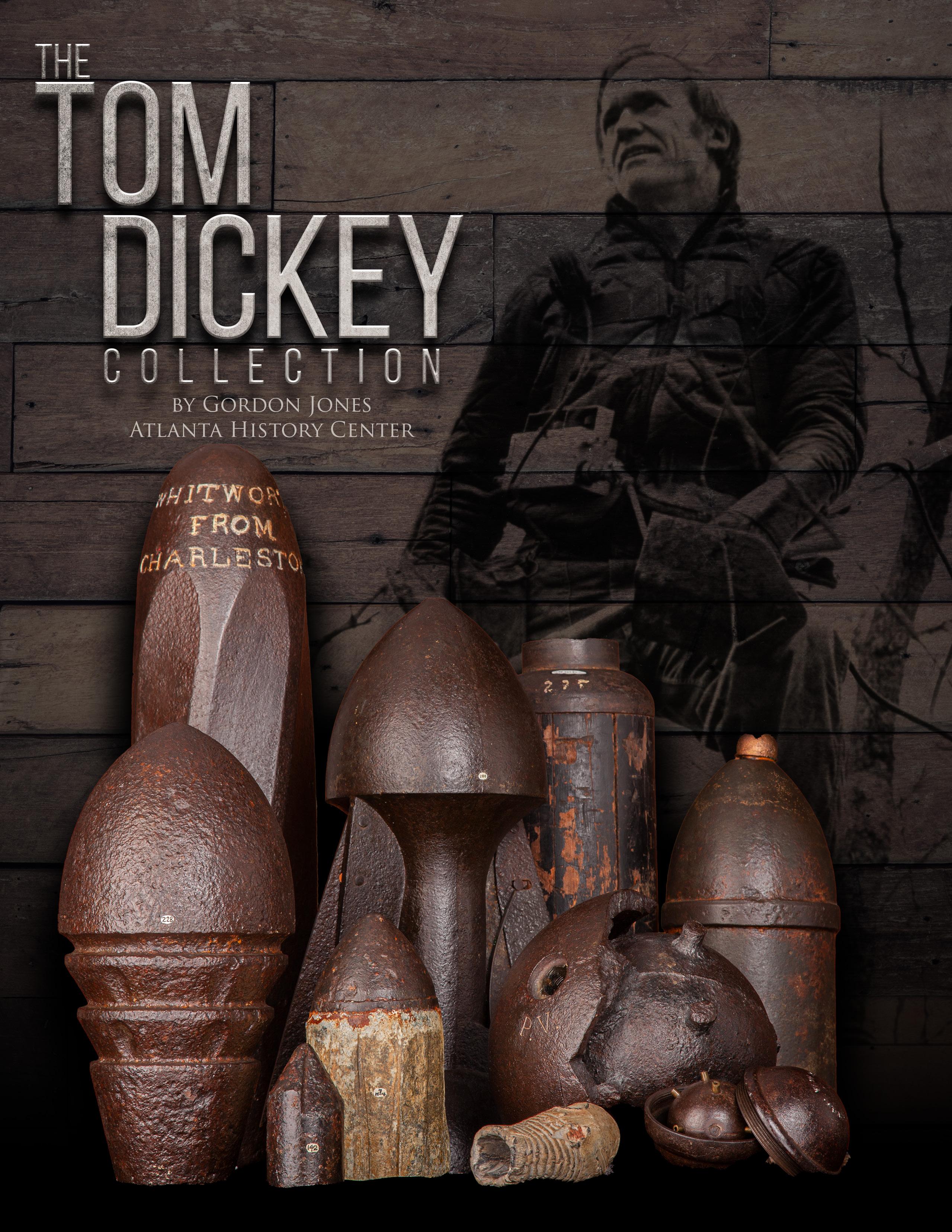
Tom Dickey: Father of Civil War Artillery Projectile Collecting
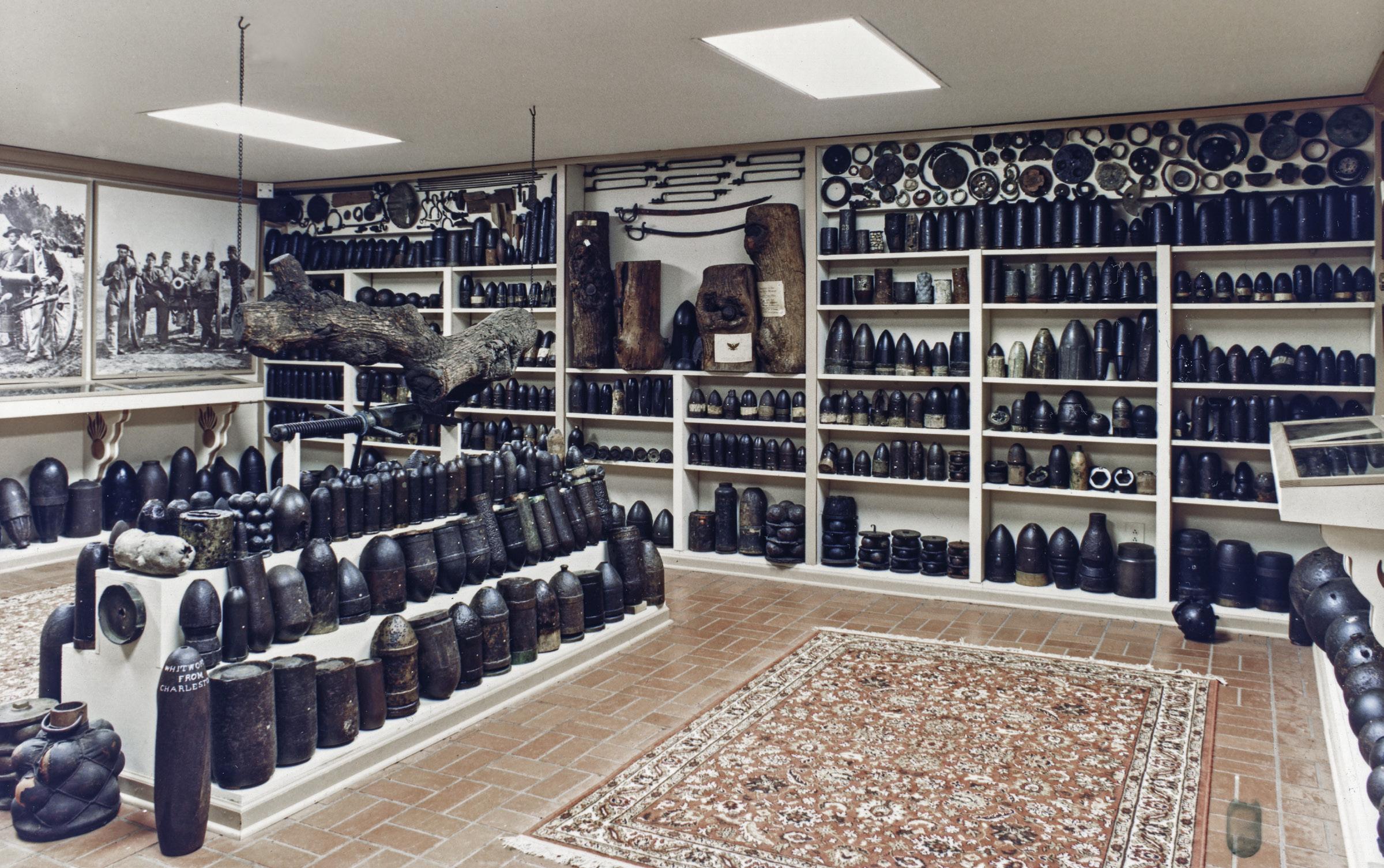 by Dr. Gordon L. Jones, Atlanta History Center, and the editors of The Artilleryman
by Dr. Gordon L. Jones, Atlanta History Center, and the editors of The Artilleryman
All of us who read The Artilleryman owe a great debt of gratitude to Thomas Swift Dickey Sr. (1925–1987). Using metal detectors, exhaustive research, and his own unquenchable curiosity, Dickey assembled the largest and most comprehensive collection of Civil War artillery projectiles in the United States. His life’s work of identifying and classifying those projectiles stands as the foundation for our knowledge of the subject today. In one way or another, we all stand on Tom Dickey’s shoulders.
Tom was raised in the Buckhead neighborhood of Atlanta, Ga., the son of a prominent Atlanta attorney. His brother was poet and novelist James Dickey, best known as the author of Deliverance James is also known to artillery collectors for his 1961 poem about his brother entitled
“Hunting Civil War Relics at Nimblewill Creek.” As a world-class track star at Louisiana State University, Tom Dickey considered going into coaching. Instead he ended up in a more lucrative career in Atlanta commercial real estate with the Draper-Owens Company.
For Tom Dickey, the Civil War was not just any war. It was a war that took place on the very ground where he was born and grew up. Dickey found his first Civil War projectiles as a small boy on property his father owned at what was once the southern end of General Joseph E. Johnston’s Chattahoochee River Line for the defense of Atlanta. Tom’s boyhood collection fit neatly into a single box in his closet.
As Tom Dickey well understood, most of the wreckage Civil War armies left behind on the battlefields was still
The Dickey Collection, looking in from the doorway, photographed exactly as Tom left his room before he died Dec. 1987. Jack W. Melton Jr., February 1988.
“We have the only hobby that’ll eventually play out; but wouldn’t it be fun to bury all this stuff and do it again?”
ArtillerymanMagazine.com | Vol. 42, No. 1 47
Tom Dickey in “Confessions of a Relic Hunter” Atlanta Civil War Roundtable, Jan. 14, 1986
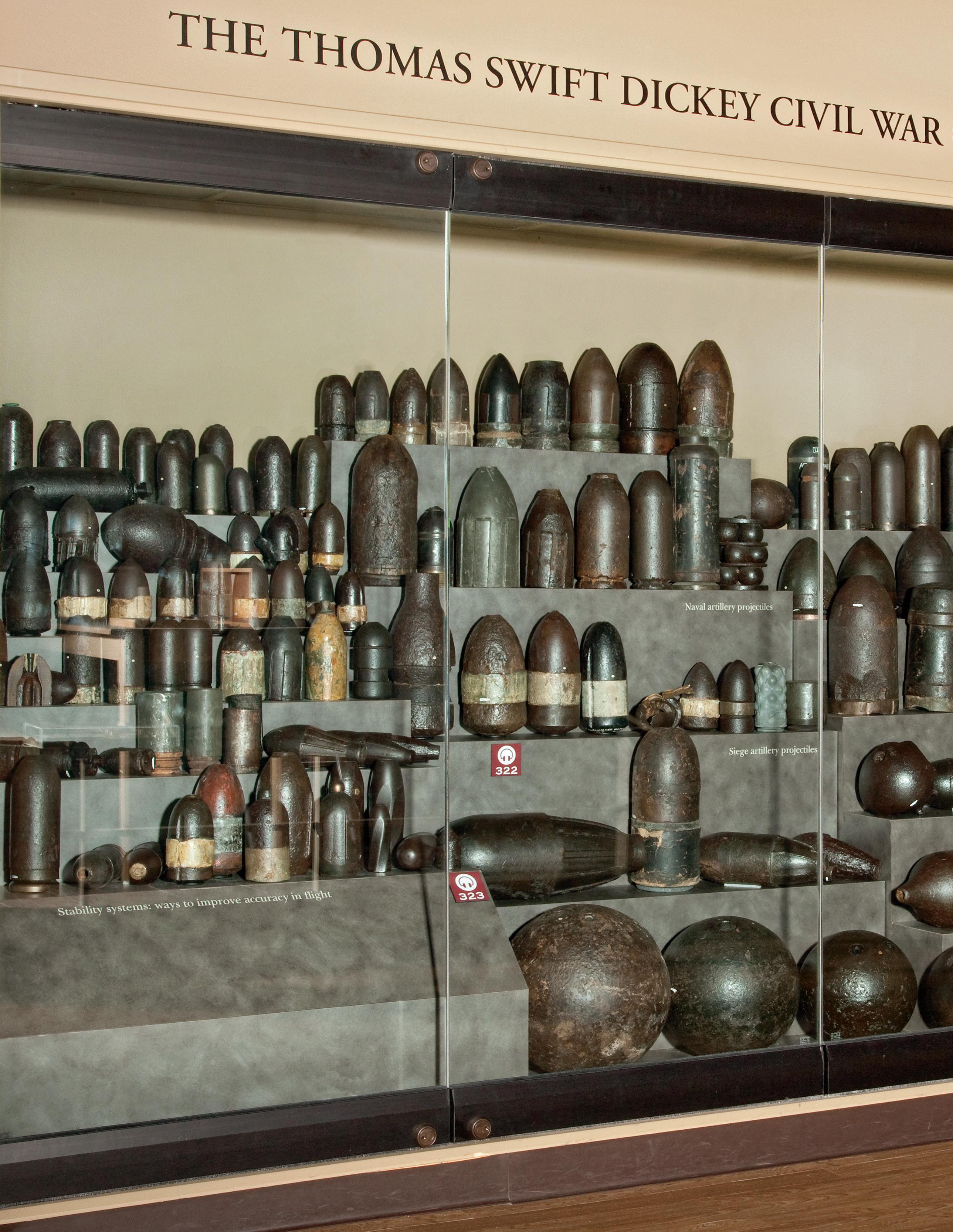
there, with literally tons of ordnance hidden just inches below the surface. After World War II, surplus U.S. Army mine detectors gave young Civil Warriors the tool they needed to locate that hidden ordnance. What followed was a golden era of relic-hunting, a window of about twenty years in which the battlefields yielded their iron secrets by the bucketful.

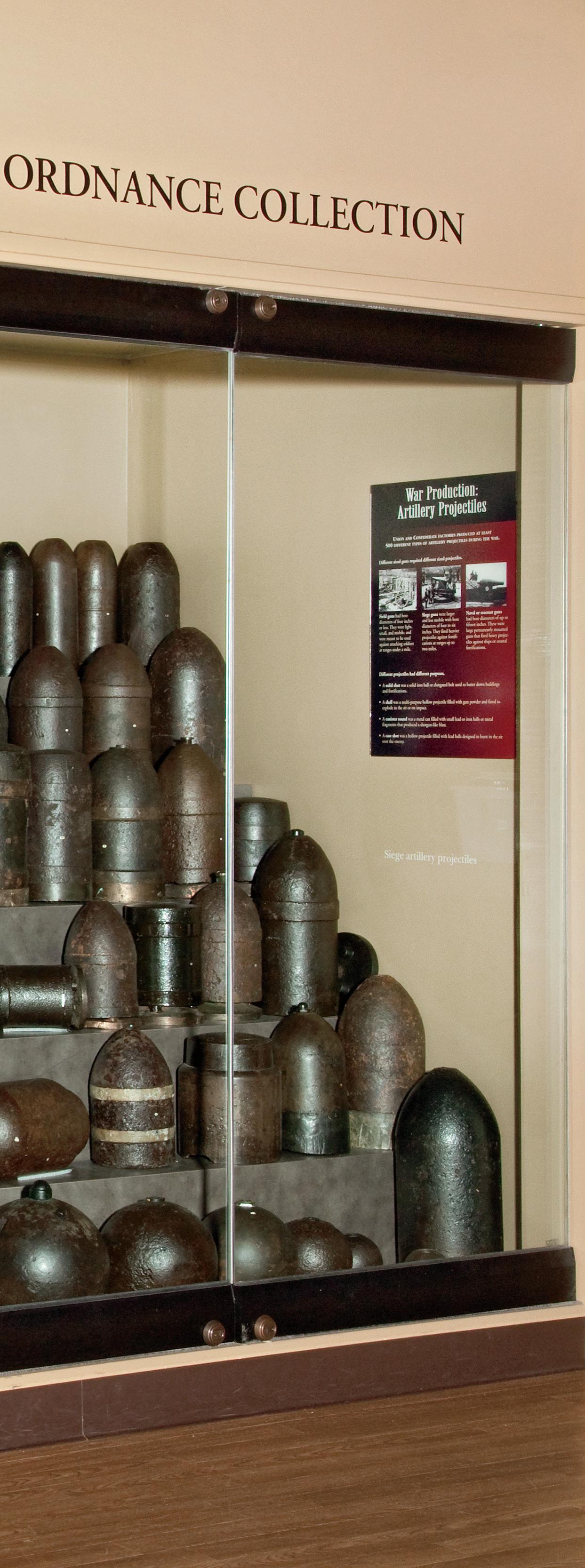
When Atlanta collector Beverly M. DuBose Jr. first visited Vicksburg National Military Park in the early 1950s, he not only had an official permit for metal detecting, but the Park Service also provided two men to help him dig. DuBose’s son “Bo” remembers that because relic-hunting helped pinpoint the wartime locations of trenches and encampments, “the National Park Service was just as anxious to find out what was there as we were.” Yet the relics themselves were still considered more curiosity than artifact. Only when hunter-historians began to study and compare finds did they begin to understand the historical and technological significance of what they were uncovering.
Inspired by his friend Beverly DuBose, Tom began showing up on local battlefields with his WWII “GI” mine detector looking for unexploded artillery projectiles. In the summer of 1951, he appeared at a house on the Mud Creek battlefield near Kennesaw Mountain, where Jack Bell lived with his family. Putting Jack to work, they found seven shells the first day. “I don’t know why exactly I got interested in the artillery projectiles,” remembered Dickey in a 1974 documentary film. “They just seemed to be something that fascinated me, and the more you find out about ‘em the more fascinating they become.”
In the early days, finds were plentiful. “You had to stop about 12 o’clock and get the stuff out of the woods,” remembered Dickey. “You literally couldn’t get the weight out of the woods—and it was up and down ravines, up and down ravines, getting all the load in shifts out.” Sometimes the
The Thomas Swift Dickey Civil War Ordnance Collection on display at The Atlanta History Center. Peggy Melton.
ArtillerymanMagazine.com | Vol. 42, No. 1 49
Artilleryman magazine publisher Jack W. Melton Jr. and Tom Dickey in March 1987 while on a visit to see Tom’s collection.
load was too much. In Louisiana, his haul far outweighed the 350-pound capacity of a 12-foot aluminum boat, sending it bubbling to the bottom. On another occasion, as his Chevy station-wagon sagged to the ground, he and his exhausted and muddy compatriots went for help. “We looked so terrible that nobody would rent us a U-Haul-It trailer!” One time, when Tom stopped to chat with a friend in Kinston, N.C., his car was so loaded the front end pointed to the sky.
By the late 1950s, the National Park Service was getting so many requests from metal detectorists that it simply could not accommodate them all. Adding to the problem was the flood of visitors occasioned by the coming Civil War Centennial and a host of legal liability issues. Result: no more permits. Today, relic-hunting of any kind on National Park Service or state-owned battlefields is strictly prohibited—and strictly enforced, unless it is conducted as part of a NPS funded project to identify resources and help
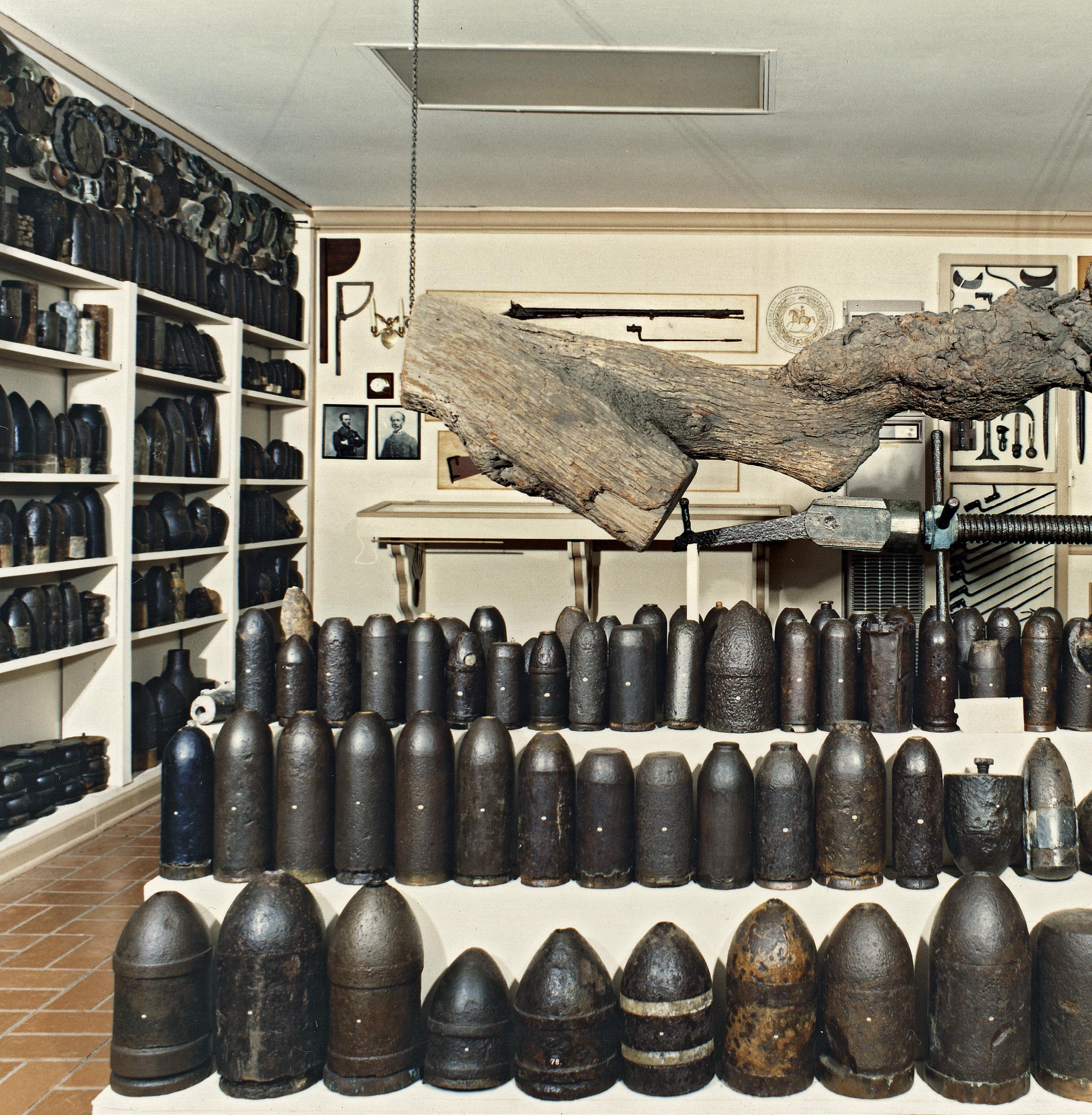
50
The Artilleryman
better define the battlefield. “I can understand the National Park Service’s feeling on it,” Dickey commented in 1986. “With the development of the metal detector, a collision course was set between the relic hunter and the National Park Service in the relic hunter’s effort to open up the great Civil War time capsule—or as my brother calls it, ‘the war under the pine straw.’”
Civil War artillery projectiles had no respect for property boundaries. “You not only have to have a lot of patience in
relic hunting,” Dickey observed, “but you also have to have a lot of patience in getting permission to find out who owns what [property] . . . When they find you, it’s a lot better for them to ask you how you’re doing than what you’re doing.”
In that regard, Tom was (and is) something of a legend. One of many stories he liked to tell was the one about being jailed in Baton Rouge, La., on charges of trespassing on private property near Port Hudson. As an L.S.U. grad, he still had friends in the area, so he called the one who was not only a lawyer but an authority on the siege of Port Hudson. “Where did ya’ll park?” asked his friend. After Tom described the site, his friend replied, “That’s been a public road since before the Civil War! General Banks moved into Port Hudson to take the surrender along that road!” Tom and his friends were quickly released. Later on, under cover of darkness, they went back and retrieved the cache of projectiles they had hidden near the car.

About 1974, Dickey switched to using a new detector made by White Electronics; a Coinmaster 5. By filtering out interfering signals from minerals in the earth, the White detector enabled him to locate projectiles much deeper in the earth—or as he put it, “it would almost find ‘em where they ain’t.” By that point, at least from Tom’s point of view, relic-hunting was already “played out” and discoveries were getting to be few and far between. Instead of going to the same old “beaten flat” places, “we got to go to these little-known battles way out in the boondocks that the average weekend relic hunter is not going to go to.”
Finding those little-known battlefields took hours of research. Long before the advent of Google Books, Dickey had to get his hands on as many original wartime accounts and maps as possible. That meant going to libraries,

ArtillerymanMagazine.com | Vol. 42, No. 1 51
Tom Dickey holding a U.S. 3.4-inch Schenkl percussion fused shell with its original papier-mâché sabot while engrossed in a conversation about projectiles.
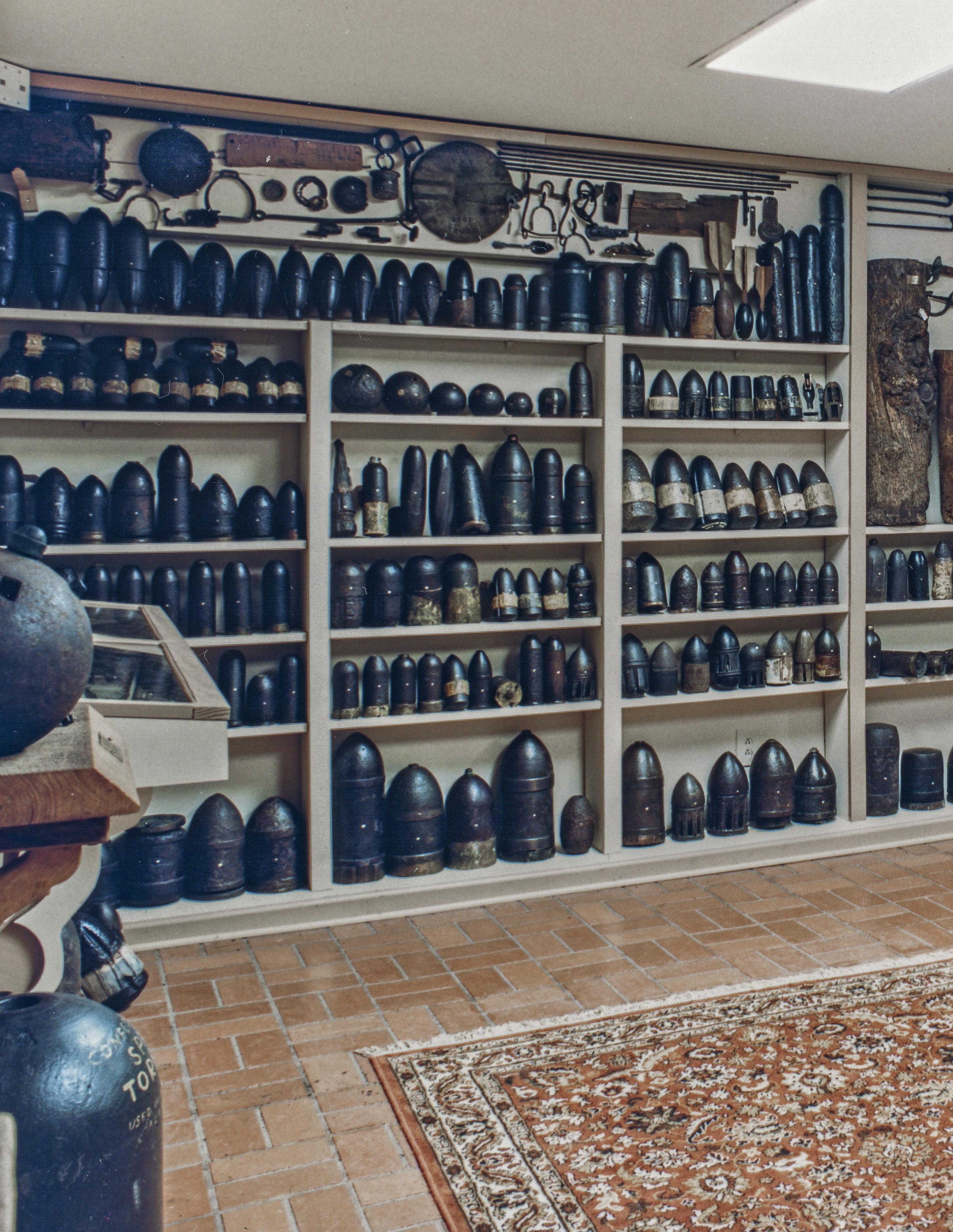
52
The Artilleryman

ArtillerymanMagazine.com | Vol. 42, No. 1 53
“I don’t know why exactly I got interested in the artillery projectiles...They just seemed to be something that fascinated me, and the more you find out about ‘em the more fascinating they become.” – Tom Dickey
researching in archives, scouring antique stores and relic shows for books. With any luck, the information in the original sources was detailed enough and the battlefield terrain still intact enough to allow him to locate specific gun positions. From there, he could then calculate projectile trajectory and the best possible locations to search. In the process, he built up one of the nation’s best collections of artillery manuals, technical drawings, and battlefield maps.
The sheer breadth of Tom Dickey’s discoveries is staggering. In thirty years of hunting, he explored at least 388 different sites from Eastern Virginia to the Mexican War battlefield of Cerro Gordo, northwest of Vera Cruz (see the complete list of sites at the end of this article). During that time, he recovered upwards of 1,000 unexploded artillery projectiles. The largest share of these, some 850 projectiles of nearly every type and caliber, plus fuses, sabots, and related material, is now owned and exhibited at the Atlanta History Center, about a mile from where Tom grew up. The Center also owns Dickey’s library of original source material, which is available for public research in the Kenan Research Center.
From his many years of documentary research and battlefield discoveries, Tom Dickey generated three pioneering reference books. These were the first to identify and classify hundreds of different Confederate and Union projectile types, along with their many variations:
• Field Artillery Projectiles of the Civil War, 1861–1865 (with Sydney C. Kerksis, 1968)
• Heavy Artillery Projectiles of the Civil War, 1861–1865 (with Sydney C. Kerksis, 1972)

• Field Artillery Projectiles of the American Civil War (with Peter C. George, 1980)
These books are still in many ways standard reference guides for the collecting field. Most importantly, they still serve as a solid foundation for research that has corrected, updated, and extended our knowledge of artillery projectiles and technology. Tom Dickey’s work has inspired generations of artillery enthusiasts, enabling them to reach far beyond what one man could discover in his lifetime.
The
54
Closeup of the display at The Atlanta History Center.
Artilleryman
War Under the Pine Straw (1974)
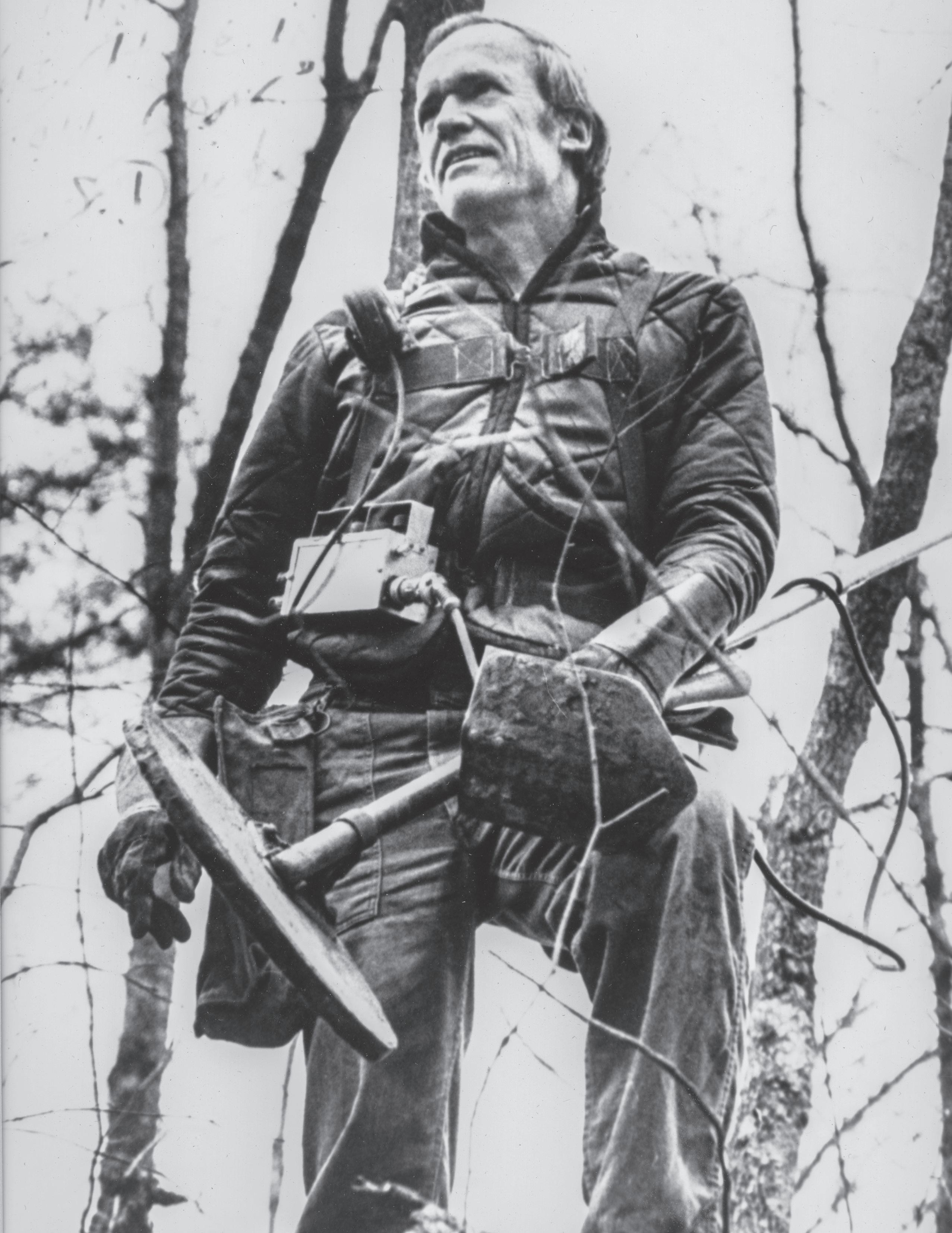
If you want a glimpse into Tom Dickey’s passion for Civil War artillery, start with this funny but informative 27-minute documentary. You can download it from Vimeo: https://vimeo.com/133782628. The camera follows Tom as he searches battlefields, tells stories about his finds, and, maybe the highlight of the film, Tom hammers a screwdriver through the fuse plug of a 100-pounder Schenkl shell.
Tom’s nephew Christopher Dickey (1951–2020), a noted journalist and television news commentator, made the film in 1974. Back then,, he was a young graduate student at Boston University and needed a thesis project. “The film was supposed to be about history and memory, but as it turned out it’s really about Tom; his great charm, his wonderful humor, and his strange, and in some ways wildly dangerous obsession with the past.”
Tom Dickey’s Location Legend
Many shells collected by Tom Dickey are numbered with a small white number used to indicate the item’s recovery location. The Artilleryman provides this legend listing 388 sites as a reference for Civil War collectors and historians.
1 Nickajack Creek, Georgia
2 Vicksburg, Mississippi
3 Kennesaw Mountain Area, Marietta, Georgia
4 New Hope Church, Georgia
5 Resaca, Georgia (Atlanta Campaign)
6 Jonesboro, Georgia
7 Port Hudson, Louisiana
8 Spanish Fort, Alabama
9 Champion’s Hill, Mississippi
10 Etowah River, Georgia
11 Cheatham Hill, Marietta, Georgia (Battle of Kennesaw Mountain)
12 Bolton, Georgia
13 (Superstitious?)
14 Battle of Peachtree Creek, Atlanta, Georgia
15 Smyrna, Georgia
16 Fort Pulaski, Georgia (off park)
17 Virginia
18 Fort McAllister, Georgia
19 Fort Morgan, Alabama
20 Johnson’s River line, Georgia
21 Nashville, Tennessee
22 Ezra Church, Georgia
23 Cassville, Georgia
24 Savannah, Georgia, siege lines
25 Ridgewood Road Section, Georgia
26 Dallas, Georgia lines
27 Ruff’s Mill, Smyrna, Georgia
28 Northeast of Red Oak, Georgia
29 Potato Hill, Dalton, Georgia
30 14th Street Line, Atlanta, Georgia
31 Lovejoy Station, Georgia
32 Rose Dhu Island, Georgia
33 Pickett’s Mill Battlefield, Dallas, Georgia
34 Nodine’s Hill, Georgia
35 New Salem Church, Georgia
36 Decatur Street & Expressway, Atlanta, Georgia
37 East Point, Georgia
38 Turners Ferry (Atlanta Side)
39 Battery Tracy, Alabama
40 Gilgal Church, Georgia
41 Federal hoop shaped lines west of Ruffs Mill, Smyrna, Ga.
42 Battle of Atlanta Area
43 Chickamauga, Georgia
44 Hilton Head, South Carolina
45 Honey Hill, South Carolina
46 Fort Tyler, West Point, Georgia
47 Paces Ferry (Atlanta side)
48 City of Atlanta, Georgia
49 Coosawhatchee, South Carolina
50 Campbellton Ferry, Georgia
51 Dug Gap, Dalton, Georgia
52 Mill Creek Gap, Rocky Face, Georgia
53 Union lines off Fairburn Rd., Georgia
54 Mud Creek Line, Marietta, Georgia
55 Davis Hill, Atlanta, Georgia
56 Fredericksburg, Virginia
57 Union lines facing Kennesaw Mountain at R.R. (Georgia)
58 Two hills west of Nodine’s Hill, Marietta, Georgia
59 Confederate Blockage Runner, Modern Greece, N.C. coast
60 Lovett School, Atlanta, Georgia
61 Sandtown Ferry, Georgia
62 Bakers Ferry, Georgia
63 Pine Mountain, Marietta, Georgia
64 Decatur, Georgia
65 Marietta Blvd. near Bolton, Atlanta, Georgia
66 Iowa Battery, Dallas, Georgia
67 Pigeon Hill near Kennesaw Mountain, Marietta, Georgia
68 Rose Dhu Island, Savannah, Georgia
69 Jackson, Mississippi
70 Fort Sherman, Hilton Head, South Carolina
71 Camp Highland Rd. near South Cobb Drive
72 Double Bridges, Louisiana
73 Confederate Lines just south of Turner’s Ferry on Atlanta side of river
74 Whitmarsh Island, Savannah, Georgia
75 Mobile Bay, Alabama
76 Bay Minette Batteries at Spanish Fort, Alabama
77 Blakely, Alabama
78 Mobile, Alabama, siege lines
ArtillerymanMagazine.com
| Vol. 42, No. 1 55
130 Confederate lines north of Carolina Beach, N.C.

131 Battle of Bentonville, North Carolina
132 Camp on west side of Big Black River, Mississippi
133 Fort Pike, Louisiana
134 Carlisle, Pennsylvania
135 McKeever Farm, Pennsylvania
136 Turner’s Gap (South Mountain), Virginia
137 Battle of Antietam, Sharpsburg, Maryland
138 State of Alabama
139 St. Johns Bluff, Jacksonville, Florida
140 Battle of Columbus, Georgia (Phoenix City, Alabama)
141 USS Cairo
142 From Alabama River at Selma, Alabama (Selma Arsenal)
143 Found when excavation was dug for a building at Emory University, Atlanta, Georgia
144 State of South Carolina
145 Beaufort, South Carolina
146 Brasher City, Louisiana area
147 Federal Battery on Dean Forrest Road, Savannah, Ga.
148 Mississippi River at Island #10, Tennessee
149 Missionary Ridge, Tennessee
150 Sullivan’s Island, South Carolina
151 Fort Palmetto, South Carolina
152 Fort Clinch, Fernandina Beach, Florida
153 Jacksonville, Florida area
154 Sol Legare, near Charleston, South Carolina
158
159
160
161
162
Battery Huger,
Alabama
Pocotaligo, South Carolina
Battle of Gaines’ Mill, Virginia
Smyrna, Georgia, Confederate lines
Hill
Nancy Creek Road
One hill
Nodine’s
85 Allatoona Pass, Georgia 86 Shiloh, Tennessee 87 Fort Sumter, South Carolina 88 Griswoldville Pistol Factory, Georgia 89 One mile behind Kennesaw Mountain, Marietta, Georgia 90 Adams Park (East Point, Georgia) 91 Federal lines at John White Park, Atlanta, Georgia 92 Fort Fisher, North Carolina 93 Blockade runner Ella, sunk off Smith Island, N.C. 94 Battle of Secessionville, South Carolina 95 Battery Pringle, James Island, South Carolina 96 Fredericksburg, Virginia (area) 97 Battery Cheves, James Island, South Carolina 98 Five Folks, Virginia 99 Morris Island, South Carolina 100 Toogoodoo Creek, South Carolina 101 Daily Farm, Savannah Siege Lines 102 Battle of Drewry’s Bluff, Virginia 103 Bakers Louisiana school ground 104 Fort Donaldson, Tennessee 105 Chattanooga, Tennessee 106 Washington, North Carolina 107 Hill by “Battle Rama” 108 Hill in front of Kennesaw Mountain at Hwy 41, Four Lane 109 Battle of Gettysburg, Pennsylvania 110 High Bridge, Virginia 111 Fauquier Springs, Virginia 112 James Island, South Carolina 113 (blank) 114 Fort Monroe, Virginia 115 Yorktown, Virginia 116 Edisto Island, South Carolina 117 Hill behind Strahl’s Fort (Kennesaw Mountain Lines), Marietta, Georgia
Across river from Willtown Bluff, South Carolina 119 Battery LeRoy, James Island, South Carolina 120 Westernmost Federal Fort on Long Island, Charleston, South Carolina
Petersburg, Virginia 122 State of Tennessee 123 Pine Point Battery (Savannah siege lines)
Battery Barnes (Savannah siege lines) 125 Raccoon Creek, Georgia 126 Hill between Cassville & Kingston, Georgia 127 Grand Gulf, Mississippi 128 State of Tennessee 129 Blythe’s Ferry, Tennessee
79
Mobile,
80
81
82
83
between
& Chattahoochee Ave. 84
behind
Hill, Georgia
118
121
124
In river
Georgia coast
155 Battle of Manetta Ferry, Louisiana 156
in vicinity of Savannah, Georgia 157
Washington,
North Carolina
Whitehall, North Carolina
Fort Anderson,
North Carolina
Winnabow,
Maryland
Ferry
Heights near Harpers
Fort
North Carolina
Branch, Hamilton,
Carolina
Wateree Swamp, Sumter County, South Carolina
Behind walls of old house in Charleston, South Carolina
Battle of Fort Hindman, Kentucky
Virginia Rocket find
Battery Jones, Savannah, Georgia
Field east of U.S. 17 at Battery Jones, Savannah, Georgia
Pea Ridge, Arkansas
Pensacola, Florida
Across river from Lovett’s School, Atlanta, Georgia
Site of C.S. Navy works, Charlotte, North Carolina
New England
State of North Carolina
Washington Navy Yard proving ground
James River Battery, Virginia
Excavation for Cobb County Airport, Kennesaw, Georgia
Maryland
From Oconee River in Milledgeville, Georgia
Downtown Savannah, Georgia The Artilleryman 56
163 Dredged from bottom of Ashley River, Charleston, South
164
165
166
167
168
169
170
171
172
173
174
175
176
177
178
179
180
181
234 Tupelo, Mississippi
235 Fairfax Station, Virginia
236 Manassas Battlefield, Virginia
237 South Mountain, Maryland
238 Museum in Orlando, Florida
239 Antique shop at Gettysburg, Pennsylvania
240 Ohio Civil War Show, Mansfield, Ohio
241 State of Florida
242 Moccasin Bend (Chattanooga, Tennessee)
243 Wateree Swamp, Sumter County, South Carolina
244 Federal battery position before Coosawhatchie, S.C.
245 Stafford Court House, Virginia
246 North Anna, Virginia
247 Cerro Gordo, Mexico (Mexican-American War)
248 James River (probably Revolutionary War)
249 Poison Springs, Arkansas
250 Fort Stoddert, Mt. Vernon, Alabama
251 Walnut Hills north of Vicksburg, Mississippi
252 Battle of Sulphur Trestle, Elkmont, Alabama
253 Stafford County, Virginia
254 Marshall, Texas
255 State of Louisiana
256 Baton Rouge, Louisiana
257 Baltimore Collection
258 The Grierson Raid, Baton Rouge, Louisiana
259 Lexington, Virginia
260 Above Charleston, South Carolina
261 State of Texas
262 Savannah, Georgia
263 Botetourt artillery encampment, Vicksburg, Mississippi
264 Moccasin Bend, Chattanooga, Tennessee
265 James River area below Richmond, Virginia
266 Combahee River at USS Dai Ching site, South Carolina
267 Fort Granger, Franklin, Tennessee
268 50 miles south of Houston, Texas
269 CSS Georgia in Savannah River, Georgia
270 Johns Island, South Carolina
271 Dalton, Georgia
272 Boston Loyal Legion Post
273 South Carolina Coast
274 Federal Batteries on James River near Richmond, Virginia
275 Richmond, Virginia area
276 Stafford County, Virginia (Union camp)

277 Arkansas Pass, Padre Island, Texas
278 Catlett’s Station, Virginia
279 From the CSS Virginia
280 Shingle from McLean House, Appomattox, Virginia
281 Andersonville Stockade, Andersonville, Georgia
282 Fernandina, Florida
283 Simmesport, Louisiana
284 From James River near Jamestown, Virginia
285 Near Deltaville, Virginia, near Chesapeake Bay
286 War of Jenkin’s Ear/King George’s War 1742
287 Fort Gilmore, Richmond lines, Virginia ArtillerymanMagazine.com
182 Charleston, South Carolina 183 Yorktown, Virginia 184 Cold Harbor, Virginia 185 Georgetown County, South Carolina 186 Savannah, Georgia area 187 Yellow Bayou, Louisiana area 188 John White Park, Atlanta, Georgia 189 Edisto River at Willtown Bluff, South Carolina 190 Roanoke River at Fort Branch, Hamilton, North Carolina 191 Between Defores Ferry Road & Chattahoochee Avenue, Atlanta, Georgia 192 Black Island, Charleston, South Carolina 193 Confederate Battery at Coosawhatchie River, S.C. 194 USS Commodore Hull, Washington, North Carolina 195 Snyder’s Bluff, Warren County, Mississippi 196 Railroad Bridge, Coosawhatchie River, South Carolina 197 St. Johns Bluff, Jacksonville, Florida 198 C.S. Battery in north defenses of Charleston, S.C. 199 C.S. Battery just north of Savannah River in S.C. 200 From state of Iowa 201 New Bern, North Carolina 202 Probably from West Point proving grounds, New York 203 Camden, South Carolina 204 Large hill south of Six Flags over Georgia, west side of Chattahoochee River 205 Helena, Arkansas 206 Bolton, Georgia 207 Battle of Fort Bisland, St. Mary Parish, Louisiana 208 Island #10, Tennessee 209 Apalachicola, Florida 210 Chickasaw Bayou, Mississippi 211 Fort Roberts, Plymouth, North Carolina 212 Fort Sanders, Knoxville, Tennessee 213 Unused number 214 Federal lines in front of Savannah, Georgia 215 Blockade runner Georgiana sunk off Isle of Palms, S.C. 216 South of Bankhead Hwy. in Atlanta, near Davis Hill 217 Near Fort Darling, Drewry’s Bluff on James River, Va. 218 Malvern Hill, Virginia 219 Robert Parrott proving ground, Cold Spring, New York 220 Fort Powell, Mobile Bay, Alabama 221 Allegheny Arsenal site, Pittsburgh, Pennsylvania 222 Shreveport, Louisiana 223 State of South Carolina 224 Fairfax, Virginia 225 Arkansas 226 Fort Hell, Petersburg, Virginia 227 Fort Harrison, Richmond, Virginia 228 Columbia, Kentucky 229 Moccasin Bend, Chattanooga, Tennessee 230 West Point, New York proving ground 231 Battle of Pilot Knob, Iron County, Missouri
Bannerman’s Island, New York
Philadelphia, Pennsylvania GAR Hall
232
233
| Vol. 42, No. 1 57
288 C.S. Battery at Hill’s Point, Nansemond River, Virginia
289 Found off Northside Drive, Atlanta, Georgia
290 Second Manassas, Virginia
291 Port Gibson, Mississippi
292 Kiawah Island, South Carolina
293 Chattanooga, Tennessee area
294 (Missing)
295 Fort Anderson, Winnabow, North Carolina
296 Bulltown, West Virginia (Braxton County)
297 Gauley Bridge, West Virginia
298 Roanoke Island, North Carolina
299 Confederate camp at Palmetto, Georgia
300 James Island, South Carolina, near Stono River
301 West Virginia
302 Maplin Sands proving ground, England
303 Fake stand of grape, Wappingers Falls, New York
304 Isle of Palms, South Carolina
305 Hamilton’s Crossing, Virginia
306 City Point, Hopewell, Virginia (found in river)
307 Folly Island, South Carolina (Union camp)
308-349 Unused numbers
350 Caisson in Big Black River, Mississippi
351 From river at Augusta, Georgia
352 Louisiana camp at Manassas, Virginia
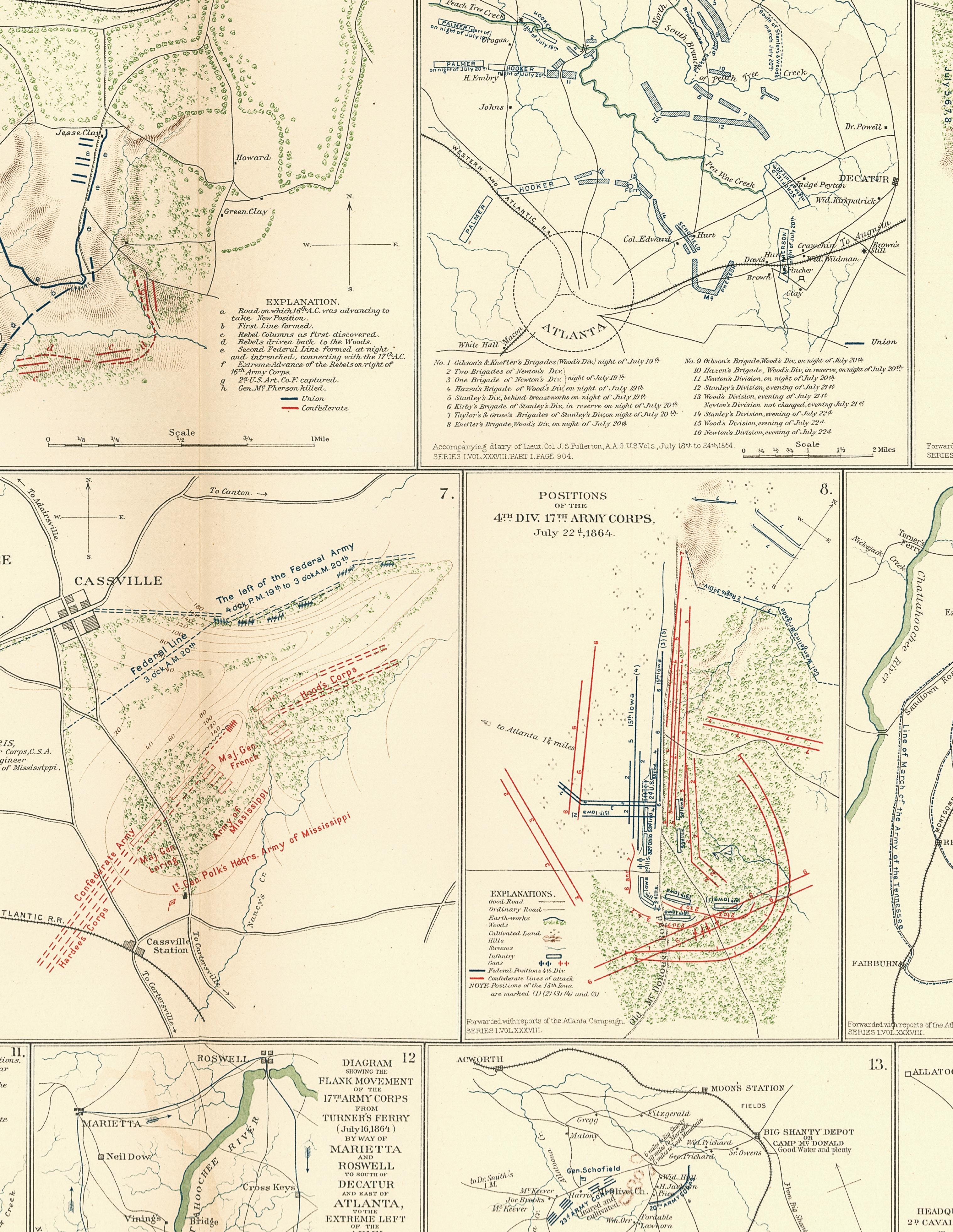
353 Wateree Swamp, Sumter County, South Carolina
354 Buffalo Bayou, Houston, Texas
355 Confederate siege lines, Mobile, Alabama
356 Jones Battery, Savannah, Georgia, siege lines
357 Adams Run, South Carolina
358 Poison Springs, Arkansas
359 Cero Gordo, Mexico (Mexican-American War)
360 Island #10, Tennessee
361 Tennessee River at Bridgeport, Alabama
362 Maryland Heights, Maryland
363 Kings Bridge (Savannah, Georgia area)
364 Bannerman’s
365 Hilton Head Island, South Carolina
366 Ralph Righton collection, Atlanta, Georgia
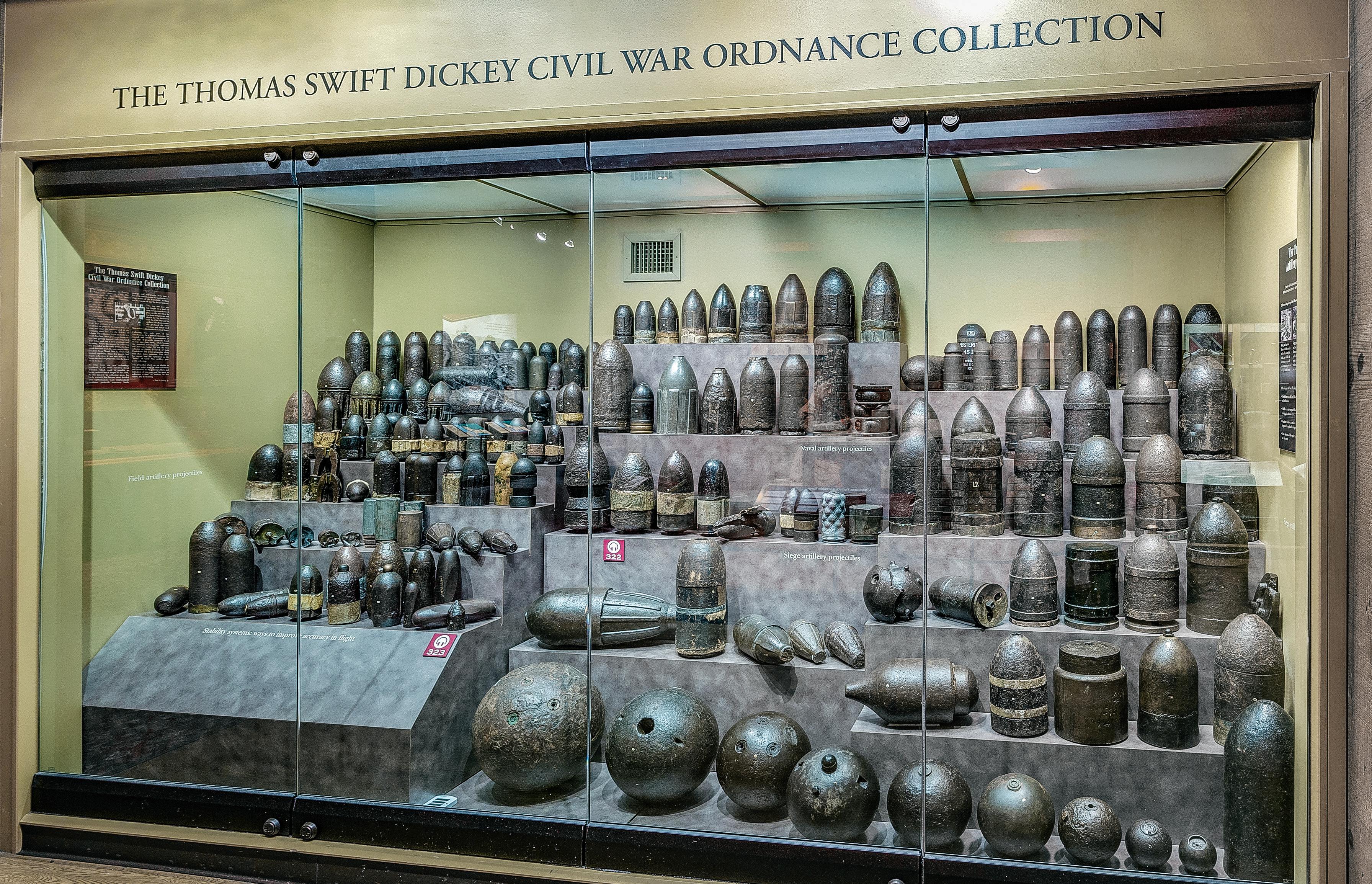
367 James Island, South Carolina
368 CSS Georgia in Savannah River, Georgia
369 Potter’s Landing below McClellanville, South Carolina
370 Fort Sumter, Charleston, South Carolina
371 Annapolis, Maryland
372 Washington Navy Yard, D.C.
373 Haiti
374 Long Island, South Carolina
375 Chancellorsville, Virginia
376 Fort Monroe, Virginia
377 Manassas, Virginia
378 Wilderness Battlefield, Virginia
379 Causton’s Bluff, Savannah Georgia
380 Tar Bluff, South Carolina
381 West End, Atlanta, Georgia
382 From Congaree River at Columbia, South Carolina
383 Near Glaze Foundry, Columbia, South Carolina
384 Fort at St. Mary’s, Georgia
385 Falmouth, Virginia (across river from Fredericksburg)
386 Southwest Atlanta, Georgia
387 Charleston, South Carolina
388 North Anna, Virginia
Dr. Gordon L. Jones is Senior Military Curator and Historian at the Atlanta History Center, where he has worked since 1991. See atlantahistorycenter.com for more information.
58
The Artilleryman
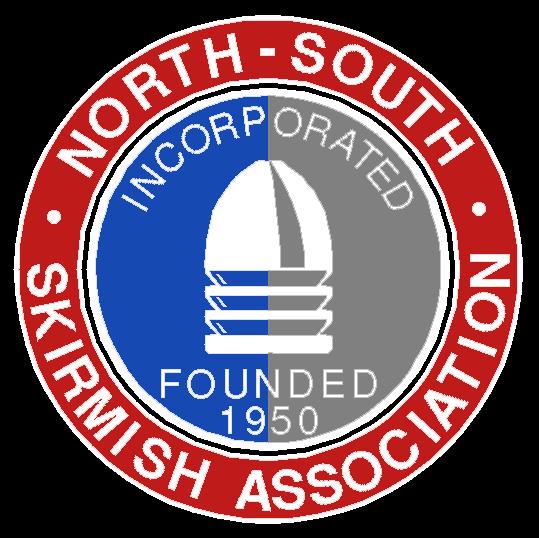

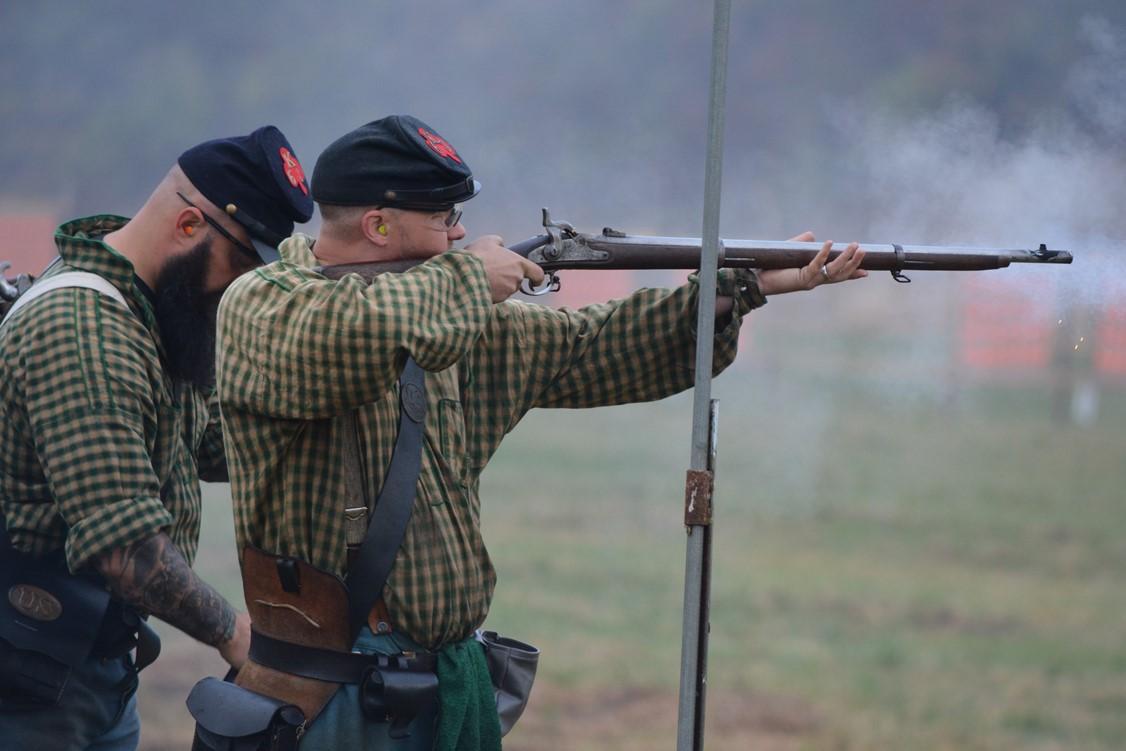

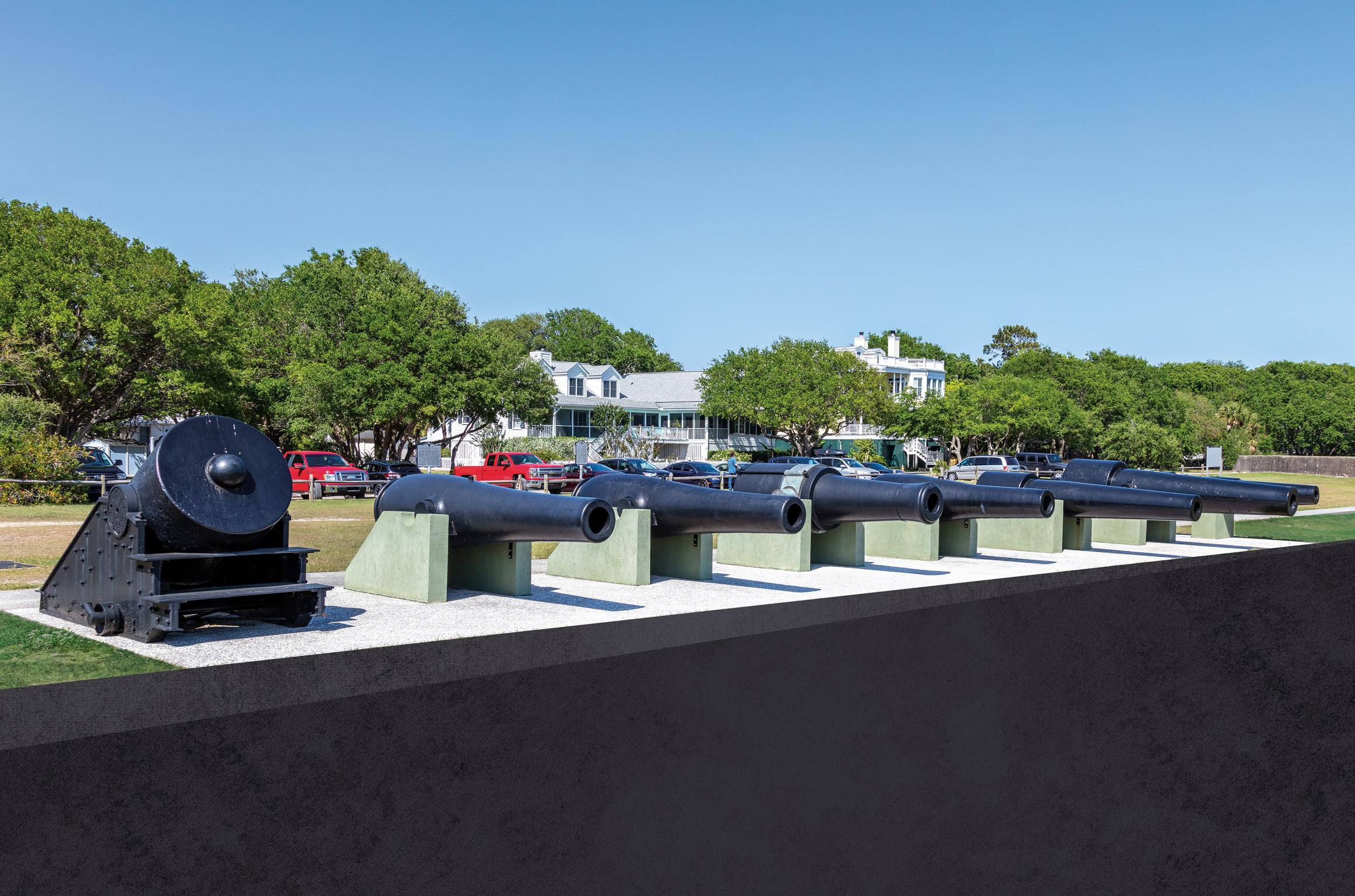

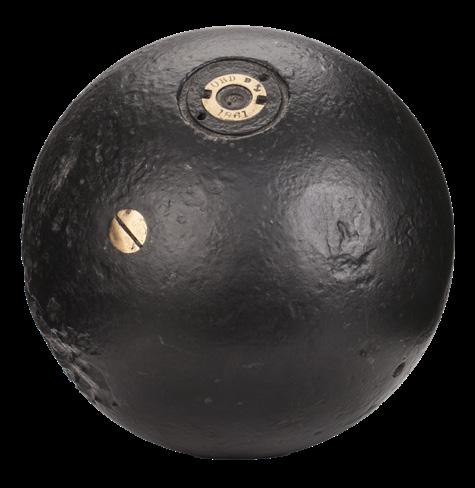


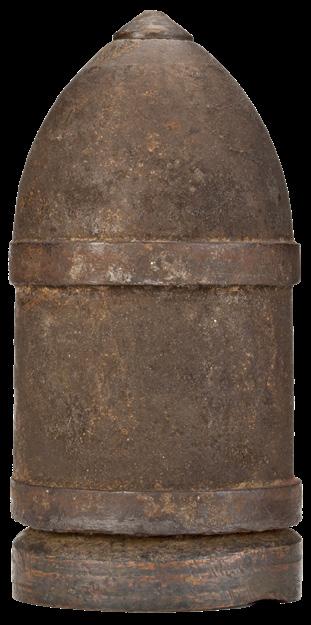
The N-SSA is America’s oldest and largest Civil War shooting sports organization. Competitors shoot original or approved reproduction muskets, carbines and revolvers at breakable targets in a timed match. Some units even compete with cannons and mortars. Each team represents a specific Civil War regiment or unit and wears the uniform they wore over 150 years ago. Dedicated to preserving our history, period firearms competition and the camaraderie of team sports with friends and family, the N-SSA may be just right for you. For more information visit us online at www.n-ssa.org. Contact Glenn Dutton at: glennjdutton@aol.com or 770-351-7565 Field & Heavy artillery Cannon, Shells, Fuses & Etc. & *(not these specfic cannon though) * ArtillerymanMagazine.com | Vol. 42, No. 1 59
by Yuriy Kirpichoff
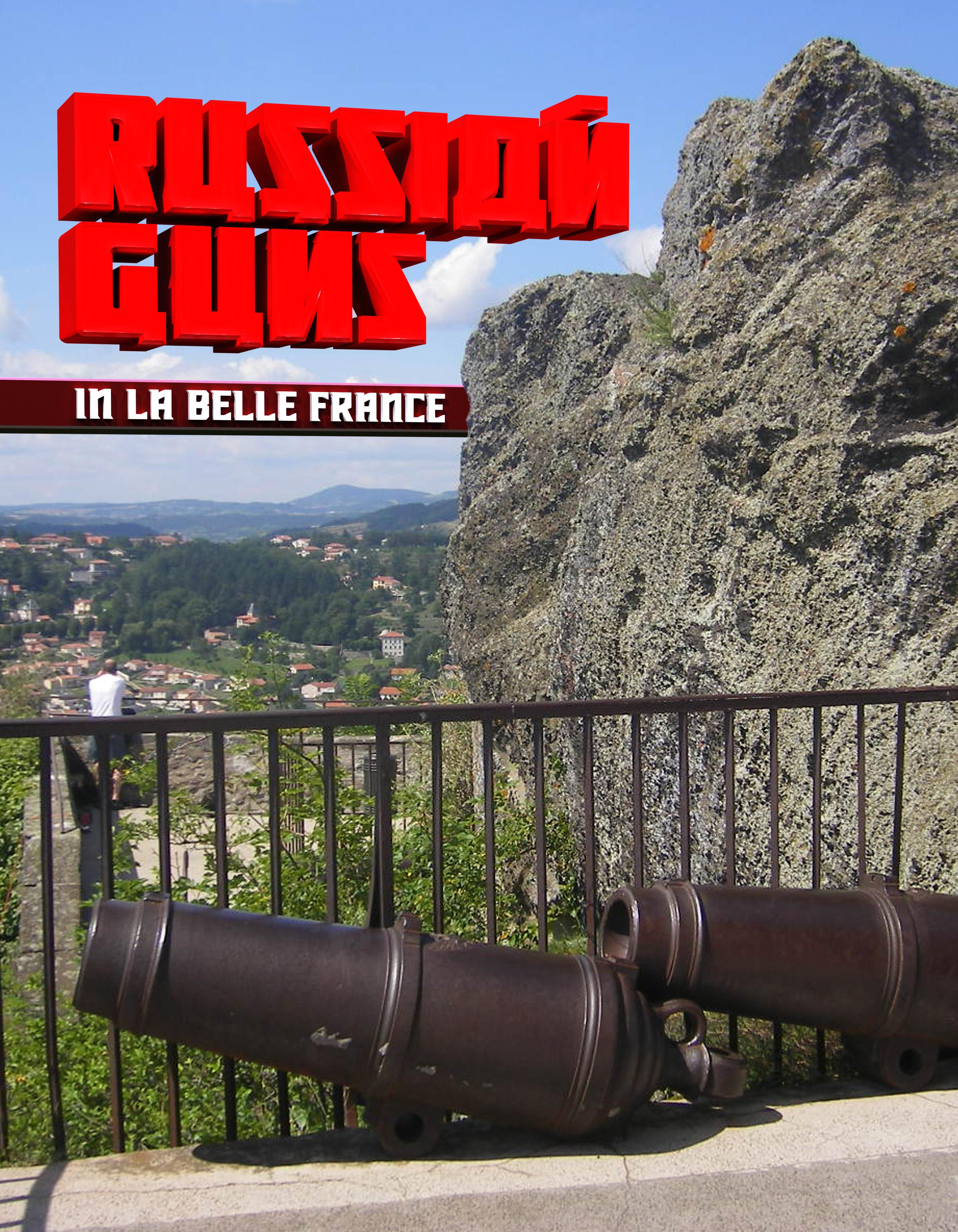 Russian carronades at the top of Corneille Rock.
Russian carronades at the top of Corneille Rock.
The Artilleryman published an article I wrote about Russian cannon in Canadian cities.1 These guns were British trophies of the Crimean War, when 4,000 guns were captured at Sebastopol. Britain received more than 2,000, 1,800 cast iron and hundreds of bronze guns.
It seemed that the difficulties of transporting guns potentially exceeded their value, financial or symbolic, and in February 1856, the British commander in the Crimea, Sir William Codrington, telegrammed for instructions from the Secretary of State for War, Lord Panmure. Codrington had already sent several trophy bells and bronze cannon home; they were expensive, these aristocrats of war, but were valued far more than plebeian cast-iron guns. He wanted to send more but was afraid of the difficulties and the delivery costs.
Panmure shared these concerns and offered to take the bronze and best cast-iron guns, then blow up the rest and sink the pieces in Sebastopol’s harbor. Prime Minister Lord Palmerston supported this proposal. In a telegram dated Feb. 25, 1856, Panmure, reporting on the course of the peace conference in Paris, added that the Queen wanted to see trophies and had already chosen a place for two large bells she liked.
Cannon, of course, are not as valuable as bells, but they are also expensive and very heavy trophies. The British sappers and gunners set to work; soon the first shipment, 406 guns, went to the arsenal in Woolwich. Trophies from the Baltic, Hanko, and Bomarsund were added to them.
Eventually, 1,079 cast-iron and 89 bronze cannon went to Britain from just the Crimea.2 While many guns adorned cities in England and Ireland, some were donated to the colonies as rewards for their part in the war effort.

They were good gifts. Cannon have always generated attention, even as they served as instruments for changing the world. The strength of an army
still depends on the number of guns; the price and brilliance of victory from time immemorial were determined by captured banners and guns. Ultima Ratio Regum, the last argument of kings, was cast on the cannon of Louis Quatorze, the Sun King, and this argument was weighty! The breadth of the western worldview was largely determined by this; if there weren’t whole broadsides of cannon on European ships, Western civilization probably would not have spread as far and as rapidly. It was the persuasiveness of the guns that projected the long-range action and worldwide coverage.
Their role is difficult to overestimate. Even outdated, even ancient, unsuitable for battle, they retain their value in patriotic and aesthetic terms. Inter arma silent Musae , when guns speak, the muses are silent; sometimes the guns by their decoration reached the level of works of art and became full-fledged museum exhibits. Cannon are also used aesthetically, by decorating a landscape, squares, and parks.
They are compact and beautiful, durable and mobile, require minimal maintenance, and were relatively inexpensive, having been captured.
Therefore, not all these instruments of war end up in a melting furnace. However, despite the large number of guns captured in Sebastopol, there are relatively few of them in England today, since Britain felt an urgent need for metal and the old guns were melted down, along with the fences of the royal palaces during World War II.
Madonna in Le Puy-en-Velay
Some guns were handed over to Sardinia, a Crimean War coalition ally. This kingdom received 200 cast-iron guns. Britain later added several bronze cannon to the gift. The Turks also got something. France received some 2,000 cannon, but they are not on Sebastopol Boulevard in Paris, named after the victory in the
ArtillerymanMagazine.com | Vol. 42, No. 1 61
Visitor taking a rest break on the way to the top.
Crimean War. In France, the Russian guns found a different use, an unusual example of cannon recycling. It was a very successful solution with the subsequent transformation of the deadly guns into a real work of art; moreover this creation is exceptionally peaceful, appealing to the gentlest feelings.
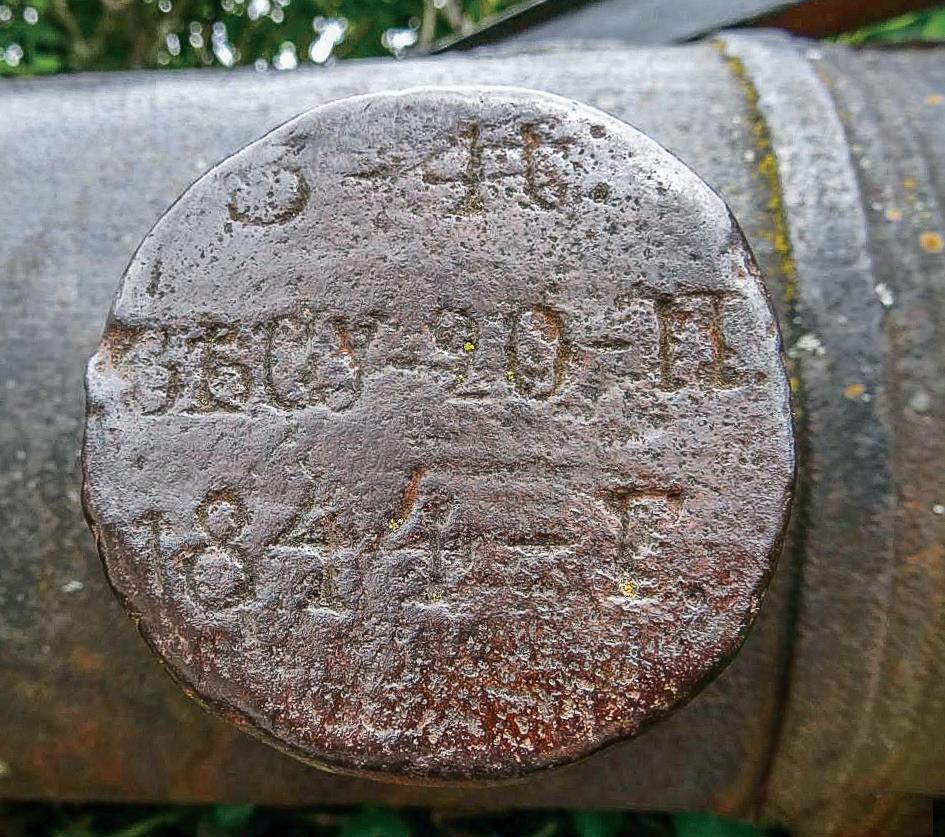
The dominant feature of Le Puyen-Velay in picturesque Auvergne is the statue of Notre Dame de France. For the 110-ton statue and its 680-ton
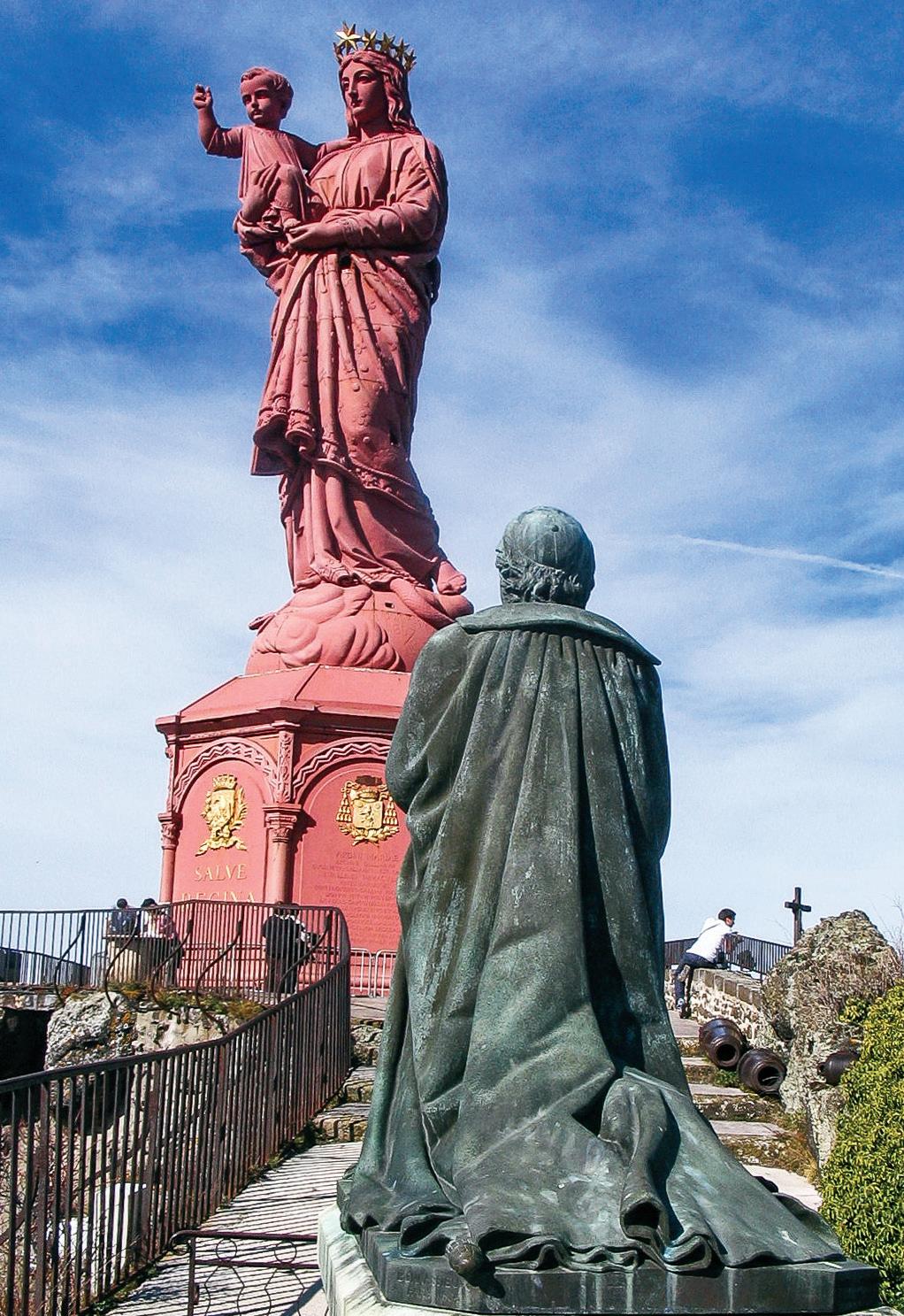
pedestal, more than two hundred cannon were required. It remained the largest statue in the world until the Statue of Liberty was erected in 1886. The figure standing on a high, steep rock is quite large to look proportionate against the backdrop of powerful nature. The statue stands 22.7 meters tall, and is visible from anywhere in town. Inside there is a spiral staircase leading to the head, and there, as well as on the way up, there are viewing windows.
This monumental Madonna was inaugurated on Sept. 12, 1860. The statue is interesting not only in size and its undeniable artistic merits, but in the material from which it is made. The sculptor Jean-Marie Bonnassieux cast his Madonna using metal from 213 Russian cannon taken by the Allies on the battlefields near Alma, Balaklava, Kerch, and, of course, Sebastopol. The statue is beautiful, but cast iron is black and gloomy, an inappropriate color for the Madonna. Therefore, it was painted dark pink, in harmony with the color of tiled roofs and spring flowering gardens. The road to it is not easy and other old cannon lying along the path turn out to be very useful. You can sit on them, take a breath and, as a result, they are polished to a glow.
Land and sea guns of large caliber, 18, 24, 36, and 68-pdrs, capable of opposing the fire of the European siege guns were installed on the terrepleins of Sebastopol’s bastions. They were very heavy, from 2 to 3.5 tons, so there was more than enough metal for the statue. The French founders made some of the monument’s detailing from smaller guns.
The road to the Big Lady is decorated with lighter cannon. Twenty Russian poods (about 328 kg) are indicated on the trunnion of one cannon; this is a light 3-pdr. field gun. Other, larger guns are completely trunnion-free; these are carronades, naval guns for close combat. They are large-caliber, but short-barreled with thin barrel walls, so they were not too
Statue de Notre-Dame de France.
The
62
Trunnion markings on a Russian 3-pounder gun.
Artilleryman
heavy, but fired very heavy projectiles for their weight.
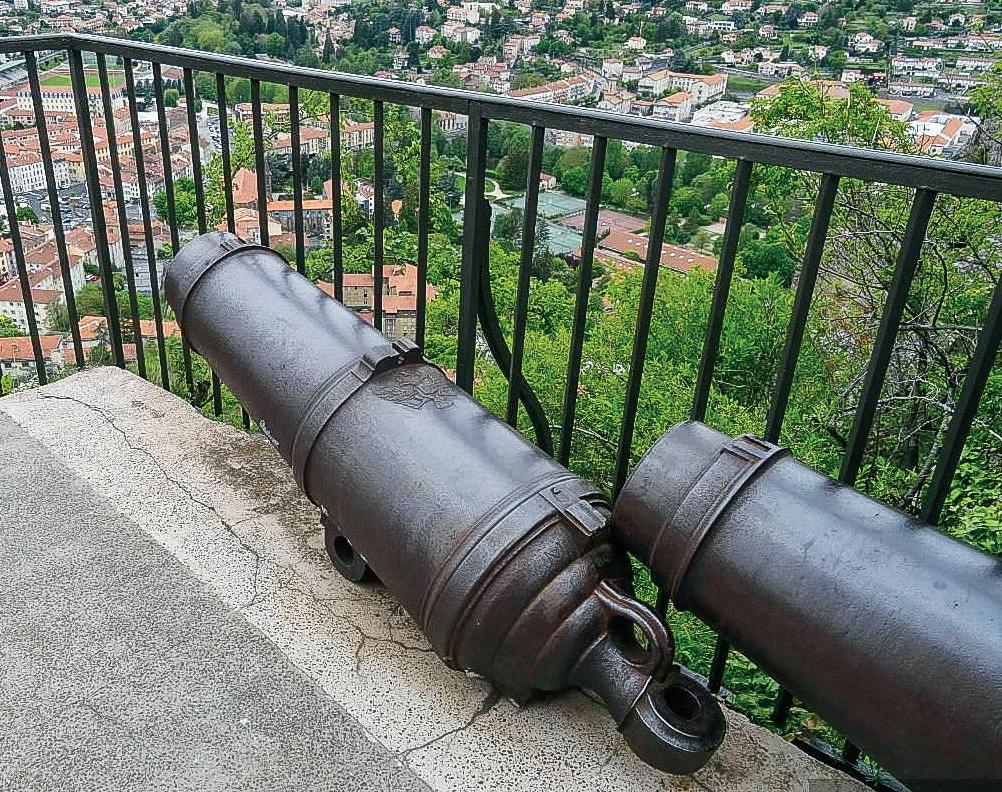
The pink Madonna was completely renovated in 2013. She stands on the town’s highest point, the volcanic Corneille Rock, at an altitude of 757 meters. The site provides an exceptional panorama over the cathedral, the old town, and the entire region. The instruments of death have become a symbol of eternal life and attract many visitors. Before the coronavirus pandemic, the statue was visited by 80,000–90,0000 tourists a year.

Sources:
1. The Russian Cannon of Canada. By Yuriy Kirpichoff. The Artilleryman, Fall 2017, Vol. 38, No. 4.
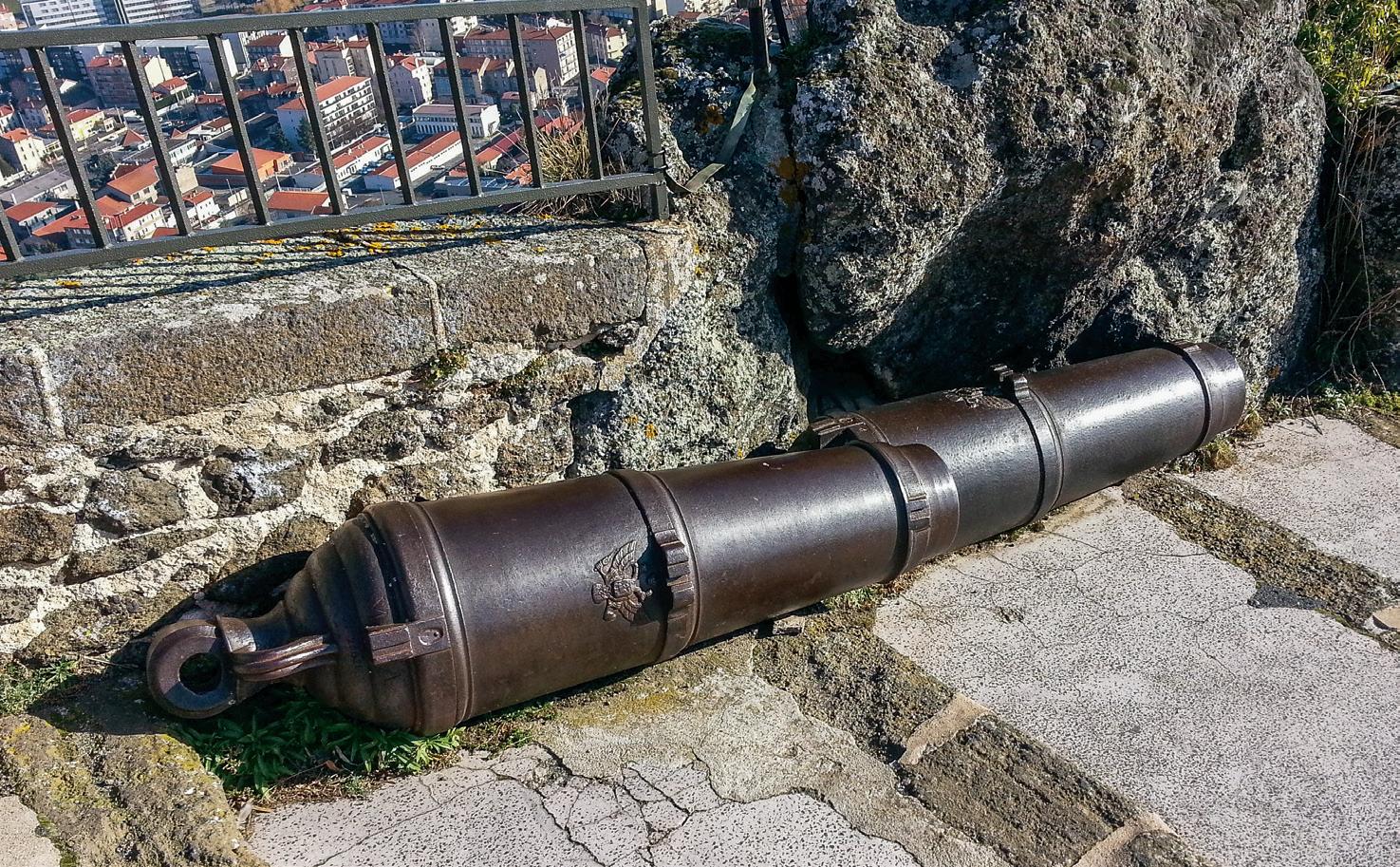
2. The Times, May 13, 1858, p. 12.
Yuriy Kyrpychov, born in 1952, Ukraine, a radiophysicist, worked as the General Director of the Production Association. He now lives in the U.S., and began publishing in newspapers and magazines in the U.S., Canada, Russia, and Ukraine as a novelist, publicist, and historian. He is a popular author, especially in naval history, and published on the website of the Russian Navy FLOT.com.
Above and left: Carronades with twoheaded eagles cast behind the center band.
ArtillerymanMagazine.com | Vol. 42, No. 1 63
A 3-pounder Russian cannon mounted in a carved out rock formation.
All Hands on Deck!

1. Traveling Forge for sale. IN STOCK, One of only a few in existence, ready for pickup. Made with removable side to see the workings of the Bellows. The crown jewel of any battery collection! $25,000 call for pictures.
2. Scale Steel CS Mortar, 3-inch Bore on wooden bed: $400 delivered
3. 12-Pdr. Steel Mountain Howitzer, bronzed barrel on carriage with implements: $9,000
4. Steel 12-Pdr.Mortar on stained wooden bed: $1,800
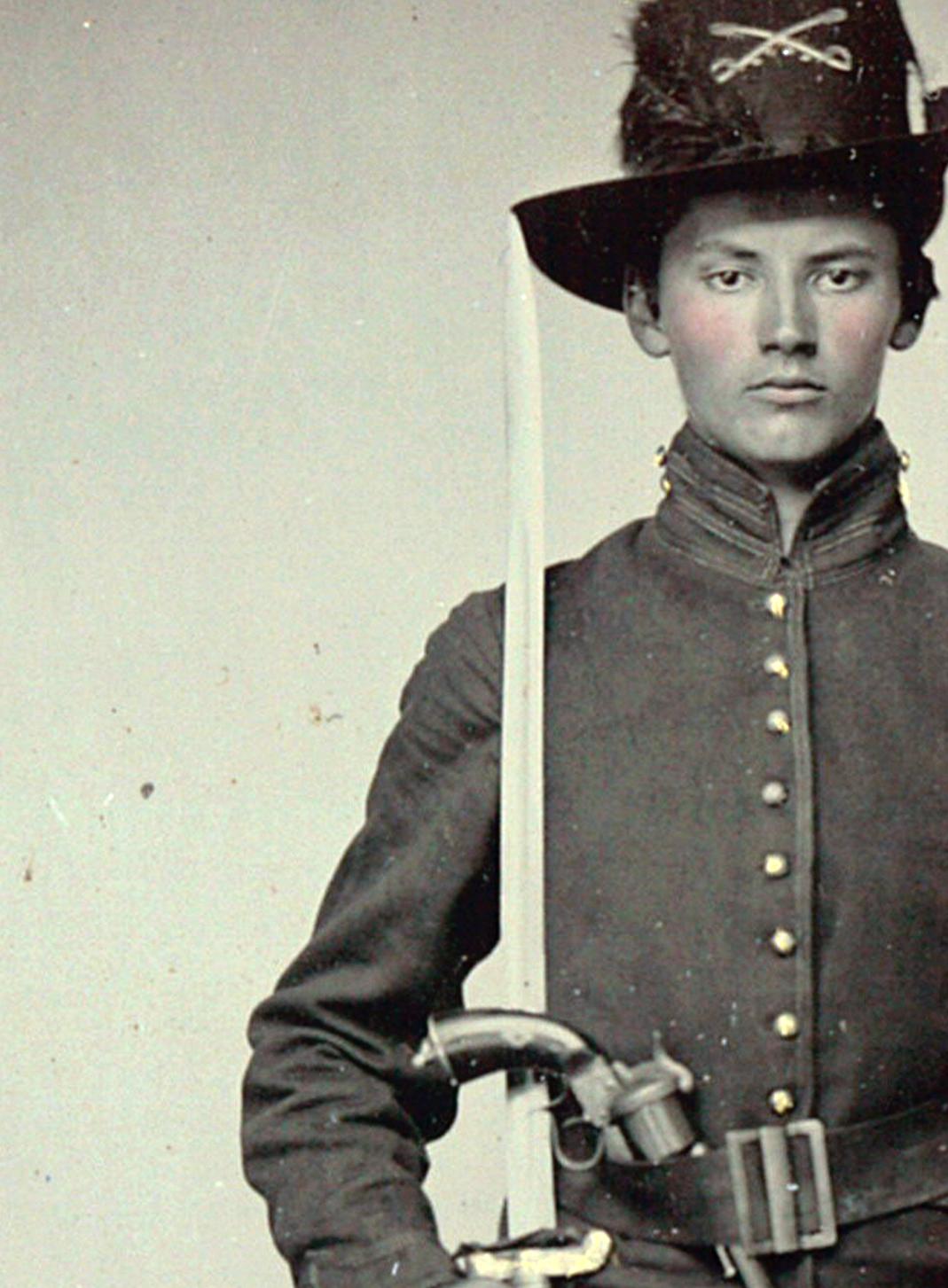
5. 6-Pdr. Solid Shot, Zinc: $15
6. CS Steel 12-Pdr. Mortar on oak bed, new: $1,600
7. Caisson, used excellent condition complete with boxes and spare wheel: $11,000
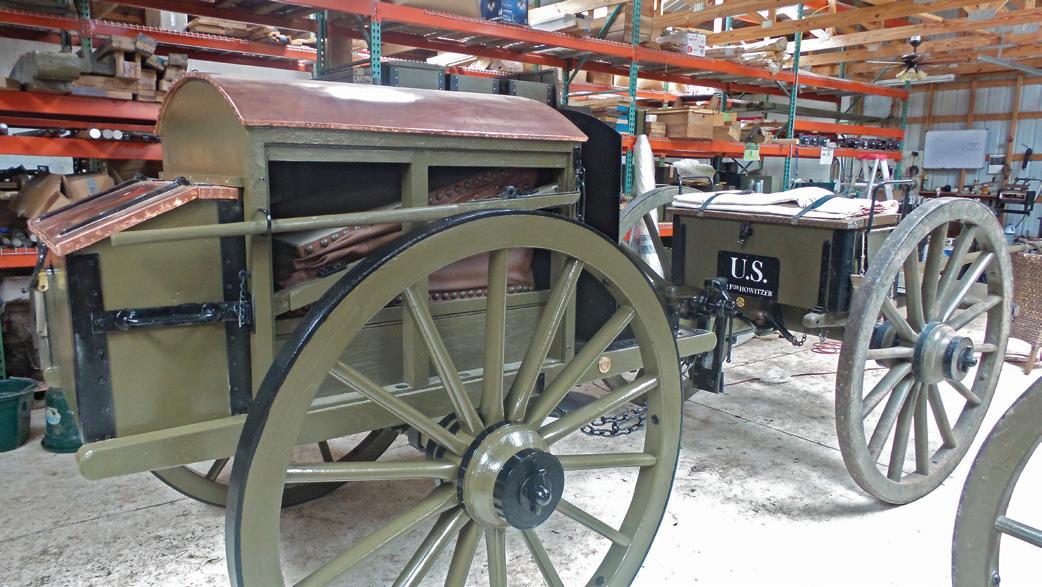
8. Blakely Split trail carriage, Excellent/New Condition, 50" Wheels: $7,000
9. 1st Model Prairie Carriage New in Stock: $5,000
10. 32-Pdr. Steel Shot Have 2 tons! $60 each
11. Steel Cannonballs 1", 1.25", 1.5", 2", 2.9", 6-Pdr., 12-Pdr., 24-Pdr., 32-Pdr. by the ton. 12. 10-Pdr. Parrott used VG condition SBR rifled tube on new #1 Field Carriage: $14,500
Support Our Mission to Bring You the Naval History “This is the magazine for all things Civil War Navy. From ‘Uncle Sam’s web-feet’ to the ‘grey jacket navy’ raised by Jeff Davis! It is all here thoroughly researched and illustrated by beautiful contemporary navy images.” Ron Field, military historian and author of over 45 books, including Bluejackets: Uniforms of the United States Navy in the Civil War Period, 1852-1865. 1 Year—4 Issues: $37.95 Subscribe Now at civilwarnavy.com Or send a check to: CSA Media, 808 Drayton St., Savannah, GA 31401 International subscriptions subject to postage surcharge. Sailors and Marines on the deck of the U.S. gunboat Mendota, 1864. National Archives (Identifier 524548). MI Since 1979 Military Images magazine Showcase. Interpret. Preserve. MilitaryImagesMagazine.com | Facebook.com/MilitaryImages America’s only publication dedicated to historic photographs of soldiers and sailors. Or send a check payable to: Military Images PO Box 50171 Arlington, VA 22205 Subscribe online: MilitaryImagesMagazine.com SUBSCRIBE NOW 4 quarterly issues, $24.95
Artillery Goodies For Sale Trail Rock Ordnance 1754 Little Valley Rd • Blaine TN 37709 • 865-932-1200 • Akm556@aol.com www.trailrockordnance.com Call or email for more details and pictures.
By Jack W. Melton Jr.
A Look Inside Civil War Artillery Projectiles
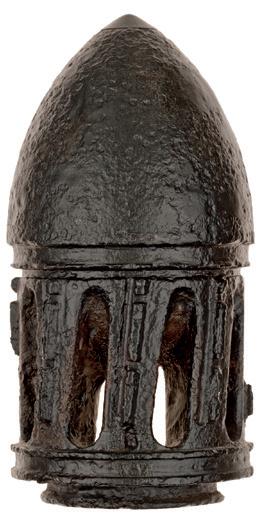

"Through Jack’s superb photography; the collector and professional can now view an extensive exposure to sectioned projectiles. This is new for the average person in that for the first time since radiography; one can examine the internal makeup of a shell."
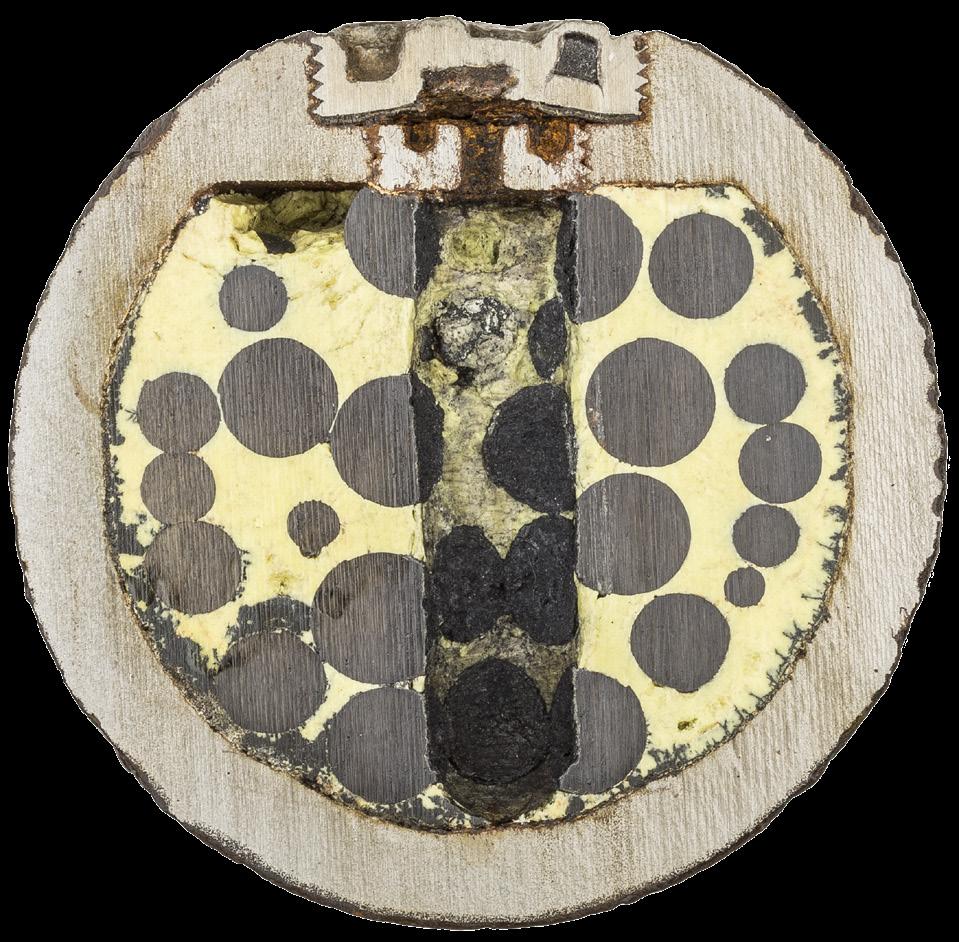
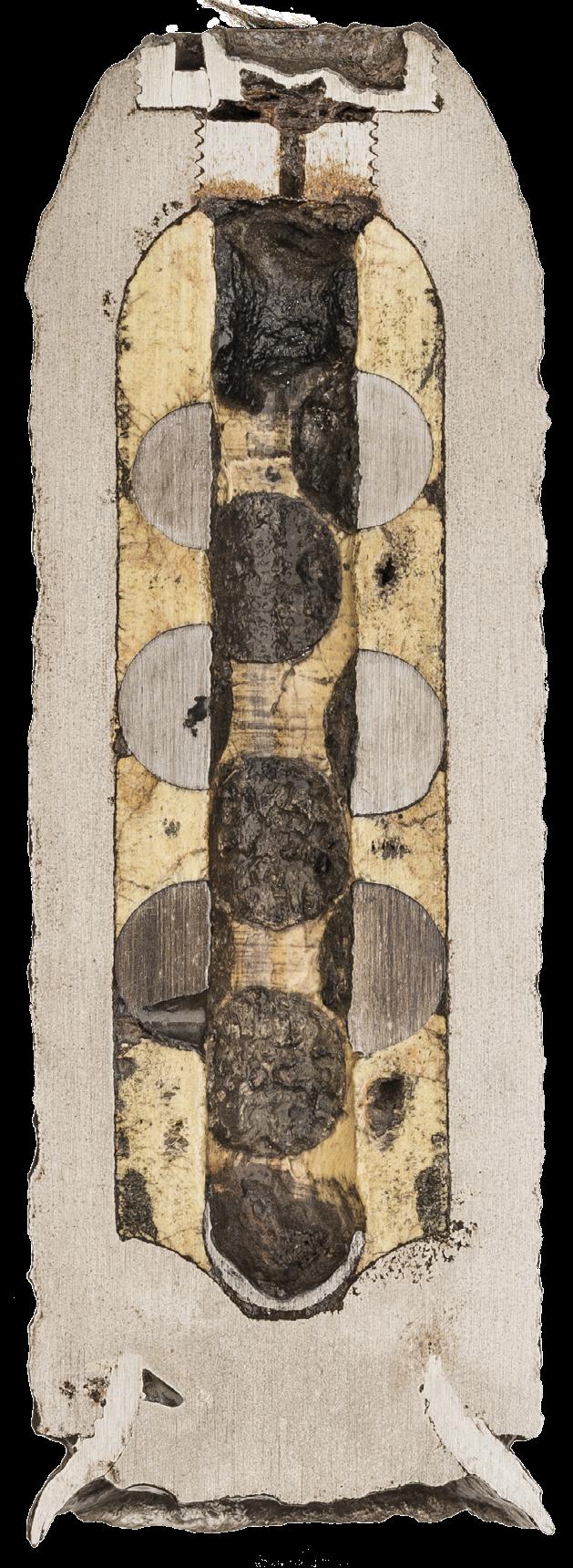
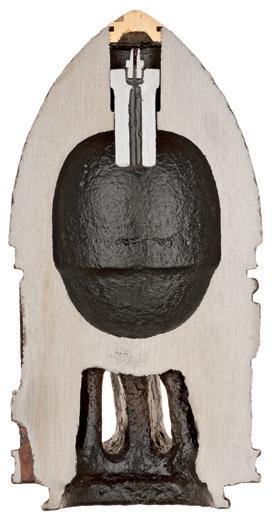
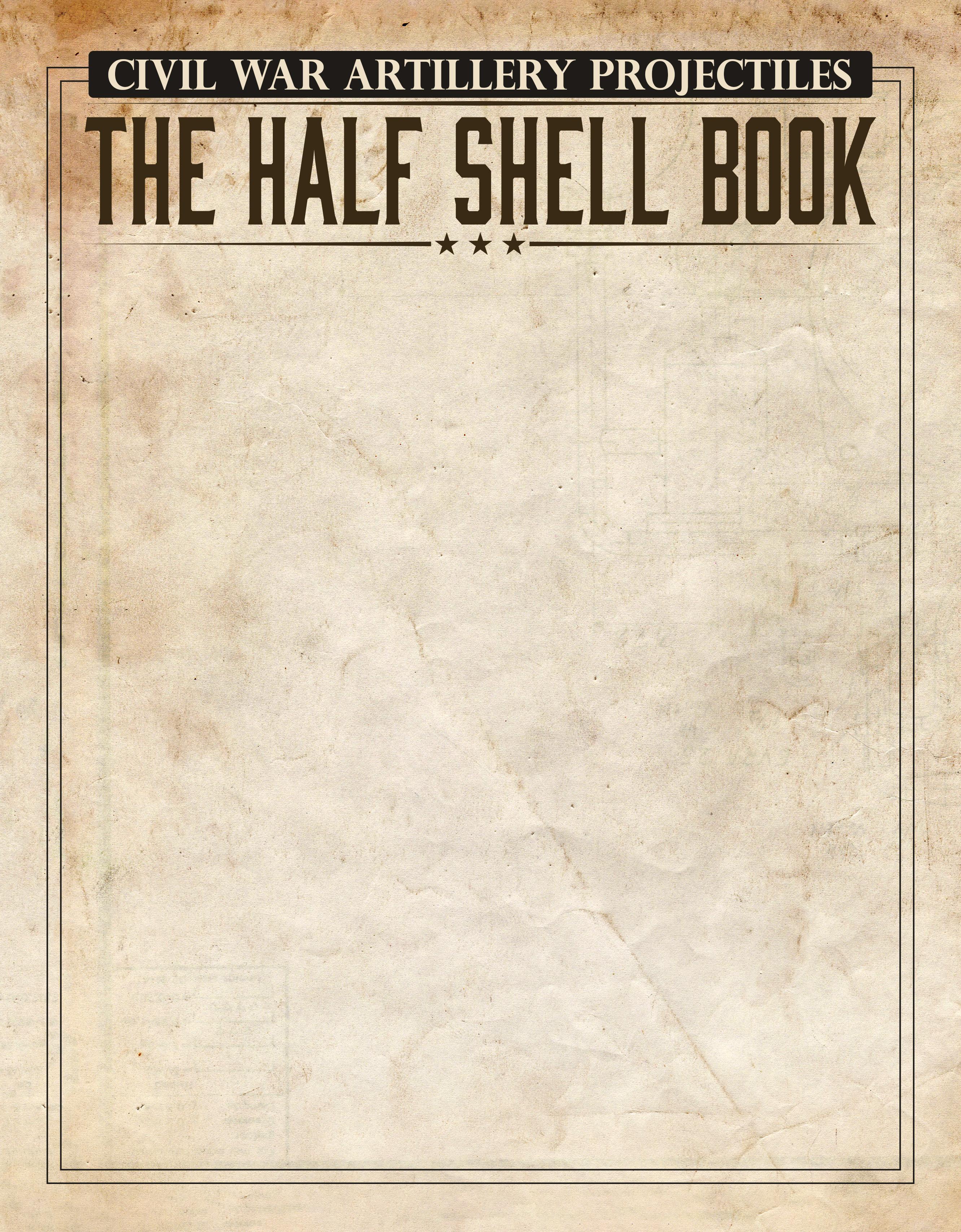
CWO4 John D. Bartleson Jr., U.S. Navy EOD
Author of Civil War Explosive Ordnance 1861–1865

6-PounderSphericalCaseShot
Confederate
Theexpedienttriedbytheconfederatesinimitationof ourprojectiles,(andoccasionallyusedbyourownmen,)of mixingmusketbulletswiththeburstingchargeof
wasentirelyfutilefromwantof weightinthebullets.
Inthisexample,riflebulletswereutilizedasthecaseshotmaterialincluding3-ring.58caliberbullets,3-ring.69caliberbul lets,andU.S.ring-tailSharpsbullets.IthasabrassBormannsupportplug(underplug)thatiscountersunkonbothsidesof
flame’scommunicationchannel.Theblackpowderburstingchargewaspouredinloosearoundthebullets.Thismethoddid notworkverywellandoftenonlysucceededinblowingthefusesout.Projectilesfilledwithbulletsusedascaseshotarerare. Thisspecimenwasrecovered,alongwithotherConfederateandUnionprojectiles,fromthepost-CivilWardumpsitelocated neartheConfederatePowderWorksinAugusta,Georgia.
• 392 pages of full color photographs with descriptions
• Covers projectiles, fuses, canister, grapeshot and more


• 850 photos, drawings, radiographs, patents and maps
• A must for every serious artillery enthusiast
$89.95 for the Standard Edition • $175 for the Deluxe Limited Edition
(9 left) Published by Historical Publications LLC
Order your copy at: www.ArtillerymanMagazine.com
Hidden Evidence
–
74
ChapterThree
SphericalHalfShells
the
Diameter: 3.58 inches Bore Diameter: 3.67 inches Gun: 6-pounderSmoothbore Weight:5.2poundsConstruction: Case shot Fusing System:Time,Bormann Fusing Material:LeadandtinalloyFuse Thread Diameter: 1.65 inches Fuse Hole Length:.75 inch Sabot: Cup Sabot Material: Wood Wall Thickness: .31 inch Matrix Material: None Case Shot Material: Lead Case Shot Diameter: Varied calibers Bormann time fuse Brass supportplug Sharpsring tail bullet Horseshoe powdertrain
smallshells,
259 Civil War Artillery Projectiles – The Half Shell Book Federal 3.8-Inch James Type I Shell Diameter: 3.72 inchesBore Diameter: 3.80 inches Gun: 14-pounder James Rifle Length 6.75 inches Weight: 10.0 pounds Construction: ShellFusing System: Percussion, James Fusing Material: Brass Fuse Thread Diameter: .90 inch Fuse Hole Length: 1.56 inches Sabot: Ring or band, lead (missing) Sabot Height-Width: 2.62 inches Wall Thickness: .62 inch Matrix Material: N/ACase Shot Material: N/A chargeBursting cavity Anvil cap Zinc plunger Iron nipple Fuse powder train Ring base The James percussion fuse consists of a bronze anvil cap with a zinc plunger fitted with a nipple. Both are smaller in diameter than the James percussion fuse on the previous page. This sub-pattern is commonly called a tie-ring James due to the visible ring extending below the base of the projectile body. The visible small notches, located in the raised portion of the projectile’s ribbed body, were developed in an attempt to improve the chances of the lead sabot remaining attached to the projectile body during firing. This pattern James projectile is less common than the flat based James projectile. James percussion fuse
–GeneralHenryL.Abbot
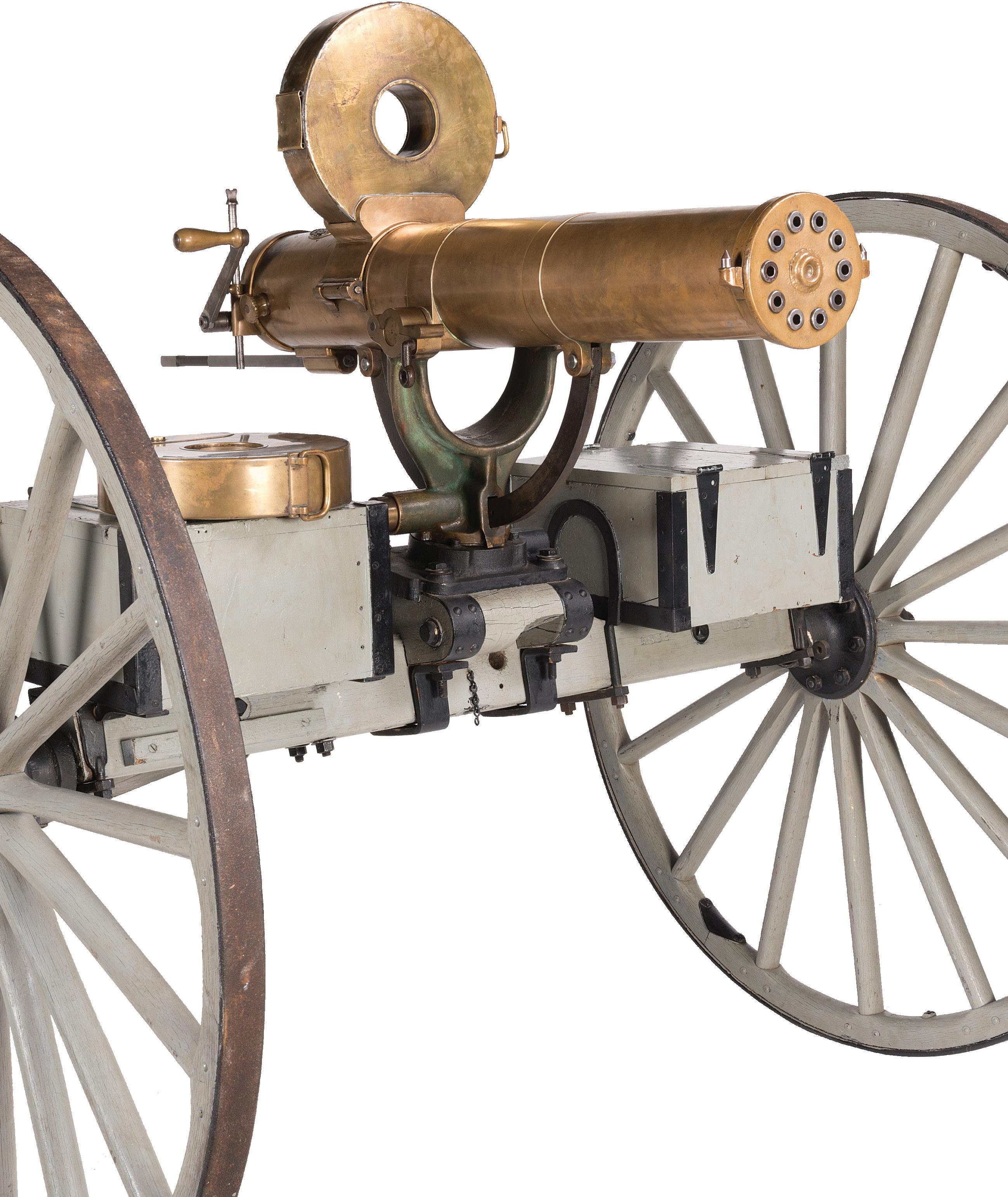
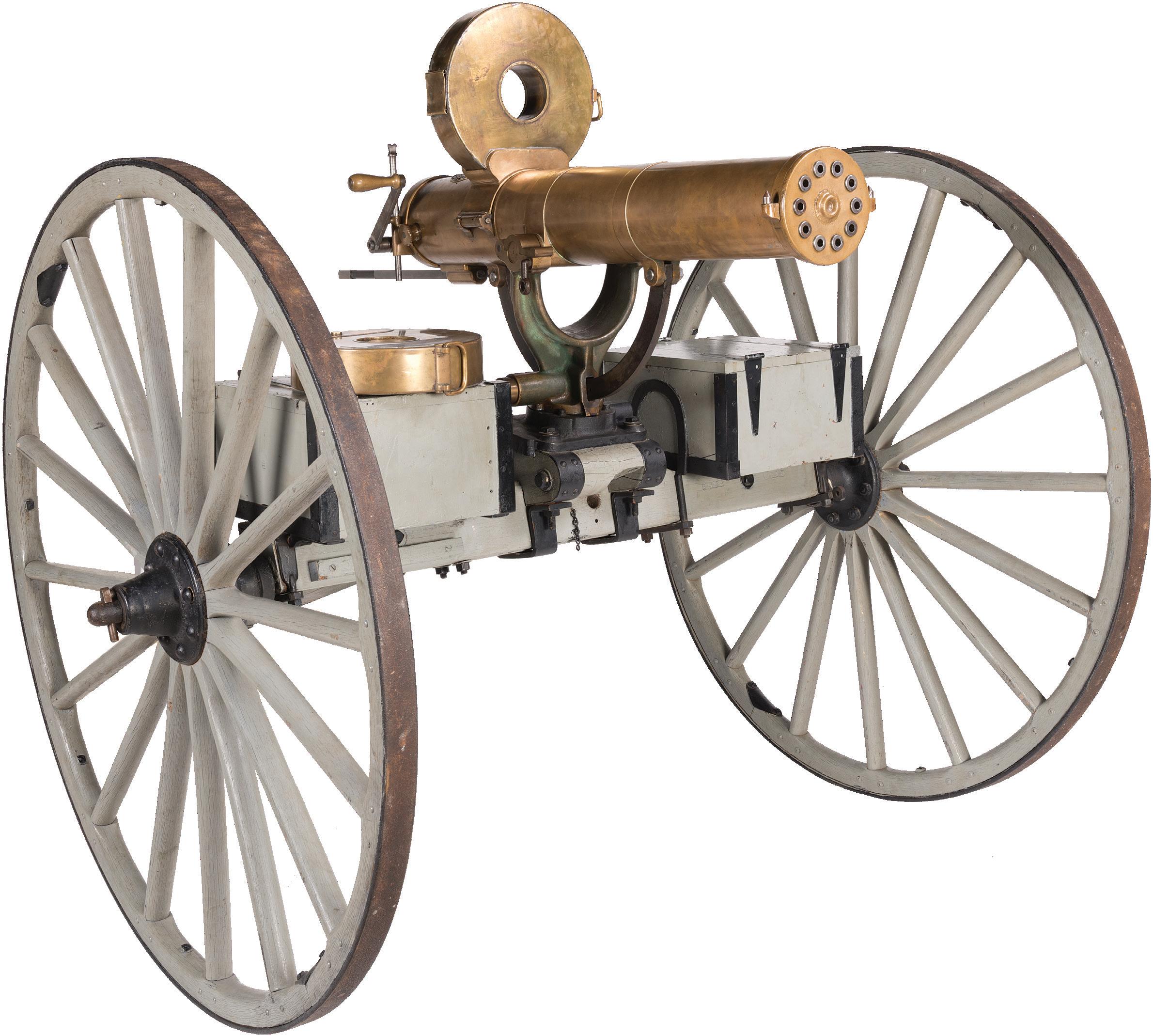



REAL HISTORY Premier Auction REAL ART ∙ ∙ REAL IRON Fine, Historic, & Investment Grade Firearms ROCK ISLAND AUCTION COMPANY December 4TH, 5TH & 6TH ® WWW.ROCKISLANDAUCTION.COM 7819 42nd Street West, Rock Island, IL 61201 ∙ Phone: 309-797-1500 ∙ Fax: 309-797-1655 ∙ Email: info@rockislandauction.com ∙ Fully Licensed Class III Auctioneer Collectable and Antique Firearms 800-238-8022 or Email: guns@rockislandauction.com RIAC IS ALWAYS ACCEPTING QUALITY CONSIGNMENTS - ONE CANNON OR AN ENTIRE COLLECTION! CATALOG ONLINE NOW! 3 Day live public auction To Order Your Full-Color 3-Volume Set Catalog Call (800) 238-8022 ($70 plus sales tax) OVER $1.3 MILLION IN SALES OF ARTILLERY PIECES FOR 2019!
 Vol. 42, No. 1 Winter 2020 $8.00
Macon Arsenal 10-Pounder Parrott Rifle: The Search for Its Battery • Rifled Artillery Against Fort Pulaski
French Swiss Guard Regiment 6-Pounder Gun • The Tom Dickey Collection
Russian Guns in La Belle France • Confederate Dahlgren Shells
Vol. 42, No. 1 Winter 2020 $8.00
Macon Arsenal 10-Pounder Parrott Rifle: The Search for Its Battery • Rifled Artillery Against Fort Pulaski
French Swiss Guard Regiment 6-Pounder Gun • The Tom Dickey Collection
Russian Guns in La Belle France • Confederate Dahlgren Shells





















 by Jack W. Melton Jr.
by Jack W. Melton Jr.


































 Gen. Joseph K.F. Mansfield. NARA-528442.
Col. Charles H. Olmsted.
Alexander R. Lawton. Library of Congress.
Brig. Gen. Joseph G. Totten, Chief, Corps of Engineers. Library of Congress.
Maj. Gen. David Hunter. Library of Congress.
Gen. Joseph K.F. Mansfield. NARA-528442.
Col. Charles H. Olmsted.
Alexander R. Lawton. Library of Congress.
Brig. Gen. Joseph G. Totten, Chief, Corps of Engineers. Library of Congress.
Maj. Gen. David Hunter. Library of Congress.

 Robert Parker Parrott, inventor of the Parrott rifle, fuse, and projectile.
Robert Parker Parrott, inventor of the Parrott rifle, fuse, and projectile.


































 M270 Multiple Launch Rocket System in position.
Exhibits Specialist Zane Mohler applying lettering to 155 mm projectiles.
M109A6 Paladin just before moving inside. Exhibits Specialist Zane Mohler provides a sense of scale.
M10 Ammo Trailer and M41 crew loading a projectile in Korean War Diorama.
M270 Multiple Launch Rocket System in position.
Exhibits Specialist Zane Mohler applying lettering to 155 mm projectiles.
M109A6 Paladin just before moving inside. Exhibits Specialist Zane Mohler provides a sense of scale.
M10 Ammo Trailer and M41 crew loading a projectile in Korean War Diorama.










 “E. T.”
Angled views of the Macon Arsenal 10-pdr. Parrott rifle with a priming wire inserted in the gun’s vent. Both trunnions are unmarked.
Side view of the rifle’s muzzle, showing the mold seam that indicates time was not wasted on turning the whole tube on the lathe, but rather only the area of the breech where the reinforcement band was shrunk on, and the trunnions.
“E. T.”
Angled views of the Macon Arsenal 10-pdr. Parrott rifle with a priming wire inserted in the gun’s vent. Both trunnions are unmarked.
Side view of the rifle’s muzzle, showing the mold seam that indicates time was not wasted on turning the whole tube on the lathe, but rather only the area of the breech where the reinforcement band was shrunk on, and the trunnions.


 Master Distributor for GOEX POWDERS
Master Distributor for GOEX POWDERS








 Angled view of the hilt illustrating the beautiful craftsmanship of Tiffany & Co.
Presentation engraving on the scabbard
Angled view of the hilt illustrating the beautiful craftsmanship of Tiffany & Co.
Presentation engraving on the scabbard



 & Co. etching on blade.
& Co. etching on blade.

 Tiffany marking on the scabbard.
Detailed view of the presentation sword’s hilt and blade.
Tiffany marking on the scabbard.
Detailed view of the presentation sword’s hilt and blade.
 by Becky Coffield
Officer of the Royal French Swiss Guard Regiment.
by Becky Coffield
Officer of the Royal French Swiss Guard Regiment.



 Top of the tube with Ultima Ratio Regum, its name, Le Cho, and Louis Charles de Bourbon, Comte d’Eu.
Top of the tube with Coat of Arms of Louis Charles de Bourbon, Grand Master of the Artillery of France and commander of the Swiss Guard Regiment.
Top of the tube with Ultima Ratio Regum, its name, Le Cho, and Louis Charles de Bourbon, Comte d’Eu.
Top of the tube with Coat of Arms of Louis Charles de Bourbon, Grand Master of the Artillery of France and commander of the Swiss Guard Regiment.


 Front view of the Swiss Guard 6-pdr. gun.
Louis Charles de Bourbon (1705–1775).
Front view of the Swiss Guard 6-pdr. gun.
Louis Charles de Bourbon (1705–1775).


 Right trunnion markings.
Expand view of the top of the tube with Ultima Ratio Regum, its name, and Louis Charles de Bourbon, Comte d’Eu, and crest.
Right trunnion markings.
Expand view of the top of the tube with Ultima Ratio Regum, its name, and Louis Charles de Bourbon, Comte d’Eu, and crest.



 by Dr. Gordon L. Jones, Atlanta History Center, and the editors of The Artilleryman
by Dr. Gordon L. Jones, Atlanta History Center, and the editors of The Artilleryman
























 Russian carronades at the top of Corneille Rock.
Russian carronades at the top of Corneille Rock.


















